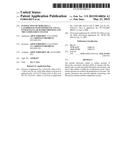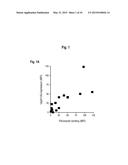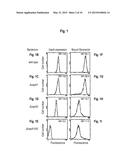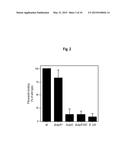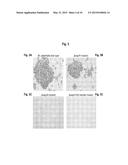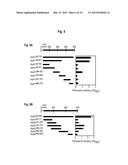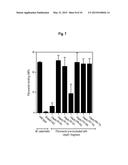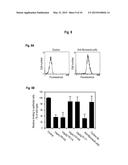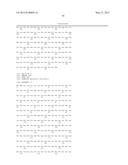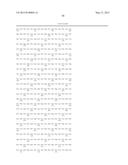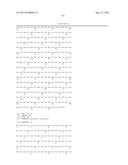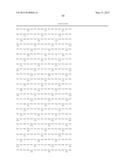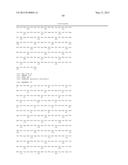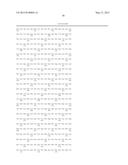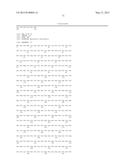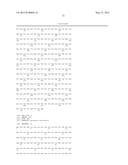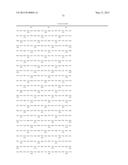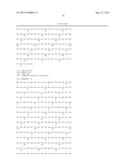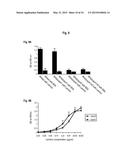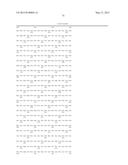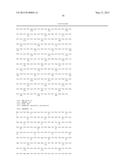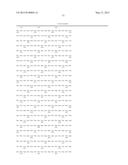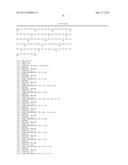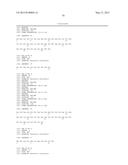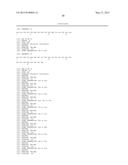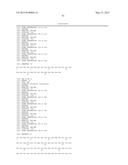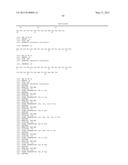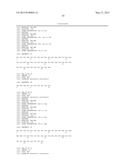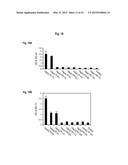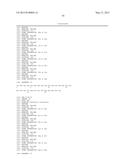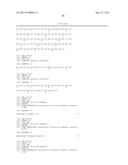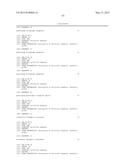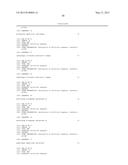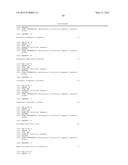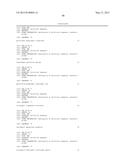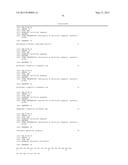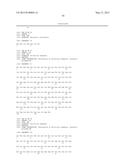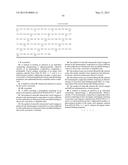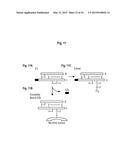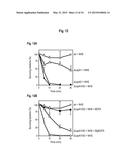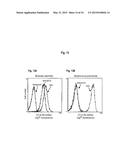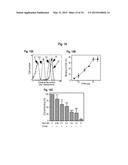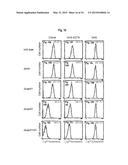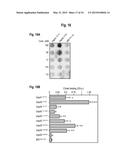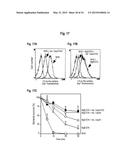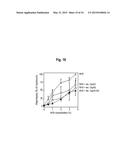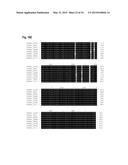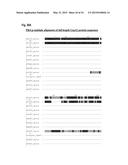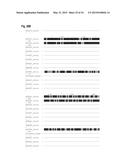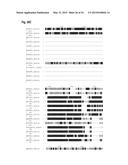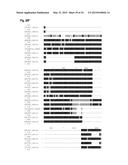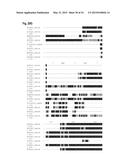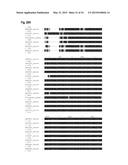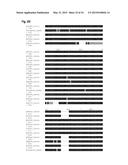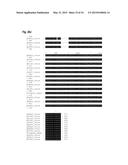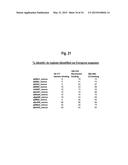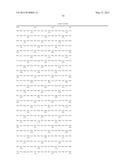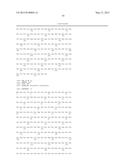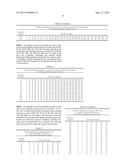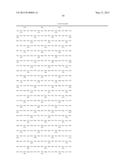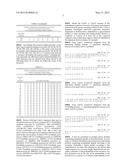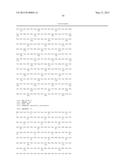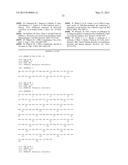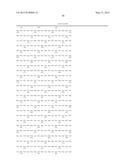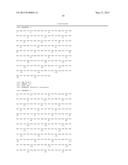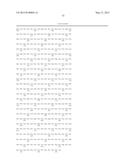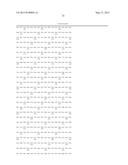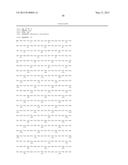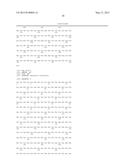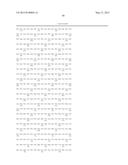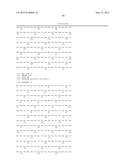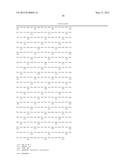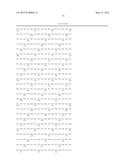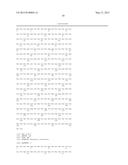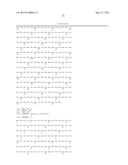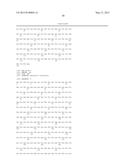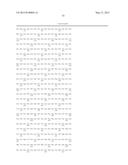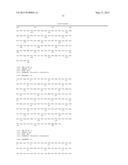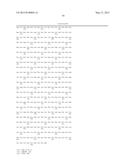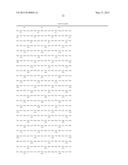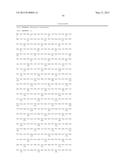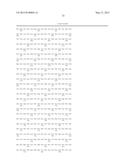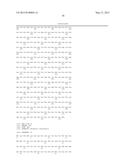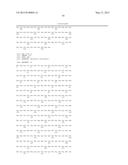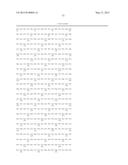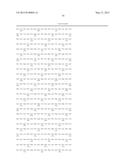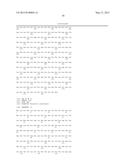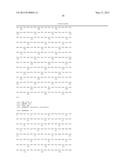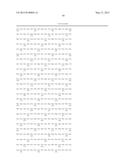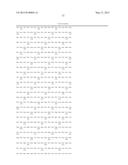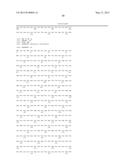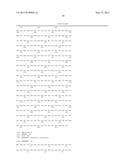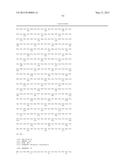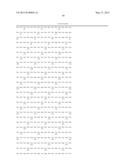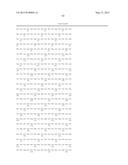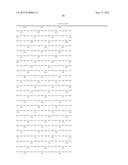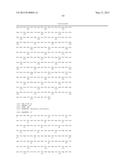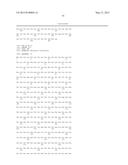Patent application title: INTERACTION OF MORAXELLA CATARRHALIS WITH EPITHELIAL CELLS, EXTRACELLULAR MATRIX PROTEINS AND THE COMPLEMENT SYSTEM
Inventors:
Arne Forsgren (Falsterbo, SE)
Arne Forsgren (Falsterbo, SE)
Kristian Riesbeck (Malmo, SE)
Kristian Riesbeck (Malmo, SE)
Assignees:
ARNE FORSGREN AB
IPC8 Class: AC07K1421FI
USPC Class:
4241901
Class name: Antigen, epitope, or other immunospecific immunoeffector (e.g., immunospecific vaccine, immunospecific stimulator of cell-mediated immunity, immunospecific tolerogen, immunospecific immunosuppressor, etc.) amino acid sequence disclosed in whole or in part; or conjugate, complex, or fusion protein or fusion polypeptide including the same disclosed amino acid sequence derived from bacterium (e.g., mycoplasma, anaplasma, etc.)
Publication date: 2015-05-21
Patent application number: 20150140026
Abstract:
The present disclosure relates to surface proteins of Moraxella
catarrhalis and their ability to interact with epithelial cells via
cell-associated fibronectin and laminin, and also to their ability to
inhibit the complement system. These surface proteins are useful in the
preparation of vaccines. The present disclosure also provides peptides
interacting with fibronectin, laminin and the complement system.Claims:
1.-9. (canceled)
10. A method of treating an infection in an individual comprising administering a pharmaceutically effective amount of an immunogenic composition comprising a polypeptide UspA2 antigen consisting of an amino acid sequence selected from SEQ ID NOs. 6, 7, and 8, or a hydroxylation product, sulphonation product, or glycosylation product of said polypeptide that retains laminin-binding properties, and a pharmaceutically acceptable carrier or adjuvant.
11. A method of claim 10, wherein the infection is caused by Moraxella catarrhalis.
12.-20. (canceled)
21. A cDNA encoding a polypeptide consisting of an amino acid sequence selected from SEQ ID NOs 6, 7, and 8.
22. The method of claim 10, wherein the UspA2 antigen is present in the immunogenic composition at a dose sufficient to elicit antibodies in a human host that can inhibit binding of Moraxella catarrhalis to epithelial cells.
23. The method of claim 10, wherein the UspA2 antigen is present in the immunogenic composition at a dose sufficient to elicit antibodies in a human host that can inhibit binding of Moraxella catarrhalis to laminin.
24. The method of claim 10, wherein the UspA2 antigen is present in the immunogenic composition at a dose sufficient to elicit antibodies in a human host that can inhibit binding of UspA2 in Moraxella catarrhalis to epithelial cells.
25. The method of any one of claims 10 and 21-24, wherein acute otitis media, sinusitis, lower respiratory tract infection, or chronic obstructive pulmonary disease is treated.
26. The method of any one of claims 10 and 21-24, wherein the immunogenic composition further comprises an effective amount of catarrhalis IgD binding protein MID, or a fragment thereof that retains human IgD-biding function.
27. The method of claim 26, wherein the UspA2 antigen and MID are administered as a fusion protein.
28. A method of treating an infection in an individual comprising administering a pharmaceutically effective amount of an immunogenic composition comprising fusion protein comprising at least one ligand, said ligand consisting of an amino acid sequence selected from SEQ ID NOs. 6, 7, and 8, or a hydroxylation product, sulphonation product, or glycosylation product of the amino acid sequence selected from SEQ ID NOs. 6, 7, and 8, wherein the ligand retains laminin-binding properties.
Description:
CROSS REFERENCE TO RELATED APPLICATIONS
[0001] This application is a divisional of U.S. patent application Ser. No. 13/666,941, filed Nov. 1, 2012, and now issued as U.S. Pat. No. 8,895,030, which is a divisional of U.S. patent application Ser. No. 13/314,727, filed Dec. 8, 2011, and now issued as U.S. Pat. No. 8,323,667, which is a divisional of U.S. application Ser. No. 12/063,408, filed on Feb. 8, 2008, and now issued as U.S. Pat. No. 8,092,811, which is a national stage filing under 35 U.S.C. §371 of International Application No. PCT/SE2006/000931, filed on Aug. 8, 2006, which claims the benefit of priority of U.S. Provisional Application No. 60/706,745, filed on Aug. 10, 2005, and of U.S. Provisional Application No. 60/707,148, filed on Aug. 11, 2005. All six applications are incorporated herein by reference in their entireties.
SEQUENCE LISTING
[0002] The instant application contains a Sequence Listing, which is hereby incorporated by reference in its entirety. A computer readable copy of the Sequence Listing (ASCII copy) is submitted concurrently herewith to the U.S. Patent and Trademark Office via EFS-Web as part of a file created on Aug. 3, 2011, named Aug201112063408.txt, and being 199,367 bytes in size.
TECHNICAL FIELD OF THE INVENTION
[0003] The present invention relates to Moraxella catarrhalis and their ability to interact with epithelial cells via extracellular matrix proteins such as fibronectin and laminin, and also to their ability to inhibit the complement system. The interaction with these extracellular proteins is useful in the preparation of vaccines.
BACKGROUND ART
[0004] The ability to bind epithelial cells is of great importance for several bacterial species. For example, Staphylococcus aureus and Streptococcus pyogenes possess fibronectin binding proteins (FnBP) with related sequence organization. These FnBP are known as Microbial Surface Components Recognizing Adhesive Matrix Molecules (MSCRAMMs). They exploit the modular structure of fibronectin forming extended tandem beta-zippers in its binding to fibronectin.[27, 39, 47, 73] The function is to mediate bacterial adhesion and invasion of host cells.
[0005] The important mucosal pathogen Moraxella catarrhalis is the third leading bacterial cause of acute otitis media in children after Streptococcus pneumoniae and Haemophilus influenzae.[14, 40, 55] M. catarrhalis is also one of the most common inhabitants of the pharynx of healthy children.
[0006] Furthermore, M. catarrhalis is also a common cause of sinusitis and lower respiratory tract infections in adults with chronic obstructive pulmonary disease (COPD). [74] The success of this species in patients with COPD is probably related in part to its large repertoire of adhesins.
[0007] Recent years focus of research has been on the outer membrane proteins and their interactions with the human host.[6, 48, 56] Some of these outer membrane proteins appear to have adhesive functions including amongst others, M. catarrhalis IgD binding protein (MID, also designated Hag), protein CD, M. catarrhalis adherence protein (McaP) and the ubiquitous surface proteins (Usp).[1, 22, 33, 48, 61, 81, 84]
SUMMARY OF THE INVENTION
[0008] In view of the fact that M. catarrhalis has been found to be such a leading cause of infections in the upper and lower airways, there is a current need to develop vaccines which can be used against M. catarrhalis.
[0009] The aim of the present invention has therefore been to find out in which way M. catarrhalis interacts with epithelial cells in the body and affects the immune system. In this way, substances that can act as vaccines against M. catarrhalis can be developed.
[0010] In this study, using M. catarrhalis mutants derived from clinical isolates, the inventors have been able to show that both UspA1 and A2 bind fibronectin and laminin. Furthermore, the inventors have been able to show that M. catarrhalis interfere with the classical pathway of the complement system, and also to elucidate in which way they interfere.
[0011] Many bacteria adhere to epithelial cells via fibronectin binding MSCRAMMS.[54, 77] Pseudomonas aeruginosa has a FnBP that binds to cellular associated fibronectin on nasal epithelial cells.[69] Blocking the bacteria-fibronectin protein interactions may help the host tissue to overcome the infection. In fact, it has been shown that antibodies against a S. aureus FnBP resulted in rapid clearance of the bacteria in infected mice.[71]
[0012] Recombinant truncated UspA1/A2 proteins together with smaller fragments spanning the entire molecule have been tested according to the present invention for fibronectin binding. Both UspA1 and A2 bound fibronectin and the fibronectin binding domains were found to be located within UspA1299-452 and UspA2165-318. These two truncated proteins both inhibited binding of M. catarrhalis to Chang conjunctival epithelial cells to a similar extent as anti-fibronectin antibodies. The observations made show that both M. catarrhalis UspA1 and A2 are involved in the adherence to epithelial cells via cell-associated fibronectin. The biologically active sites within UspA1299-452 and UspA2165-318 are therefore suggested as potential candidates to be included in a vaccine against M. catarrhalis.
[0013] Further, the inventors have studied and characterized binding of M. catarrhalis to laminin. M. catarrhalis is a common cause of infectious exacerbations in patients with COPD. The success of this species in patients with COPD is probably related in part to its large repertoire of adhesins. In addition, there are pathological changes such as loss of epithelial integrity with exposure of basement membrane where the laminin layer itself is thickened in smokers.[4] Some pathogens have been shown to be able to bind laminin and this may contribute to their ability to adhere to such damaged and denuded mucosal surfaces. These include pathogens known to cause significant disease in the airways such as S. aureus and P. aeruginosa amongst others.[7, 63] The present inventors have been able to show that M. catarrhalis ubiquitous surface protein (Usp) A1 and A2 also bind to laminin. Laminin binding domains of UspA1 and A2 were, amongst others, found within the N-terminal halves of UspA150-491 and UspA230-351. These domains are also containing the fibronectin binding domains. However, the smallest fragments that bound fibronectin, UspA1299-452 and UspA2165-318, did not bind laminin to any appreciable extent. Fragments smaller than the N-terminal half of UspA1 (UspA150-491) lose all its laminin binding ability, whereas with UspA2, only UspA230-170 bound laminin albeit at a lower level than the whole recombinant protein (UspA230-539). These findings suggest that different parts of the molecule might have different functional roles. UspA150-77 was also found to have laminin binding properties.
[0014] Comparing the smallest laminin binding regions of UspA1 and A2, we find that there is, however, little similarity by way of amino acid homology between UspA230-170 and UspA150-491 (data not shown). This is not surprising as it is a known fact that both proteins have a `lollipop`-shaped globular head structure despite having only 22% identity in both N terminal halves.[2, 32]
[0015] The biologically active sites within UspA150-770 and UspA230-539 are suggested as potential candidates to be included in a vaccine against M. catarrhalis.
[0016] Finally, the inventors have studied the interaction between M. catarrhalis ubiquitous surface proteins A1 and A2 and the innate immune system, and have found that M. catarrhalis interferes with the complement system. The complement system is one of the first lines of innate defence against pathogenic microorganisms, and activation of this system leads to a cascade of protein deposition on the bacterial surface resulting in formation of the membrane attack complex or opsonization of the pathogen followed by phagocytosis. [85, 86] One of the most important complement proteins is C3, which is present in the circulation in a concentration similar to some immunoglobulins (1-1.2 mg/ml). C3 does not only play a crucial role as an opsonin, but also is the common link between the classical, lectin and alternative pathways of the complement activation. The alternative pathway functions as amplification loop for the classical and lectin pathways and can also be spontaneously activated by covalent attachment of C3 to the surface of a microbe in the absence of complement inhibitors. C3 deposition requires the presence of an internal thioester bond, formed in the native protein by the proximity of a sulfhydryl group (Cys1010) and a glutamyl carbonyl (Gln1012) on the C3 α-chain.[76] Proteolytic cleavage of a 77-residue peptide from the amino terminus of the C3 α-chain generates C3a (anaphylatoxin) and C3b. Attachment of C3b is then accomplished through a covalent link between the carbonyl group of the metastable thioester and either --NH2 or --OH groups of proteins or carbohydrate structures on the activator surface. [36, 37] M. catarrhalis UspA1 and A2 have been found to non-covalently and in a dose dependent manner bind both the third component of complement (C3) from EDTA-treated serum and methylamine treated C3 (C3met). UspA150-770 and UspA230-539 have been found to bind to C3 and C3met. The C3-binding region for UspA2 was found to mainly be localised in UspA2200-458. UspA1 has however been found to have a minor role in the interactions. The biologically active sites within UspA150-770 and UspA230-539 are suggested as potential candidates to be included in a vaccine against M. catarrhalis.
[0017] The UspA family consists of UspA1 (molecular weight 88 kDa), UspA2 (62 kDa), and the hybrid protein UspA2H (92 kDa).[2, 43] These proteins migrate as high molecular mass complexes in SDS-PAGE, are relatively conserved and hence important vaccine candidates. The amino acid sequences of UspA1 and A2 are 43% identical and have 140 amino acid residues that are 93% identical. [2] In a series of 108 M. catarrhalis nasopharyngeal isolates from young children with otitis media, uspA1 and uspA2 genes were detected in 107 (99%) and 108 (100%) of the isolates, respectively. Twenty-one percent were identified as having the hybrid variant gene uspA2H.[50] Moreover, it is known that naturally acquired antibodies to UspA1 and A2 are bactericidal.[15]
[0018] Several functions have been attributed to the UspA family of proteins. UspA1 expression is essential for the attachment of M. catarrhalis to Chang conjunctival epithelial cells and Hep-2 laryngeal epithelial cells.[43, 49] In a more recent study, UspA1 was shown to bind carcinoembryonic antigen related cell adhesion molecules (CEACAM) expressed in the lung epithelial cell line A549.[31] Purified UspA1 has also been shown to bind fibronectin in dot blot experiments while purified UspA2 did not.[49] Both UspA1 and A2 may play important roles for M. catarrhalis serum resistance.[1, 5, 58, 60]
[0019] The present invention demonstrates that both UspA1 and A2 are determinants for M. catarrhalis binding to fibronectin and laminin in the clinical isolates M. catarrhalis BBH18 and RH4. Interestingly, recombinant UspA1 and A2 derived from M. catarrhalis Bc5 both bound fibronectin to the same extent. The binding domains for fibronectin were found within amino acid residues 299 to 452 of UspA1 and 165 to 318 of UspA2. These two domains share 31 amino acid residues sequence identity. Importantly, truncated protein fragments containing these residues in UspA1 and UspA2 were able to inhibit M. catarrhalis binding to Chang epithelial cells suggesting that the interactions with these cells were via cell-associated fibronectin.
[0020] The binding domains for laminin were found within the amino acid residues mentioned above. Binding assays with recombinant proteins revealed that the major binding regions were localized in the N-terminal parts, where both proteins form a globular head.
[0021] Bacterial factors mediating adherence to tissue and extracellular matrix (ECM) components are grouped together in a single family named "microbial surface components recognizing adhesive matrix molecules" (MSCRAMMS). Since UspA1/A2 both bind fibronectin and laminin, these proteins can be designated MSCRAMMS.
[0022] According to one aspect the present invention provides a peptide having sequence ID no. 1, and fragments, homologues, functional equivalents, derivatives, degenerate or hydroxylation, sulphonation or glycosylation products and other secondary processing products thereof.
[0023] According to another aspect the present invention provides a peptide having sequence ID no. 2, and fragments, homologues, functional equivalents, derivatives, degenerate or hydroxylation, sulphonation or glycosylation products and other secondary processing products thereof.
[0024] According to a further aspect the present invention provides a peptide having sequence ID no. 3, and fragments, homologues, functional equivalents, derivatives, degenerate or hydroxylation, sulphonation or glycosylation products and other secondary processing products thereof.
[0025] According to another aspect the present invention provides a peptide having sequence ID no. 4, and fragments, homologues, functional equivalents, derivatives, degenerate or hydroxylation, sulphonation or glycosylation products and other secondary processing products thereof.
[0026] According to a further aspect the present invention provides a peptide having sequence ID no. 5, and fragments, homologues, functional equivalents, derivatives, degenerate or hydroxylation, sulphonation or glycosylation products and other secondary processing products thereof.
[0027] According to a further aspect the present invention provides a peptide having sequence ID no. 6, and fragments, homologues, functional equivalents, derivatives, degenerate or hydroxylation, sulphonation or glycosylation products and other secondary processing products thereof.
[0028] According to another aspect the present invention provides a peptide having sequence ID no. 7, and fragments, homologues, functional equivalents, derivatives, degenerate or hydroxylation, sulphonation or glycosylation products and other secondary processing products thereof.
[0029] According to another aspect the present invention provides a peptide having sequence ID no. 8, and fragments, homologues, functional equivalents, derivatives, degenerate or hydroxylation, sulphonation or glycosylation products and other secondary processing products thereof.
[0030] According to another aspect the present invention provides a peptide having sequence ID no. 9, and fragments, homologues, functional equivalents, derivatives, degenerate or hydroxylation, sulphonation or glycosylation products and other secondary processing products thereof.
[0031] According to another aspect the present invention provides a peptide having sequence ID no. 10, and fragments, homologues, functional equivalents, derivatives, degenerate or hydroxylation, sulphonation or glycosylation products and other secondary processing products thereof.
[0032] According to another aspect, the present invention provides use of at least one peptide according to the invention for the production of a medicament for the treatment or prophylaxis of an infection, preferably an infection caused by M. catarrhalis, in particular caused by carriage of M. catarrhalis on mucosal surfaces.
[0033] According to another aspect, the invention further provides a ligand comprising a fibronectin binding domain, said ligand consisting of an amino acid sequence selected from the group consisting of Sequence ID No. 1, Sequence ID No. 2 and Sequence ID No. 3, and fragments, homologues, functional equivalents, derivatives, degenerate or hydroxylation, sulphonation or glycosylation products and other secondary processing products thereof.
[0034] The invention further provides a ligand comprising a laminin binding domain, said ligand consisting of an amino acid sequence selected from the group consisting of Sequence ID No. 4 to Sequence ID No. 8, and fragments, homologues, functional equivalents, derivatives, degenerate or hydroxylation, sulphonation or glycosylation products and other secondary processing products thereof.
[0035] Further, the present invention provides a ligand comprising a C3 or C3met binding domain, said ligand consisting of an amino acid sequence selected from the group consisting of Sequence ID No. 4, Sequence ID No. 6, Sequence ID No. 9 and Sequence ID No. 10, and fragments, homologues, functional equivalents, derivatives, degenerate or hydroxylation, sulphonation or glycosylation products and other secondary processing products thereof.
[0036] Further, the present invention provides a medicament comprising one or more ligands according to the invention and one or more pharmaceutically acceptable adjuvants, vehicles, excipients, binders, carriers, or preservatives.
[0037] The present invention further provides a vaccine comprising one or more ligands according to the present invention and one or more pharmaceutically acceptable adjuvants, vehicles, excipients, binders, carriers, or preservatives.
[0038] The present invention also provides a method of treating or preventing an infection in an individual, preferably an infection caused by M. catarrhalis, in particular caused by carriage of M. catarrhalis on mucosal surfaces, comprising administering a pharmaceutically effective amount of a medicament or vaccine according to the present invention.
[0039] Finally, the present invention also provides a nucleic acid sequence encoding a ligand, protein or peptide of the present invention, as well as homologues, polymorphisms, degenerates and splice variants thereof.
[0040] Further disclosure of the objects, problems, solutions and features of the present invention will be apparent from the following detailed description of the invention with reference to the drawings and the appended claims.
[0041] The expression ligand as it is used herein is intended to denote both the whole molecule which binds to the receptor and any part thereof which includes the receptor binding domain such that it retains the receptor binding property. Ligands comprising equivalent receptor binding domains are also included in the present invention.
[0042] The expressions fragment, homologue, functional equivalent and derivative relate to variants, modifications and/or parts of the peptides and protein fragments according to the invention which retain the desired fibronectin, laminin, C3 or C3met binding properties.
[0043] A homologue of UspA1 according to the present invention is defined as a sequence having at least 72% sequence identity, as can be seen from table 1 below.
[0044] A fragment according to the present invention is defined as any of the homologue sequences which are truncated or extended by 1, 2, 5, 10, 15, 20 amino acids at the N-terminus and/or truncated or extended by 1, 2, 5, 10, 15, 20 amino acids at the C-terminus.
[0045] The expressions degenerate, hydroxylation, sulphonation and glycosylation products or other secondary processing products relate to variants and/or modifications of the peptides and protein fragments according to the invention which have been altered compared to the original peptide or protein fragment by degeneration, hydroxylation, sulphonation or glycosylation but which retain the desired fibronectin, laminin, C3 or C3met binding properties.
[0046] The present invention concerns especially infections caused by Moraxella catarrhalis. A peptide according to the present invention can be used for the treatment or prophylaxis of otitis media, sinusitis or lower respiratory tract infections.
TABLE-US-00001 TABLE 1 Multiple alignment of full length UspA1 protein sequences, associated identity percentages O12E O35E O46E P44 TTA24 TTA37 V1171 ATCC25238 81 75 83 83 84 79 84 O12E 74 77 83 76 72 75 O35E 72 74 83 73 78 O46E 81 81 82 80 P44 81 75 77 TTA24 76 84 TTA37 78
TABLE-US-00002 TABLE 2 UspA2 Pileup Analysis--Strains and sequences used acc Strain des sl TREMBL: O54407_MORCA O54407 O35E Ubiquitous surface protein 576 A 2. TREMBL: Q58XP4_MORCA Q58XP4 MC317 UspA2. 650 TREMBL: Q848S1_MORCA Q848S1 E22 Ubiquitous surface protein 877 A2H. TREMBL: Q848S2_MORCA Q848S2 V1122 Ubiquitous surface protein 616 A2. TREMBL: Q8GH86_MORCA Q8GH86 P44 UspA2. 668 TREMBL: Q9L961_MORCA Q9L961 TTA37 USPA2H. 889 TREMBL: Q9L962_MORCA Q9L962 O46E USPA2H. 894 TREMBL: Q9L963_MORCA Q9L963 O12E USPA2 (Ubiquitous surface 684 protein A2). TREMBL: Q9XD51_MORCA Q9XD51 V1171 UspA2. 674 TREMBL: Q9XD53_MORCA Q9XD53 TTA24 UspA2. 613 TREMBL: Q8RTB2_MORCA Q8RTB2 SP12-5 UspA2 686 TREMBL: Q9XD55_MORCA Q9XD55 ATCC25238 UspA2. 630 Forsgren_UspA2 UspA2. 630
[0047] Accordingly, the present invention provides a ligand isolated from Moraxella catarrhalis outer membrane protein which has laminin and/or fibronectin and/or C3-binding, wherein said ligand is a polypeptide comprising or consisting of an amino acid sequence selected from the group consisting of SEQ ID NO: 1-10 which are derived from the full-length Moraxella catarrhalis BC5 UspA1 & UspA2 sequences shown below, or a fragment, homologue, functional equivalent, derivative, degenerate or hydroxylation, sulphonation or glycosylation product or other secondary processing product thereof.
TABLE-US-00003 Full-length UspA1 from Moraxella catarrhalis strain BC5 (SEQ ID NO: 32): MNKIYKVKKN AAGHLVACSE FAKGHTKKAV LGSLLIVGIL GMATTASAQK VGKATNKISG GDNNTANGTY LTIGGGDYNK TKGRYSTIGG GLFNEATNEY STIGSGGYNK AKGRYSTIGG GGYNEATNQY STIGGGDNNT AKGRYSTIGG GGYNEATIEN STVGGGGYNQ AKGRNSTVAG GYNNEATGTD STIAGGRKNQ ATGKGSFAAG IDNKANADNA VALGNKNTIE GENSVAIGSN NTVKKGQQNV FILGSNTDTT NAQNGSVLLG HNTAGKAATI VNSAEVGGLS LTGFAGASKT GNGTVSVGKK GKERQIVHVG AGEISDTSTD AVNGSQLHVL ATVVAQNKAD IKDLDDEVGL LGEEINSLEG EIFNNQDAIA KNQADIKTLE SNVEEGLLDL SGRLLDQKAD IDNNINNIYE LAQQQDQHSS DIKTLKNNVE EGLLDLSGRL IDQKADLTKD IKALESNVEE GLLDLSGRLI DQKADIAKNQ ADIAQNQTDI QDLAAYNELQ DAYAKQQTEA IDALNKASSA NTDRIATAEL GIAENKKDAQ IAKAQANENK DGIAKNQADI QLHDKKITNL GILHSMVARA VGNNTQGVAT NKADIAKNQA DIANNIKNIY ELAQQQDQHS SDIKTLAKVS AANTDRIAKN KAEADASFET LTKNQNTLIE QGEALVEQNK AINQELEGFA AHADVQDKQI LQNQADITTN KTAIEQNINR TVANGFEIEK NKAGIATNKQ ELILQNDRLN RINETNNHQD QKIDQLGYAL KEQGQHFNNR ISAVERQTAG GIANAIAIAT LPSPSRAGEH HVLFGSGYHN GQAAVSLGAA GLSDTGKSTY KIGLSWSDAG GLSGGVGGSY RWK Full-length UspA2 from Moraxella catarrhalis strain BC5 (SEQ ID NO: 33): MKTMKLLPLK IAVTSAMIIG LGAASTANAQ AKNDITLEDL PYLIKKIDQN ELEADIGDIT ALEKYLALSQ YGNILALEEL NKALEELDED VGWNQNDIAN LEDDVETLTK NQNAFAEQGE AIKEDLQGLA DFVEGQEGKI LQNETSIKKN TQRNLVNGFE IEKNKDAIAK NNESIEDLYD FGHEVAESIG EIHAHNEAQN ETLKGLITNS IENTNNITKN KADIQALENN VVEELFNLSG RLIDQKADID NNINNIYELA QQQDQHSSDI KTLKKNVEEG LLELSDHIID QKTDIAQNQA NIQDLATYNE LQDQYAQKQT EAIDALNKAS SENTQNIEDL AAYNELQDAY AKQQTEAIDA LNKASSENTQ NIEDLAAYNE LQDAYAKQQA EAIDALNKAS SENTQNIAKN QADIANNITN LYELAQQQDK HRSDIKTLAK TSAANTDRIA KNKADDDASF ETLTKNQNTL IEKDKEHDKL ITANKTAIDA NKASADTKFA ATADAFTKNG NAITKNAKSI TDLGTKVDGF DSRVTALDTK VNAFDGRITA LDSKVENGMA AQAALSGLFQ PYSVGKFNAT AALGGYGSKS AVAIGAGYRV NPNLAFKAGA AINTSGNKKG SYNIGVNYEF
[0048] In a preferred embodiment, the ligand is a polypeptide [or polypeptide truncate compared with a wild-type polypeptide] comprising or consisting of an amino acid sequence selected from the group consisting of SEQ ID NO: 1-10, or a fragment, homologue, functional equivalent, derivative, degenerate or hydroxylation, sulphonation or glycosylation product or other secondary processing product thereof.
[0049] The term ligand is used herein to denote both the whole molecule which binds to laminin and/or fibronectin and/or C3 and any part thereof which includes a laminin and/or fibronectin and/or C3-binding domain such that it retains the respective binding property. Thus "ligand" encompasses molecules which consist only of the laminin and/or fibronectin and/or C3-binding domain i.e. the peptide region or regions required for binding.
[0050] For the purposes of this invention laminin, fibronectin or C3-binding properties of a polypeptide can be ascertained as follows:
[0051] For the purposes of this invention laminin, fibronectin or C3-binding properties of a polypeptide can be ascertained as follows: Polypeptides can be labelled with 125Iodine or other radioactive compounds and tested for binding in radio immunoassays (RIA) as fluid or solid phase (e.g., dot blots). Moreover, polypeptides can be analysed for binding with enzyme-linked immunosorbent assays (ELISA) or flow cytometry using appropriate antibodies and detection systems. Interactions between polypeptides and laminin, fibronectin, or C3 can further be examined by surface plasmon resonance (Biacore). Examples of methods are exemplified in detail in the Material and Methods section.
[0052] In another preferred embodiment, the polypeptide [or polypeptide truncate compared with a wild-type polypeptide] comprises or consists of at least one of the conserved sequences from within SEQ ID NO: 1-10 which are identified in the alignment shown herein. Hence, in this embodiment, the polypeptide [or polypeptide truncate compared with a wild-type polypeptide] comprises of consists of at least one of:
[0053] From UspA1 (conserved fragments from the fibronectin binding domain--`/` separating alternative choices of an amino acid at a position)
TABLE-US-00004 (SEQ ID NO: 34) G T/V V S V G S/K Q/E/K/A G/N K/N/G/H/S E R Q I V N/H V G A G Q/N/E/K I S/R A/D T/D S T D A V N G S Q L H/Y A L A S/K/T T/A/V I/V (SEQ ID NO: 35) S T D A V N G S Q L (SEQ ID NO: 36) L L N/D L S G R L L/I D Q K A D I D N N I N N/H I Y E/D L A Q Q Q D Q H S S D I K T L K (SEQ ID NO: 37) D Q K A D I D N N I N (SEQ ID NO: 38) L A Q Q Q D Q H S S D I K T L K
[0054] From UspA2 (conserved fragments from the fibronectin binding domain--`/` separating alternative choices of an amino acid at a position)
TABLE-US-00005 (SEQ ID NO: 39) K A D I D N N I N N/H I Y E L A Q Q Q D Q H S S D (SEQ ID NO: 40) I K/Q T/A L K/E K/N/S N V/I E/V E G/E L L/F E/N L S D/G H/R I/L I D Q K T/A D I/L A/T Q/K N/D
[0055] From UspA2 (conserved fragments from the C3-binding domain--`/` separating alternative choices of an amino acid at a position)
TABLE-US-00006 (SEQ ID NO: 41) I E/Q D L A A Y N E L Q D A Y A K Q Q A/T E A I D A L N K A S S E N T Q N I A K N Q A D I A N N I T/N N I Y E L A Q Q Q D K/Q H R/S S D I K T L A K T/A S A A N T D/N R I (SEQ ID NO: 42) D L A A Y N E L Q D A Y A K Q Q (SEQ ID NO: 43) E A I D A L N K A S S E N T Q N I A K N Q A D I A N N I
[0056] It will be understood that the polypeptide ligands of the invention can comprise a laminin and/or fibronectin and/or C3-binding domain of sequence recited herein which is modified by the addition or deletion of amino acid residues to or from the sequences recited herein at either or both the N or C termini, which modified peptides retain the ability to bind laminin and/or fibronectin and/or C3, respectively. Accordingly, the invention further provides a ligand comprising or consisting of a polypeptide in which 50, 40, 30, 20, 10, 5, 3 or 1 amino acid residues have been added to or deleted from an amino acid sequence recited herein at either or both the N or C termini, wherein said modified polypeptide retains the ability to bind laminin and/or fibronectin and/or C3; and/or elicit an immune response against the non-modified peptide. By extension it is meant lengthening the sequence using the context of the peptide from the full-length amino acid sequence from which it is derived.
[0057] As regards fragments of the polypeptides of the invention, any size fragment may be used in the invention (based on the homologue sequences/conserved regions/functional domains discussed herein) provided that the fragment retains the ability to bind laminin and/or fibronectin and/or C3. It may be desirable to isolate a minimal peptide which contains only those regions required for receptor binding.
[0058] Polypeptide ligands according to the invention may be derived from known Moraxella catarrhalis UspA1 or UspA2 proteins by truncation at either or both of the N- and C-termini. Truncates are not the full-length native UspA1 or A2 molecules. Accordingly, the invention further provides a wild-type UspA1 sequence lacking at least (or exactly) 20, 30, 40, 50, 60, 70, 80, 100, 120, 140, 160 etc to 298 amino acids from the N-terminus, and/or lacking at least (or exactly) 20, 30, 40, 50, 60, 70, 80, 100, 120, 140, 160, 180, 200 etc to 450 amino acids from the C-terminus. Preferably, the truncate retains fibronectin binding function (optionally also laminin and/or C3-binding).
TABLE-US-00007 TABLE 3 Possible combinations of truncations to the N- and C-termini of wild-type UspA1 protein. No. of amino acids lacking, at least or exactly: From the N- terminus From the C-terminus 0 X 20 30 40 50 60 70 80 100 120 140 160 180 200 220 240 260 280 300 320 340 360 380 400 420 440 450 20 0 20 30 40 50 60 70 80 100 120 140 160 180 200 220 240 260 280 300 320 340 360 380 400 420 440 450 30 0 20 30 40 50 60 70 80 100 120 140 160 180 200 220 240 260 280 300 320 340 360 380 400 420 440 450 40 0 20 30 40 50 60 70 80 100 120 140 160 180 200 220 240 260 280 300 320 340 360 380 400 420 440 450 50 0 20 30 40 50 60 70 80 100 120 140 160 180 200 220 240 260 280 300 320 340 360 380 400 420 440 450 60 0 20 30 40 50 60 70 80 100 120 140 160 180 200 220 240 260 280 300 320 340 360 380 400 420 440 450 70 0 20 30 40 50 60 70 80 100 120 140 160 180 200 220 240 260 280 300 320 340 360 380 400 420 440 450 80 0 20 30 40 50 60 70 80 100 120 140 160 180 200 220 240 260 280 300 320 340 360 380 400 420 440 450 100 0 20 30 40 50 60 70 80 100 120 140 160 180 200 220 240 260 280 300 320 340 360 380 400 420 440 450 120 0 20 30 40 50 60 70 80 100 120 140 160 180 200 220 240 260 280 300 320 340 360 380 400 420 440 450 140 0 20 30 40 50 60 70 80 100 120 140 160 180 200 220 240 260 280 300 320 340 360 380 400 420 440 450 160 0 20 30 40 50 60 70 80 100 120 140 160 180 200 220 240 260 280 300 320 340 360 380 400 420 440 450 180 0 20 30 40 50 60 70 80 100 120 140 160 180 200 220 240 260 280 300 320 340 360 380 400 420 440 450 200 0 20 30 40 50 60 70 80 100 120 140 160 180 200 220 240 260 280 300 320 340 360 380 400 420 440 450 220 0 20 30 40 50 60 70 80 100 120 140 160 180 200 220 240 260 280 300 320 340 360 380 400 420 440 450 240 0 20 30 40 50 60 70 80 100 120 140 160 180 200 220 240 260 280 300 320 340 360 380 400 420 440 450 260 0 20 30 40 50 60 70 80 100 120 140 160 180 200 220 240 260 280 300 320 340 360 380 400 420 440 450 280 0 20 30 40 50 60 70 80 100 120 140 160 180 200 220 240 260 280 300 320 340 360 380 400 420 440 450 298 0 20 30 40 50 60 70 80 100 120 140 160 180 200 220 240 260 280 300 320 340 360 380 400 420 440 450
[0059] Accordingly the invention further provides a wild-type UspA2 sequence lacking at least (or exactly) 20, 30, 40, 50, 60, 70, 80, 100, 120, 140, 160, 164 amino acids from the N-terminus, and/or lacking at least (or exactly) 20, 30, 40, 50, 60, 70, 80, 100, 120, 140, 180, 200 etc to 312 amino acids from the C-terminus. Preferably, the truncate retains fibronectin binding function (optionally also laminin and/or C3-binding). Possible truncates may be selected from those shown in the following table, all of which are within the scope of the invention.
TABLE-US-00008 TABLE 4 Possible combinations of truncations to the N- and C-termini of wild-type UspA2 protein No. of amino acids lacking, at least or exactly From the N- terminus From the C-terminus 0 X 20 30 40 50 60 70 80 100 120 140 160 180 200 220 240 260 280 300 312 20 0 20 30 40 50 60 70 80 100 120 140 160 180 200 220 240 260 280 300 312 30 0 20 30 40 50 60 70 80 100 120 140 160 180 200 220 240 260 280 300 312 40 0 20 30 40 50 60 70 80 100 120 140 160 180 200 220 240 260 280 300 312 50 0 20 30 40 50 60 70 80 100 120 140 160 180 200 220 240 260 280 300 312 60 0 20 30 40 50 60 70 80 100 120 140 160 180 200 220 240 260 280 300 312 70 0 20 30 40 50 60 70 80 100 120 140 160 180 200 220 240 260 280 300 312 80 0 20 30 40 50 60 70 80 100 120 140 160 180 200 220 240 260 280 300 312 100 0 20 30 40 50 60 70 80 100 120 140 160 180 200 220 240 260 280 300 312 120 0 20 30 40 50 60 70 80 100 120 140 160 180 200 220 240 260 280 300 312 140 0 20 30 40 50 60 70 80 100 120 140 160 180 200 220 240 260 280 300 312 160 0 20 30 40 50 60 70 80 100 120 140 160 180 200 220 240 260 280 300 312 164 0 20 30 40 50 60 70 80 100 120 140 160 180 200 220 240 260 280 300 312
[0060] Accordingly the invention further provides a wild-type UspA2 sequence lacking at least (or exactly) 5, 10, 15, 20, 25 or 29 amino acids from the N-terminus, and/or lacking at least (or exactly) 20, 30, 40, 50, 60, 70, 80, 100, 120, 140, 160, 180, 200 etc to 453 amino acids from the C-terminus. Preferably, the truncate retains laminin binding function (optionally also fibronectin and/or C3-binding). Possible truncates may be selected from those shown in the following table, all of which are within the scope of the invention.
TABLE-US-00009 TABLE 5 Possible combinations of truncations to the N- and C-termini of wild-type UspA2 protein No. of amino acids lacking, at least or exactly: From the C- terminus From the N-terminus 0 X 5 10 15 20 25 29 20 0 5 10 15 20 25 29 30 0 5 10 15 20 25 29 40 0 5 10 15 20 25 29 50 0 5 10 15 20 25 29 60 0 5 10 15 20 25 29 70 0 5 10 15 20 25 29 80 0 5 10 15 20 25 29 100 0 5 10 15 20 25 29 120 0 5 10 15 20 25 29 140 0 5 10 15 20 25 29 160 0 5 10 15 20 25 29 180 0 5 10 15 20 25 29 200 0 5 10 15 20 25 29 220 0 5 10 15 20 25 29 240 0 5 10 15 20 25 29 260 0 5 10 15 20 25 29 280 0 5 10 15 20 25 29 300 0 5 10 15 20 25 29 320 0 5 10 15 20 25 29 340 0 5 10 15 20 25 29 360 0 5 10 15 20 25 29 380 0 5 10 15 20 25 29 400 0 5 10 15 20 25 29 420 0 5 10 15 20 25 29 440 0 5 10 15 20 25 29 453 0 5 10 15 20 25 29
[0061] Accordingly the invention further provides a wild-type UspA2 sequence lacking (or exactly) 20, 30, 40, 50, 60, 70, 80, 100, 120, 140, 160 etc. to 301 amino acids from the N-terminus, and/or lacking at least (or exactly) 20, 30, 40, 50, 60, 70, 80, 100, 120, 140, 160 or 172 amino acids from the C-terminus. Preferably, the truncate retains C3 binding function (optionally also fibronectin and/or laminin binding). Possible truncates may be selected from those shown in the following table, all of which are within the scope of the invention.
TABLE-US-00010 TABLE 6 Possible combinations of truncations to the N- and C-termini of wild-type UspA2 protein No. of amino acids lacking, at least or exactly: From the N- terminus From the C-terminus 0 X 20 30 40 50 60 70 80 100 120 140 160 172 20 0 20 30 40 50 60 70 80 100 120 140 160 172 30 0 20 30 40 50 60 70 80 100 120 140 160 172 40 0 20 30 40 50 60 70 80 100 120 140 160 172 50 0 20 30 40 50 60 70 80 100 120 140 160 172 60 0 20 30 40 50 60 70 80 100 120 140 160 172 70 0 20 30 40 50 60 70 80 100 120 140 160 172 80 0 20 30 40 50 60 70 80 100 120 140 160 172 100 0 20 30 40 50 60 70 80 100 120 140 160 172 120 0 20 30 40 50 60 70 80 100 120 140 160 172 140 0 20 30 40 50 60 70 80 100 120 140 160 172 160 0 20 30 40 50 60 70 80 100 120 140 160 172 180 0 20 30 40 50 60 70 80 100 120 140 160 172 200 0 20 30 40 50 60 70 80 100 120 140 160 172 220 0 20 30 40 50 60 70 80 100 120 140 160 172 240 0 20 30 40 50 60 70 80 100 120 140 160 172 260 0 20 30 40 50 60 70 80 100 120 140 160 172 280 0 20 30 40 50 60 70 80 100 120 140 160 172 290 0 20 30 40 50 60 70 80 100 120 140 160 172 301 0 20 30 40 50 60 70 80 100 120 140 160 172
[0062] Known wild-type UspA1 sequences that may be truncated in this way are those of strains ATCC25238 (MX2; GenBank accession no. AAD43465), P44 (AAN84895), O35E (AAB96359), TTA37 (AAF40122), O12E (AAF40118), O46E (AAF36416), V1171 (AAD43469), TTA24 (AAD43467) (see Table 1/FIG. 19); or BC5 (see above). Known wild-type UspA2 sequences that may be truncated in this way are those of strains O35E (GenBank accession no. O4407), MC317 (GenBank accession no. Q58XP4), E22 (GenBank accession no. Q848S1), V1122 (GenBank accession no. Q848S2), P44 (GenBank accession no. Q8GH86), TTA37 (GenBank accession no. Q9L961), O46E (GenBank accession no. Q9L962), O12E (GenBank accession no. Q9L963), V1171 (GenBank accession no. Q9XD51), TTA24 (GenBank accession no. Q9XD53), SP12-5 (GenBank accession no. Q8RTB2), ATCC25238 (GenBank accession no. Q9XD55) (see Table 2/FIG. 20); or BC5 [Forsgren_UspA2] (see above).
[0063] Ideally the UspA1 or UspA2 truncate of this embodiment comprises or consists of an amino acid sequence selected from the group consisting of SEQ ID NO: 1-10 or a fragment, homologue, functional equivalent, derivative, degenerate or hydroxylation, sulphonation or glycosylation product or other secondary processing product thereof; or comprises or consists of at least one of the conserved sequences from within these regions which are identified in the alignment shown in herein, for example:
[0064] From UspA1 (conserved fragments from the fibronectin binding domain--`/` separating alternative choices of an amino acid at a position)
TABLE-US-00011 (SEQ ID NO: 44) G T/V V S V G S/K Q/E/K/A G/N K/N/G/H/S E R Q I V N/H V G A G Q/N/E/K I S/R A/D T/D S T D A V N G S Q L H/Y A L A S/K/T T/A/V I/V (SEQ ID NO: 45) S T D A V N G S Q L (SEQ ID NO: 46) L L N/D L S G R L L/I D Q K A D I D N N I N N/H I Y E/D L A Q Q Q D Q H S S D I K T L K (SEQ ID NO: 47) D Q K A D I D N N I N (SEQ ID NO: 48) L A Q Q Q D Q H S S D I K T L K
[0065] From UspA2 (conserved fragments from the fibronectin binding domain--`/` separating alternative choices of an amino acid at a position)
TABLE-US-00012 (SEQ ID NO: 49) K A D I D N N I N N/H I Y E L A Q Q Q D Q H S S D (SEQ ID NO: 50) I K/Q T/A L K/E K/N/S N V/I E/V E G/E L L/F E/N L S D/G H/R I/L I D Q K T/A D I/L A/T Q/K N/D
[0066] From UspA2 (conserved fragments from the C3-binding domain--`/` separating alternative choices of an amino acid at a position)
TABLE-US-00013 (SEQ ID NO: 51) I E/Q D L A A Y N E L Q D A Y A K Q Q A/T E A I D A L N K A S S E N T Q N I A K N Q A D I A N N I T/N N I Y E L A Q Q Q D K/Q H R/S S D I K T L A K T/A S A A N T D/N R I (SEQ ID NO: 52) D L A A Y N E L Q D A Y A K Q Q (SEQ ID NO: 53) E A I D A L N K A S S E N T Q N I A K N Q A D I A N N I
[0067] It may be convenient to produce fusion proteins containing polypeptide ligands as described herein. Accordingly, in a further embodiment, the invention provides fusion proteins comprising polypeptide ligands according to the invention. Preferably a fusion protein according to this embodiment is less than 50% identical to any known fully length sequence over its entire length. Such fusions can constitute a derivative of the polypeptides of the invention. Further derivatives can be the use of the polypeptides of the invention to as a carrier to covalently couple peptide or saccharide moieties. They may be coupled for instance to pneumococcal capsular oligosaccharides or polysaccharides, or Moraxella catarrhalis lipooligosaccaharides, or non-typeable Haemophilus influenzae lipooligosaccaharides.
[0068] Homologous peptides of the invention may be identified by sequence comparison. Homologous peptides are preferably at least 60% identical, more preferably at least 70%, 80%, 90%, 95% or 99% identical in ascending order of preference to the peptide sequence disclosed herein or fragments thereof or truncates of the invention over their entire length. Preferably the homologous peptide retains the ability to bind fibronectin and/or laminin and/or C3; and/or elicit an immune response against the peptide sequences disclosed herein or fragment thereof.
[0069] FIGS. 19 and 20 show an alignment of peptide sequences of UspA1 and UspA2 of different origin which indicates regions of sequence that are capable of being modified to form homologous sequences whilst retained function (i.e. fibronectin and/or laminin and/or C3 binding ability). Homologous peptides to the BC5 SEQ ID NO: 1-10 peptides are for instance those sequences corresponding to the BC5 sequence from other strains in FIGS. 19 and 20.
Vaccines of the Invention
[0070] The polypeptides/peptides/functional domains/homologues/fragments/truncates/derivatives of the invention should ideally be formulated as a vaccine comprising an effective amount of said component(s) and a pharmaceutically acceptable excipient.
[0071] The vaccines of the invention can be used for administration to a patient for the prevention or treatment of Moraxella catarrhalis infection or otitis media or sinusitis or lower respiratory tract infections. They may be administered in any known way, including intramuscularly, parenternally, mucosally and intranasally.
Combination Vaccines of the Invention
[0072] The vaccines of the present invention may be combined with other Moraxella catarrhalis antigens for prevention or treatment of the aforementioned diseases.
[0073] The present inventors have found in particular that Moraxella catarrhalis has at least 2 means of hampering the host immune system from attacking the organism. In addition to the interaction with C3 (and C4BP) mentioned in the Examples below, M. catarrhalis has a strong affinity for soluble and membrane bound human IgD through protein MID (also known as OMP106). Moraxella-dependent IgD-binding to B lymphocytes results in a polyclonal immunoglobulin synthesis which may prohibit production of specific monoclonal anti-moraxella antibodies. The fact that M. catarrhalis hampers the human immune system in several ways might explain why M. catarrhalis is such a common inhabitant of the respiratory tract.
[0074] The inventors believe that the combination of antigens involved in the IgD-binding function (MID) and C3-binding function (UspA1 and/or UspA2) can provide an immunogenic composition giving the host enhanced defensive capabilities against Moraxella's hampering of the human immune system thus providing an enhanced decrease in M. catarrhalis carriage on mucosal surfaces.
[0075] A further aspect of the invention is therefore a vaccine composition comprising an effective amount of UspA1 and/or UspA2 (particularly the latter) (for instance full-length polypeptides or polypeptides/peptides/functional domains/homologues/fragments/truncates/derivatives of the invention as described herein, preferably which retains a C3-binding function) in combination with an effective amount of protein MID (for instance full-length polypeptides or polypeptides/peptides/functional domains/homologues/fragments/truncates/derivatives thereof, preferably which retain a human IgD-binding function), and a pharmaceutically acceptable excipient.
[0076] Protein MID, and IgD-binding homologous/fragments/truncates thereof is described in WO 03/004651 (incorporated by reference herein). Particularly suitable fragments for this purpose is a polypeptide comprising (or consisting of) the F2 fragment described in WO 03/004651, or sequences with at least 60, 70, 80, 90, 95, 99% identity thereto which preferably retain human IgD-binding activity.
[0077] The MID and UspA components of this combination vaccine may be separate from each other, or may be conveniently fused together by known molecular biology techniques.
BRIEF DESCRIPTION OF THE DRAWINGS
[0078] FIG. 1 shows thirteen M. catarrhalis strains tested for fibronectin binding (FIG. 1A). Strong fibronectin binding correlated to UspA1/A2 expression as detected by anti-UspA1/A2 pAb (FIG. 1B (wild type), FIG. 1C (ΔuspA1), FIG. 1D (ΔuspA2), FIG. 1E (ΔuspA1/A2), FIG. 1F (wild type), FIG. 1G (ΔuspA1), FIG. 1H (ΔuspA2), FIG. 1I (ΔuspA1/A2)). Flow cytometry profiles of M. catarrhalis BBH18 wild type and UspA1/A2 deficient mutants show an UspA1/A2-dependent binding to soluble fibronectin. The profiles of wild type clinical isolate (FIG. 1B and FIG. 1F) and corresponding mutants devoid of UspA1 (FIG. 1C and FIG. 1G), or UspA2 (FIG. 1D and FIG. 1H), and double mutants (FIG. 1E and FIG. 1I) lacking both UspA1 and UspA2 are shown. Bacteria were incubated with rabbit anti-UspA1/A2 or fibronectin followed by an anti-fibronectin pAb. FITC-conjugated rabbit pAb was subsequently added followed by flow cytometry analysis. A typical experiment out of three with the mean fluorescence intensity (MFI) for each profile is shown.
[0079] FIG. 2 shows that M. catarrhalis RH4 UspA2 deficient mutants do not bind 125I-labeled fibronectin. E. coli BL21 was included as a negative control not binding fibronectin. Bacteria were incubated with 125I-labeled fibronectin followed by several washes and analyzed in a gamma counter. Fibronectin binding to the RH4 wild type expressing both UspA1 and A2 was set as 100%. The mean values of three independent experiments are shown. Error bars represent standard deviations (SD). Similar results were obtained with M. catarrhalis BBH18.
[0080] FIG. 3 shows pictures that verify that M. catarrhalis mutants devoid of UspA1 and UspA2 do not bind to immobilized fibronectin. M. catarrhalis wild type was able to adhere at a high density on fibronectin coated glass slides (FIG. 3A). M. catarrhalis ΔuspA1 mutant was also retained at a high density (FIG. 3B), whereas M. catarrhalis ΔuspA2 and ΔuspA1/A2 double mutants adhered poorly (FIG. 3C and FIG. 3D). Glass slides were coated with fibronectin and incubated with M. catarrhalis RH4 and its corresponding UspA1/A2 mutants. After several washes, bacteria were Gram stained.
[0081] FIG. 4 is a graph showing that recombinant UspA1 and A2 bind to fibronectin in a dose-dependent manner. Specific fibronectin binding is shown for UspA150-770 and UspA230-539. Both UspA proteins (40 nM) were coated on microtiter plates and incubated with increasing concentrations of fibronectin followed by detection with rabbit anti-human fibronectin pAb and HRP-conjugated anti-rabbit pAb. Mean values of three separate experiments are shown and error bars indicate SD.
[0082] FIG. 5. The active fibronectin binding domains for UspA1 and UspA2 are located between amino acids 299 to 452 and 165 to 318, respectively. Truncated proteins derived from UspA1 (FIG. 5A) and UspA2 (FIG. 5B) are shown. All fragments were tested for fibronectin binding in ELISA. Forty nM of each truncated fragment was coated on microtiter plates and incubated with 80 μg/ml and 120 μg/ml fibronectin for UspA1 and UspA2, respectively. Bound fibronectin was detected with rabbit anti-fibronectin pAb followed by HRP-conjugated anti-rabbit pAb. Results are representative for three sets of experiments. Error bars represent SD.
[0083] FIG. 6 shows the sequence according to sequence ID No. 1, and the sequence homology between UspA1300-453 (SEQ ID NO: 87) and UspA2165-318 (SEQ ID NO: 3). The 31 identical amino acid residues are within brackets.
[0084] FIG. 7 shows that truncated UspA150-491 and UspA1299-452 fragments competitively inhibit M. catarrhalis UspA-dependent fibronectin binding. M. catarrhalis ΔuspA1/A2 double mutants, which do not bind fibronectin, were included as negative controls. UspA1 recombinant proteins were pre-incubated with 2 mg/100 ml fibronectin before incubation with M. catarrhalis. The mean fluorescence values (MFI) of M. catarrhalis with bound fibronectin detected by FITC conjugated anti-fibronectin pAb in flow cytometry are shown. UspA150-491 and UspA1299-452 resulted in 95% and 63% inhibition respectively. Error bars represent mean±SD of three independent experiments.
[0085] FIG. 8 shows that UspA1299-452 and UspA2165-318 inhibit M. catarrhalis adherence to Chang conjunctival cells via cell-associated fibronectin. Chang epithelial cells expressed fibronectin on the surface as revealed by an anti-fibronectin pAb and flow cytometry (FIG. 8A). Pre-incubation with the fibronectin binding proteins UspA1299-452, UspA2165-318, or anti-fibronectin pAb resulted in significantly reduced binding by M. catarrhalis RH4 as compared to control recombinant proteins (UspA1433-580 and UspA230-177) and a control antibody (anti-ICAM1 mAb) (FIG. 8B). P<0.05 by two-tailed paired Student's t test. Mean values of three separate experiments are shown and error bars indicate SD.
[0086] FIG. 9 (FIG. 9A) shows binding of M. catarrhalis RH4 to laminin via UspA1 and A2. M. catarrhalis RH4 wild type (wt) strongly bound to immobilized laminin with a mean OD of 1.27. RH4ΔuspA1 showed mean OD of 1.14 (89.8% of the wild type). RH4ΔuspA2 and the double mutant RH4ΔuspA1/A2 had a mean OD of 0.19 and 0.23 respectively (15.0% and 18.1% of the wild type). This was not significantly different from the residual adhesion to bovine serum albumin coated plates. Thirty μg/ml of laminin or bovine serum albumin were coated on microtiter plates. They were blocked followed by incubation with bacteria suspension and finally washed. Bound bacteria was detected with anti-MID pAb and HRP-conjugated anti-rabbit pAb. The mean results of 3 representative experiments are shown. Error bars represent standard deviations (SD).
[0087] FIG. 9 (FIG. 9B) shows the binding of recombinant UspA1 and A2 laminin in a dose-dependent manner. Specific laminin binding is shown for UspA150-770 and UspA230-539. Both UspA proteins (40 nM) were coated on microtiter plates and incubated with increasing concentrations of laminin followed by detection with rabbit anti-laminin pAb and HRP-conjugated anti-rabbit pAb. Mean values of three separate experiments are shown and error bars indicate SD.
[0088] FIG. 10 (FIG. 10-A and FIG. 10B) shows that the active laminin binding domains for UspA150-770 (FIG. 10A) and UspA230-539 (FIG. 10B) are located in the N-terminal halves. Forty nM of recombinant UspA150-770 and UspA230-539 together with the truncated proteins were coated on microtiter plates and incubated with 20 μg/ml of laminin followed by detection with rabbit anti-laminin pAb and HRP-conjugated anti-rabbit pAb. Mean values of three separate experiments are shown and error bars indicate SD.
[0089] FIG. 11 is a schematic illustration of C3, covalent bound C3b and C3met. (FIG. 11A) The C3-molecule in serum consists of one α-chain and one β-chain. (FIG. 11B) The α-chain contains an internal thioester site that after activation can attach covalently to a microbial surface. (FIG. 11C) The C3 has been treated with methylamine, which becomes covalently attached to the thioester.
[0090] FIG. 12 illustrates that M. catarrhalis counteracts the classical and alternative pathways of the complement system by the outer membrane proteins UspA1 and A2. (FIG. 12A) M. catarrhalis RH4 wild-type (wt), the ΔuspA1, the ΔuspA2 or the ΔuspA1/A2 mutants were incubated in the presence of 10% NHS. (FIG. 12B) The ΔuspA1/A2 mutant was incubated with 10% NHS supplemented with either EDTA or Mg-EGTA. Bacteria were collected at the indicated time points. After overnight incubation, colony forming units (cfu) were counted. The number of bacteria at the initiation of the experiments was defined as 100%. Mean values of three separate experiments are shown and error bars indicate S.D. (FIG. 12A) The mean values after 5 min for the ΔuspA1, the ΔuspA2 or the ΔuspA1/A2 mutants were significantly different from the wild-type (P<0.05). (FIG. 12B) The mean values after 5 min for the ΔuspA1/A2 mutant and after 10 min for the ΔuspA1/A2 mutant incubated Mg-EGTA were significantly different from the wild-type (P<0.05).
[0091] FIG. 13 illustrates that Moraxella catarrhalis binds C3 in serum independently of complement activation. Flow cytometry profiles showing C3 binding to (FIG. 13A) M. catarrhalis RH4 or (FIG. 13B) Streptococcus pneumoniae. Bacteria were incubated with NHS or NHS pretreated with EDTA. Thereafter, a rabbit anti-human C3d pAb and as a secondary layer a FITC-conjugated goat anti-rabbit pAb were added followed by flow cytometry analysis. Bacteria in the absence of NHS, but in the presence of both pAb, were defined as background fluorescence. One representative experiment out of three is shown.
[0092] FIG. 14 illustrates that M. catarrhalis non-covalently binds purified methylamine-treated C3 in a dose-dependent manner, and that the binding is based on ionic interactions. Flow cytometry profiles showing (FIG. 14A) binding with increasing concentrations of C3met. (FIG. 14B) The mean fluorescence intensity (mfi) of each profile in panel (FIG. 14A) is shown in (FIG. 14B). (FIG. 14C) C3met binding of RH4 decreases with increasing concentrations of NaCl. Bacteria were incubated with C3met with or without NaCl as indicated. C3met binding was measured by flow cytometry as described in FIG. 3. Error bars indicate SD. * P≦0.05, ** P≦0.01, *** P≦0.001.
[0093] FIG. 15 illustrates that flow cytometry profiles of M. catarrhalis RH4 wild type and UspA1/A2 deficient mutants show a UspA1/UspA2-dependent C3met/C3 binding. The profiles of a wild type clinical isolate (FIG. 15A, FIG. 15F, FIG. 15K) and corresponding mutants devoid of protein MID (FIG. 15B, FIG. 15G, FIG. 15L), UspA1 (FIG. 15C, FIG. 15H, FIG. 15M), UspA2 (FIG. 15D, FIG. 15I, FIG. 15N), or both UspA1 and UspA2 (FIG. 15E, FIG. 15J, FIG. 15O) are shown. Bacteria were incubated with C3met (FIG. 15A, FIG. 15B, FIG. 15C, FIG. 15D, FIG. 15E), NHS-EDTA (FIG. 15F, FIG. 15G, FIG. 15H, FIG. 15I, FIG. 15J) or NHS (FIG. 15K, FIG. 15L, FIG. 15M, FIG. 15N, FIG. 15O) and detected as outlined in FIG. 3. One typical experiment out of three with the mean fluorescence intensity (mfi) for each profile is shown.
[0094] FIG. 16 illustrates that C3met binds to purified recombinant UspA230-539, whereas only a weak C3met binding to UspA150-770 is observed. Furthermore, the C3met binding region of UspA2 was determined to be located between the amino acid residues 200 to 458. (FIG. 16A) The recombinant UspA150-770 and UspA230-539 were immobilized on a nitrocellulose membrane. The membrane was incubated with [125I]-labelled C3met overnight and bound protein was visualized with a Personal FX (Bio-Rad) using intensifying screens. The recombinant protein MID962-1200 was included as a negative control. (FIG. 16B) UspA150-770, UspA230-539 and a series of truncated UspA2 proteins were coated on microtiter plates and incubated with C3met, followed by incubation with goat anti-human C3 pAb and HRP-conjugated anti-goat pAb. The mean values out of three experiments are shown. The background binding was subtracted from all samples. Error bars correspond to S.D. * P≦0.05, ** P≦0.01, *** P≦0.001.
[0095] FIG. 17 illustrates that addition of recombinant UspA150-770 and UspA230-539 to serum inhibit C3b deposition and killing of M. catarrhalis via the alternative pathway. Flow cytometry profiles show C3b-deposition on RH4ΔuspA1/A2 after incubation with (FIG. 17A) NHS or NHS preincubated with recombinant (rec.) UspA150-770 and UspA230-539, or (FIG. 17B) NHS-Mg-EGTA or NHS-Mg-EGTA preincubated with UspA150-770 and UspA230-539. After addition of the various NHS combinations, bacteria were analyzed as described in FIG. 13. (FIG. 17C) RH4ΔuspA1/A2 was incubated with 10% NHS or NHS-Mg-EGTA. For inhibition, the NHS-Mg-EGTA was incubated with 100 nM UspA150-770 and/or UspA230-539 before addition of bacteria. Bacteria were collected at the indicated time points. The number of bacteria at the initiation of the experiments was defined as 100%. Mean values of three separate experiments are shown and error bars indicate S.D. The time points 10, 20 and 30 min for the ΔuspA1/A2 mutant preincubated with recombinant proteins were significantly different from the ΔuspA1/A2 mutant incubated with Mg-EGTA alone (P<0.05).
[0096] FIG. 18 illustrates that recombinant UspA150-770 and UspA230-539 decrease haemolysis of rabbit erythrocytes by inhibition of the alternative pathway. NHS was incubated with or without 100 nM UspA150-770 and/or UspA230-539 at 37° C. for 30 min. NHS at the indicated concentrations was thereafter added to rabbit erythrocytes. After incubation for 30 min, the suspensions were centrifuged and the supernatants were measured by spectrophotometry. Maximum haemolysis in each experiment was defined as 100%. Mean values of three separate experiments are shown and error bars correspond to S.D. The results obtained with NHS+UspA230-539 and NHS+UspA150-770 UspA230-539 at NHS concentrations of 2, 3 and 4% were significantly different from the NHS control (P<0.05).
[0097] FIG. 19 (FIG. 19A, FIG. 19B, FIG. 19C, FIG. 19D) illustrate a pileup-analysis of UsPa1 for eight different strains, to show the homology of different parts of UspA1 (SEQ ID NOS 11-18 are disclosed respectively in order of appearance). Each page, and hence each of FIG. 19A, FIG. 19B, FIG. 19C, FIG. 19D, represents a different portion of the alignment, which was too large to fit in one page.
[0098] FIG. 20 (FIG. 20A, FIG. 20B, FIG. 20C, FIG. 20D, FIG. 20E, FIG. 20F, FIG. 20G, FIG. 20H, FIG. 20I, FIG. 20J) illustrate a pileup-analysis of UsPa2 for thirteen different strains to show the homology of different parts of UspA2 (SEQ ID NOS 19-31 are disclosed respectively in order of appearance). Each page, and hence each of FIG. 20A, FIG. 20B, FIG. 20C, FIG. 20D, FIG. 20E, FIG. 20F, FIG. 20G, FIG. 20H, FIG. 20I, FIG. 20J, represents a different portion of the alignment, which was too large to fit in one page.
[0099] FIG. 21 illustrates % identity in regions identified on Forsgren sequence computed as the ratio between the number of exact matches and the length of the region alignment, where the region alignment is that part of the above total alignment containing the Forsgren region.
MATERIALS AND METHODS
[0100] Interaction between M. catarrhalis and Fibronectin Bacterial Strains and Culture Conditions
[0101] The sources of the clinical M. catarrhalis strains are listed in table 7. M. catarrhalis BBH18 and RH4 mutants were constructed as previously described.[23, 58] The M. catarrhalis strains were routinely cultured in brain heart infusion (BHI) liquid broth or on BHI agar plates at 37° C. The UspA1-deficient mutants were cultured in BHI supplemented with 1.5 μg/ml chloramphenicol (Sigma, St. Louis, Mo.), and UspA2-deficient mutants were incubated with 7 μg/ml zeocin (Invitrogen, Carlsbad, Calif.). Both chloramphenicol and zeocin were used for growth of the double mutants.
TABLE-US-00014 TABLE 7 Clinical strains of M. catarrhalis used in the present study Strain Clinical Source Reference BBH18 Sputum [53] D1 Sputum [53] Ri49 Sputum [53] C10 Sputum [10] F16 Sputum [10] Bro2 Respiratory tract [53] Z14 Pharynx [10] S6-688 Nasopharynx [23] Bc5 Nasopharynx [20] RH4 Blood [53] RH6 Blood [53] R14 Unknown [10] R4 Unknown [10] SO-1914 Tympanic cavity aspirate [23] Note: The strains C10, R4 did not have the uspA1 gene, whereas F16, R14, Z14 lacked the uspA2 gene. [10] The remaining strains contained both uspA1 and A2 genes (data not shown).
DNA Method
[0102] To detect the presence uspA1, A2, and A2H genes in those strains which this was unknown, primers and PCR conditions as described by Meier et al. was used. [50] Partial sequencing was also carried out with the UspA1299-452 and UspA2165-318 5' and 3' primers of the respective uspA1 and uspA2 gene of RH4 and BBH18. Confirmation of the presence of the amino acid residues "DQKADIDNNINNIYELAQQQDQHSSDIKTLK" (SEQ ID NO: 1) was also performed by PCR with a primer (5'-CAAAGCTGACATCCAAGCACTTG-3') (SEQ ID NO: 54) designed from the 5' end of this sequence and 3' primers for uspA1 and A2 as described by Meier at al. [50]
Recombinant Proteins Construction and Expression
[0103] Recombinant UspA150-770 and UspA230-539, which are devoid of their hydrophobic C-termini, has recently been described.[58] The genomic DNA was extracted from M. catarrhalis Bc5 using a DNeasy tissue kit (Qiagen, Hilden, Germany). In addition, recombinant proteins corresponding to multiple regions spanning UspA150-770 and UspA230-539 were also constructed by the same method. The primers used are listed in table 8. All constructs were sequenced according to standard methods. Expression and purification of the recombinant proteins were done as described previously.[59] Proteins were purified using columns containing a nickel resin (Novagen) according to the manufacturer's instructions for native conditions. The recombinant proteins were analyzed on SDS-PAGE as described.[21]
[0104] Table 8. Primers used in this present study (5' primers are disclosed as SEQ ID NOS 55-69, respectively, in order of appearance; 3' primers are disclosed as SEQ ID NOS 70-84, respectively, in order of appearance)
TABLE-US-00015 Protein 5' primer 3' primer UspA150-770 gcgtctgcggatccagta ccctgaagctttagtgca ggcaaggcaacc taacctaattg UspA150-491 gcgtctgcggatccagta ttgagcaagcttagcttg ggcaaggcaacc gtttttagcg UspA150-197 gcgtctgcggatccagta acctgtggcaagcttctt ggcaaggcaacc cctgcc UspA150-321 gcgtctgcggatccagta ggcaaggcaaccggtgtc actaagcttacctgcacc aacatgaac UspA1299-452 ggatttgcaggtgcatcg gtcttttgtaagatcaagc gatcctggtaatggtact ttttgatcaat UspA1433-580 catagctctgatatggat catgctgagaagcttacct ccacttaaaaac agattgg UspA1557-704 gccaaagcacaagcggat ggtcttattggtagtaagc ccaaataaagac ttagcttggttttg UspA1680-770 gttgagcaaaaggatccc ccctgaagctttagtgcat atcaatcaagag aacctaattg UspA230-539 cgaatgcggatcctaaaa cattaagcttggtgtctaa atgatataactttagagg tgcagttac UspA230-177 cgaatgcggatcctaaaa ctcatgaccaaaatcaagc atgatataactttagagg ttatcttcgatagactc UspA2101-240 gatattgcggatccggaa gatcaataagcttaccgct gatgatgttgaaac tagattgaatagttcttc UspA2101-318 gatattgcggatccggaa gtcaatcgcttcaagcttc gatgatgttgaaac ttttgagcatactg UspA2165-318 gagattgagaaggatcca gtcaatcgcttcaagcttc gatgctattgct ttttgagcatactg UspA2302-458 gctcaaaaccaagcggat ggtgagcgtttcaagcttt ccccaagatctg gcatcagcatcggc UspA2446-539 gcaagtgctgcggatcct cattaagcttggtgtctaa gatcgtattgct tgcagttac
Antibodies
[0105] Rabbit anti-UspA1/A2 polyclonal antibodies (pAb) were recently described in detail.[58] The other antibodies used were rabbit anti-human fibronectin pAb, swine FITC-conjugated anti-rabbit pAb, swine horseradish peroxidase (HRP) conjugated anti-rabbit pAb and finally a mouse anti-human CD54 (ICAM1) monoclonal antibody (mAb). Antibodies were from Dakopatts (Glostrup, Denmark).
Flow Cytometry Analysis
[0106] The UspA1/A2-protein expression and the capacity of M. catarrhalis to bind fibronectin were analyzed by flow cytometry. M. catarrhalis wild type strains and UspA1/A2-deficient mutants were grown overnight and washed twice in phosphate buffered saline containing 3% fish gelatin (PBS-gelatin). The bacteria (108) were then incubated with the anti-UspA1/A2 antiserum or 5 μg fibronectin (Sigma, St Louis, Mo.). They were then washed and incubated for 30 min at room temperature (RT) with FITC-conjugated anti-rabbit pAb (diluted according to the manufacturer's instructions) or with 1/100 dilution of rabbit anti-human fibronectin pAb (if fibronectin was first added) for 30 min at RT before incubation with the FITC-conjugated anti-rabbit pAb. After three additional washes, the bacteria were analyzed by flow cytometry (EPICS, XL-MCL, Coulter, Hialeah, Fla.). All incubations were kept in a final volume of 100 μl PBS-gelatin and the washings were done with the same buffer. Anti-fibronectin pAb and FITC-conjugated anti-rabbit pAb were added separately as a negative control for each strain analyzed. Fibronectin inhibition studies were carried out by pre-incubating 0.25 μmoles of UspA fragments for 1 h with 2 μg of fibronectin before incubation with M. catarrhalis bacteria (108). The residual free amount of fibronectin that bound to M. catarrhalis was determined by flow cytometry as outlined above.
Binding of M. catarrhalis to Immobilized Fibronectin Glass slides were coated with 30 μl aliquots of fibronectin (1 mg/ml) and air dried at RT. After washing once with PBS, the slides were incubated in Petri dishes with pre-chilled bacteria at late exponential phase (optical density (OD) at 600 nm=0.9). After 2 h at RT, glass slides were washed once with PBS followed by Gram staining.
Protein Labeling and Radio Immunoassay (RIA)
[0107] Fibronectin was 125Iodine labeled (Amersham, Buckinghamshire, England) to a high specific activity (0.05 mol iodine per mol protein) with the Chloramine T method.[21] M. catarrhalis strains BBH18 and RH4 together with their corresponding mutants were grown overnight on solid medium and were washed in PBS with 2% bovine serum albumin (BSA). Bacteria (108) were incubated for 1 h at 37° C. with 125I-labeled fibronectin (1600 kcpm/sample) in PBS containing 2% BSA. After three washings with PBS 2% BSA, 125I-labeled fibronectin bound to bacteria was measured in a gamma counter (Wallac, Espoo, Finland).
Enzyme-Linked Immunosorbent Assay (ELISA)
[0108] Microtiter plates (Nunc-Immuno Module; Roskilde, Denmark) were coated with 40 nM of purified recombinant UspA150-770 and UspA230-539 proteins in 75 mM sodium carbonate, pH 9.6 at 4° C. overnight. Plates were washed four times with washing buffer (50 mM Tris-HCl, 0.15 M NaCl, and 0.1% Tween 20, pH 7.5) and blocked for 2 h at RT with washing buffer containing 3% fish gelatin. After four additional washings, the wells were incubated for 1 h at RT with fibronectin (120 μg/ml) diluted in three-fold step in 1.5% fish gelatin (in wash buffer). Thereafter, the plates were washed and incubated with rabbit anti-human fibronectin pAb for 1 h. After additional washings, HRP-conjugated anti-rabbit pAb was added and incubated for 1 h at RT. Both the anti-human fibronectin and HRP-conjugated anti-rabbit pAb were diluted 1:1,000 in washing buffer containing 1.5% fish gelatin. The wells were washed four times and the plates were developed and measured at OD450. ELISAs with truncated proteins spanning UspA150-770 and UspA230-539 were performed with fixed doses of fibronectin at 80 μg/ml and 120 μg/ml, respectively.
Cell Line Adherence Inhibition Assay
[0109] Chang conjunctival cells (ATCC CCL 20.2) were cultured in RPMI 1640 medium (Gibco BRL, Life Technologies, Paisley, Scotland) supplemented with 10% fetal calf serum, 2 mM L-glutamine, and 12 μg of gentamicin/ml. On the day before adherence inhibition experiments, cells were harvested, washed twice in gentamicin-free RPMI 1640, and added to 96 well tissue culture plates (Nunc) at a final concentration of 104 cells/well in 200 μl of gentamicin-free culture medium. Thereafter, cells were incubated overnight at 37° C. in a humidified atmosphere of 5% CO2 and 95% air. On the day of experiments, inhibition of M. catarrhalis adhesion was carried out by pre-incubating increasing concentration of recombinant UspA1/A2 truncated proteins containing the fibronectin binding domains (UspA1299-452 and UspA2165-318) or rabbit anti-human fibronectin pAb (diluted 1:50) for 1 h. Nonfibronectin binding recombinant proteins (UspA1433-580 and UspA230-177) were used as controls. Chang epithelial cells are known to express ICAM1.[18] Hence an anti-ICAM1 antibody was used to differentiate if the inhibitory effect of the anti-fibronectin antibody was secondary to steric hindrance. Subsequently, M. catarrhalis RH4 (106) in PBS-gelatin was inoculated onto the confluent monolayers. In all experiments, tissue culture plates were centrifuged at 3,000×g for 5 min and incubated at 37° C. in 5% CO2. After 30 min, infected monolayers were rinsed several times with PBS-gelatin to remove non-adherent bacteria and were then treated with trypsin-EDTA (0.05% trypsin and 0.5 mM EDTA) to release the Chang cells from the plastic support. Thereafter, the resulting cell/bacterium suspension was seeded in dilution onto agar plates containing BHI and incubated overnight at 37° C. in 5% CO2.
Determination of Fibronectin Expression in Chang Conjunctival Epithelial Cells
[0110] Chang conjunctival epithelial cells were harvested by scraping followed by re-suspension in PBS-gelatin. Cells (1×106/ml) were labeled with rabbit anti-human fibronectin pAb followed by washing and incubation with a FITC-conjugated anti-rabbit pAb. After three additional washes, the cells were analyzed by flow cytometry as outlined above.
Interaction Between M. catarrhalis and Laminin Bacterial Strains and Culture Conditions
[0111] The clinical M. catarrhalis strains BBH18 and RH4 and their corresponding mutants were previously described.[58] Both strains have a relatively higher expression of UspA2 compared to UspA1.[58] The mutants expressed equal amount of M. catarrhalis immunoglobulin D-binding protein (MID) when compared to wild type strains. Bacteria were routinely cultured in brain heart infusion (BHI) broth or on BHI agar plates at 37° C. The UspA1-deficient, UspA2-deficient and double mutants were cultured in BHI supplemented with antibiotics as described.[58]
Recombinant Protein Construction and Expression
[0112] Recombinant UspA150-770 and UspA230-539, which are devoid of their hydrophobic C-termini, were manufactured.[58] In addition, recombinant proteins corresponding to multiple regions spanning UspA150-770 and UspA230-539 were used. [78]
Antibodies
[0113] Rabbit anti-UspA1/A2 and anti-MID polyclonal antibodies (pAb) were used.[22, 58] Rabbit anti-laminin pAb was from Sigma (St Louis, Mo., USA). Swine horseradish peroxidase (HRP)-conjugated anti-rabbit pAb was from Dakopatts (Glostrup, Denmark).
Binding of M. catarrhalis to Immobilized Laminin
[0114] Microtiter plates (Nunc-Immuno Module; Roskilde, Denmark) were coated with Engelbreth-Holm-Swarm mouse sarcoma laminin (Sigma, Saint Louis, USA) or bovine serum albumin (BSA) (30 μg/ml) in Tris-HCL, pH 9.0 at 4° C. overnight. The plates were washed with phosphate buffered saline and 0.05% Tween 20, pH 7.2 (PBS-Tween) and subsequently blocked with 2% BSA in PBS+0.1% Tween 20, pH 7.2. M. catarrhalis RH4 and BBH18 (108) in 100 μl were then added followed by incubation for 1 h. Unbound bacteria were removed by washing 3 times with PBS-Tween. Residual bound bacteria were detected by means of an anti-MID pAb, followed by detection with HRP-conjugated anti-rabbit pAb. The plates were developed and measured at OD450 according to a standard protocol.
Enzyme-Linked Immunosorbent Assay (ELISA)
[0115] Microtiter plates (Nunc-Immuno Module) were coated with 40 nM of purified recombinant UspA150-770 and UspA230-539 proteins in 75 mM sodium carbonate, pH 9.6 at 4° C. Plates were washed four times with washing buffer (50 mM Tris-HCl, 0.15 M NaCl, and 0.1% Tween 20, pH 7.5) and blocked at RT with washing buffer containing 3% fish gelatin. After additional washings, the wells were incubated for 1 h at RT with laminin at different dilutions as indicated in 1.5% fish gelatin (in wash buffer). Thereafter, the plates were washed and incubated with rabbit anti-laminin pAb. After additional washings, HRP-conjugated anti-rabbit pAb was added and incubated at RT. Both the anti-laminin and HRP-conjugated anti-rabbit pAb were diluted 1:1,000 in washing buffer containing 1.5% fish gelatin. The wells were washed and the plates were developed and measured at OD450. Uncoated wells incubated with identical dilutions of laminin were used as background controls. ELISAs with truncated proteins spanning UspA150-770 and UspA230-539 were performed with fixed doses of laminin (20 μg/ml).
Interaction Between M. catarrhalis and C3 and C3met Bacterial Strains and Culture Conditions
[0116] The clinical M. catarrhalis isolates and related subspecies have recently been described in detail.[21, 53] Type strains were from the Culture Collection, University of Gothenburg (CCUG; Department of Clinical Bacteriology, Sahlgrenska Hospital, Gothenburg, Sweden), or the American Type Culture Collection (ATCC; Manassas, Va.); Neisseria gonorrheae CCUG 15821, Streptococcus pyogenes CCUG 25570 and 25571, Streptococcus agalactiae CCUG 4208, Streptococcus pneumoniae ATCC 49619, Legionella pneumophila ATCC 33152, Pseudomonas aeruginosa ATCC 10145, Staphylococcus aureus ATCC 29213, and finally Staphylococcus aureus ATCC 25923. The remaining strains in Table 9 were clinical isolates from Medical Microbiology, Department of Laboratory Medicine, Malmo University Hospital, Lund University, Sweden.
TABLE-US-00016 TABLE 9 M. catarrhalis is a unique C3/C3met binding bacterium. Related moraxella subspecies and other common human pathogens do not bind C3/C3met (mfi < 2.0). After incubation with EDTA-treated NHS or C3met, bacteria were analysed by flow cytometry using a rabbit anti-C3d pAb and a FITC-conjugated goat anti-rabbit pAb. Species NHS-EDTA (mfi) C3met (mfi) Moraxella catarrhalis RH4 8.7 22.1 M. osloensis <2.0 <2.0 M. bovis <2.0 <2.0 M. caniculi <2.0 <2.0 M. nonliquefacie <2.0 <2.0 N. pharyngis <2.0 <2.0 N. sicca <2.0 <2.0 N. flava <2.0 <2.0 N. subflava <2.0 <2.0 Oligella ureolytica (n = 2) <2.0 <2.0 Haemophilus influenzae (n = 7) <2.0 <2.0 Streptococcus pneumoniae (n = 11) <2.0 <2.0 Legionella pneumophila (n = 2) <2.0 <2.0 Pseudomonas aeruginosa (n = 2) <2.0 <2.0 Listeria monocytogenes <2.0 <2.0 Yersinia entercolitica <2.0 <2.0 Staphylococcus aureus (n = 3) <2.0 <2.0 Streptococcus pyogenes (n = 2) <2.0 <2.0 Streptococcus agalactia <2.0 <2.0 Enterococcus faecalis <2.0 <2.0 Helicobacter pylori <2.0 <2.0 Escherichia coli (n = 2) <2.0 <2.0 M. ovis <2.0 <2.0 M. caviae <2.0 <2.0 Neisseria gonorrheae <2.0 <2.0 N. meningtidis <2.0 <2.0 N. mucosa <2.0 <2.0
[0117] The different non-moraxella species were grown on appropriate standard culture media. M. catarrhalis strains were routinely cultured in brain heart infusion (BHI) liquid broth or on BHI agar plates at 37° C. M. catarrhalis BBH18 and RH4 mutants were manufactured as previously described.[22, 23, 58] The MID-deficient mutants were grown in BHI containing 50 μg/ml kanamycin. The UspA1-deficient mutants were cultured in BHI supplemented with 1.5 μg/ml chloramphenicol (Sigma, St. Louis, Mo.), and UspA2-deficient mutants were incubated with 7 μg/ml zeocin (Invitrogen, Carlsbad, Calif.). Both chloramphenicol and zeocin were used for growth of the UspA1/A2 double mutants.
Antibodies
[0118] Rabbits were immunized intramuscularly with 200 μg recombinant full-length UspA1 emulsified in complete Freunds adjuvant (Difco, Becton Dickinson, Heidelberg, Germany), and boosted on days 18 and 36 with the same dose of protein in incomplete Freunds adjuvant.[22] Blood was drawn 3 weeks later. To increase the specificity, the anti-UspA1 antiserum was affinity-purified with Sepharose-conjugated recombinant UspA150-770.[58] The antiserum bound equally to UspA1 and UspA2 and was thus designated anti-UspA1/A2 pAb. The rabbit anti-human C3d pAb and the FITC-conjugated swine anti-rabbit pAb were purchased from Dakopatts (Glostrup, Denmark), and the goat anti-human C3 were from Advanced Research Technologies (San Diego, Calif.). The horseradish peroxidase (HRP)-conjugated donkey anti-goat pAb was obtained from Serotec (Oxford, UK).
Proteins and Iodine Labelling
[0119] The manufacture of recombinant UspA150-770 and UspA230-539, which are devoid of their hydrophobic C-termini, has recently been described.[23] The truncated UspA1 and UspA2 proteins were manufactured as described in detail by Tan et al.[78] C3b was purchased from Advanced Research Technologies. C3(H2O) was obtained by freezing and thawing of purified C3. The C3b-like molecule (C3met) was made by incubation of purified C3 with 100 mM methylamine (pH 8.0) for 2 h at 37° C., and subsequent dialysis against 100 mM Tris-HCl (pH 7.5), 150 mM NaCl. For binding studies, C3met was labelled with 0.05 mol 125I (Amersham, Buckinghamshire, England) per mol protein, using the Chloramine T method.[25]
Flow Cytometry Analysis
[0120] Binding of C3 to M. catarrhalis and other species was analyzed by flow cytometry. Bacteria were grown on solid medium overnight and washed twice in PBS containing 2% BSA (Sigma) (PBS-BSA). Thereafter, bacteria (108 colony forming units; cfu) were incubated with C3met, C3b, C3(H2O), or 10% NHS with or without 10 mM EDTA or 4 mM MgCl2 and 10 mM EGTA (Mg-EGTA) in PBS-BSA for 30 min at 37° C. After washings, the bacteria were incubated with anti-human C3d pAb for 30 min on ice, followed by washings and incubation for another 30 min on ice with FITC-conjugated goat anti-rabbit pAb. After three additional washes, bacteria were analyzed by flow cytometry (EPICS, XL-MCL, Coulter, Hialeah, Fla.). All incubations were kept in a final volume of 100 μl PBS-BSA and the washings were done with the same buffer. The anti-human C3d pAb and FITC-conjugated anti-rabbit pAb were added separately as a negative control for each strain analyzed. In the inhibition studies, serum was preincubated with 100 nM of the recombinant UspA150-770 and UspA230-539 proteins for 30 min at 37° C. To analyze the characteristics of the M. catarrhalis and C3 interaction, increasing concentrations of NaCl (0-1.0 M) was added to bacteria and C3met. To analyze UspA1/A2 expression, bacteria (108 cfu) were incubated with the anti-UspA1/A2 pAb and washed as described above. A FITC-conjugated goat anti-rabbit pAb diluted according to the manufacturers instructions was used for detection. To assure that EDTA did not disrupt the outer membrane proteins UspA1 and UspA2, M. catarrhalis was incubated with or without EDTA followed by detection of UspA1/A2 expression. EDTA, at the concentrations used in the NHS-EDTA experiments, did not change the density of UspA1/A2.
Serum and Serum Bactericidal Assay
[0121] Normal human serum (NHS) was obtained from five healthy volunteers. The blood was allowed to clot for 30 min at room temperature and thereafter incubated on ice for 60 min. After centrifugation, sera were pooled, aliquoted and stored at -70° C. To inactivate both the classical and alternative pathways, 10 mM EDTA was added. In contrast, Mg-EGTA was included to inactivate the classical pathway. Human serum deficient in the C4BP was prepared by passing fresh serum through a HiTrap column (Amersham Biosciences) coupled with mAb 104, a mouse mAb directed against CCP1 of the--chain of C4BP.[41] The flow through was collected and the depleted serum was stored in aliquots at -70° C. Serum depleted of C1q was obtained via the first step of C1q purification[79] using Biorex 70 ion exchange chromatography (Bio-Rad, Hercules, Calif.). The resulting sera displayed normal haemolytic activity. The factor D and properdin deficient serum was kindly provided by Dr. Anders Sjoholm (Department of Medical Microbiology, Lund University, Lund, Sweden). M. catarrhalis strains were diluted in 2.5 mM Veronal buffer, pH 7.3 containing 0.1% (wt/vol) gelatin, 1 mM MgCl2, 0.15 mM CaCl2, and 2.5% dextrose (DGVB++). Bacteria (103 cfu) were incubated together with 10% NHS and EDTA or Mg-EGTA in a final volume of 100 μl. The bacteria/NHS was incubated at 37° C. and at various time points, 10 μl aliquots were removed and spread onto BHI agar plates. In inhibition studies, 10% serum was incubated with 100 nM of the recombinant UspA150-770 and UspA230-539 proteins for 30 min at 37° C. before bacteria were added.
Dot Blot Assays
[0122] Purified recombinant UspA150-770 and UspA230-539 diluted in three-fold steps (1.9-150 nM) in 100 μl of 0.1 M Tris-HCl, pH 9.0 were applied to nitrocellulose membranes (Schleicher & Schull, Dassel, Germany) using a dot blot device. After saturation, the membranes were incubated for 2 h with PBS-Tween containing 5% milk powder at room temperature and washed four times with PBS-Tween. Thereafter, 5 kcpm [125I]-- labelled C3met in PBS-Tween with 2% milk powder was added overnight at 4° C. The bound protein was visualized with a Personal FX (Bio-Rad) using intensifying screens.
Surface Plasmon Resonance (Biacore)
[0123] The interaction between UspA150-770 or UspA230-539 and C3 was further analysed using surface plasmon resonance (Biacore 2000; Biacore, Uppsala, Sweden) as recently described for the UspA1/2-C4BP interaction.[58] The KD (the equilibrium dissociation constant) was calculated from a binding curve showing response at equilibrium plotted against the concentration using steady state affinity model supplied by Biaevaluation software (Biacore).
Enzyme-Linked Immunosorbent Assay (ELISA)
[0124] Microtiter plates (Nunc-Immuno Module; Roskilde, Denmark) were coated with triplets of purified recombinant UspA150-770, UspA230-539, or the truncated UspA1 and UspA2 fragments (40 nM in 75 mM sodium carbonate, pH 9.6) at 4° C. overnight. Plates were washed four times with washing buffer (PBS with 0.1% Tween 20, pH 7.2) and blocked for 2 hrs at room temperature with washing buffer supplied with 1.5% ovalbumin (blocking buffer). After washings, the wells were incubated overnight at 4° C. with 0.25 g C3met in blocking buffer. Thereafter, the plates were washed and incubated with goat anti-human C3 in blocking buffer for 1 h at RT. After additional washings, HRP-conjugated donkey anti-goat pAbs was added for another 1 h at RT. The wells were washed four times and the plates were developed and measured at OD450.
Haemolytic Assay
[0125] Rabbit erythrocytes were washed three times with ice-cold 2.5 mM Veronal buffer, pH 7.3 containing 0.1% (wt/vol) gelatin, 7 mM MgCl2, 10 mM EGTA, and 2.5% dextrose (Mg++EGTA), and resuspended at a concentration of 0.5×109 cells/ml. Erythrocytes were incubated with various concentrations (0 to 4%) of serum diluted in Mg++EGTA. After 1 h at 37° C., erythrocytes were centrifuged and the amount of lysed erythrocytes was determined by spectro-photometric measurement of released hemoglobin at 405 nm. For inhibition with UspA1 and UspA2, 10% serum was preincubated with 100 nM of recombinant UspA150-770 and/or UspA230-539 proteins for 30 min at 37° C., and thereafter added to the erythrocytes at 0 to 4%.
Isolation of Polymorphonuclear Leukocytes and Phagocytosis
[0126] Human polymorphonuclear leukocytes (PMN) were isolated from fresh blood of healthy volunteers using macrodex (Pharmalink AB, Upplands Vasby, Sweden). The PMN were centrifuged for 10 min at 300 g, washed in PBS and resuspended in RPMI 1640 medium (Life Technologies, Paisley, Scotland). The bacterial suspension (0.5×108) was opsonized with 3% of either NHS or NHS-EDTA, or 20 g of purified C3met for 15 min at 37° C. After washes, bacteria were mixed with PMN (1×107 cells/ml) at a bacteria/PMN ratio of 10:1 followed by incubation at 37° C. with end-over-end rotation. Surviving bacteria after 0, 30, 60, and 120 min of incubation was determined by viable counts. The number of engulfed NHS-treated bacteria was compared with bacteria phagocytosed in the absence of NHS. S. aureus opsonized with NHS was used as positive control.
Examples and Results
Interaction Between M. catarrhalis and Fibronectin M. catarrhalis Devoid of UspA1 and A2 does not Bind Soluble or Immobilized Fibronectin
[0127] We selected a random series of M. catarrhalis clinical strains (n=13) (table 7) and tested them for fibronectin binding in relation to their UspA1/A2 expression by flow cytometry analysis. High UspA1/A2 expression as determined by high mean fluorescence intensity (MFI) was correlated to UspA1/A2 expression (Pearson correlation coefficient 0.77, P<0.05) (FIG. 1A). However, to discriminate between UspA1 and A2 expression was not possible with our anti-UspA1/A2 pAb. Moreover, the presence of UspA2H protein contributing to the binding was unlikely as the uspA2H gene was not found in the strains used in this study (data not shown).
[0128] Two M. catarrhalis isolates (BBH18 and RH4) and their specific mutants lacking UspA1, UspA2 or both proteins were also analyzed by flow cytometry. M. catarrhalis BBH18 strongly bound fibronectin with a mean fluorescence intensity (MFI) of 96.1 (FIG. 1F). In contrast, BBH18ΔuspA1 showed a decreased fibronectin binding with an MFI of 68.6 (FIG. 1G). Fibronectin binding to BBH18ΔuspA2 and the double mutant BBH18 uspA1/A2 revealed an MFI of only 10.7 and 11.5, respectively (FIG. 1H, 1I). Similar results were obtained with UspA1/A2 mutants of the clinical strain M. catarrhalis RH4. Taken together, these results suggest that UspA1 and A2 bound fibronectin and that the ability of the bacteria to bind fibronectin strongly depended on UspA1/A2 expression.
[0129] To further analyze the interaction between fibronectin and M. catarrhalis, 125I-labeled fibronectin was incubated with two clinical M. catarrhalis isolates (BBH18 and RH4) and their respective mutants. The wild type M. catarrhalis RH4 strongly bound 125I-fibronectin while the corresponding uspA1 mutant showed 80% binding of the wild type. In contrast, the uspA2 and double mutant bound 125I-fibronectin at 14% and 12%, respectively, which was just above the background levels (5.0 to 10%) (FIG. 2). Similar results were obtained with M. catarrhalis BBH18 and the corresponding UspA1/A2 mutants. Thus, our results suggest that both UspA1 and A2 are required for the maximal binding of soluble fibronectin by M. catarrhalis.
[0130] To investigate the bacterial attachment to immobilized fibronectin, M. catarrhalis RH4 and its corresponding uspA1/A2 mutants were applied onto fibronectin coated glass slides. After 2 h of incubation, slides were washed, and subsequently Gram stained. M. catarrhalis wild type and the uspA1 mutant were found to strongly adhere to the fibronectin coated glass slides (FIGS. 3A and 3B). In contrast, M. catarrhalis uspA2 and uspA1/A2 double mutants weakly adhered to the fibronectin coated glass slide with only a few bacteria left after washing (FIGS. 3C and 3D, respectively). Experiments with another M. catarrhalis clinical isolate (BBH18) and its derived mutants showed a similar pattern indicating that UspA2 was of major importance for M. catarrhalis binding to immobilized fibronectin.
The Fibronectin Binding Domains Include Amino Acid Residues Located Between 299 and 452 of UspA1 and Between 165 and 318 of UspA2
[0131] To further analyze the interactions of UspA1 and A2 with fibronectin, truncated UspA150-770 and UspA230-539 were recombinantly produced in E. coli, coated on microtiter plates and incubated with increasing concentrations of fibronectin. Bound fibronectin was detected with an anti-human fibronectin pAb followed by incubation with a horseradish peroxidase conjugated anti-rabbit pAb. Both recombinant UspA150-770 and UspA230-539 bound soluble fibronectin and the interactions were dose-dependent (FIG. 4).
[0132] To define the fibronectin-binding domain of UspA1, recombinant proteins spanning the entire molecule of UspA150-770 were manufactured. Fibronectin was incubated with the immobilized UspA1 proteins fragments and the interactions were quantified by ELISA. UspA150-491 bound fibronectin almost as efficiently as UspA150-770 suggesting that the binding domain was within this part of the protein. Among the other truncated fragments, UspA1299-452 efficiently bound fibronectin (FIG. 5A). In parallel, the interactions between fibronectin and several recombinant UspA2 fragments including amino acids UspA230-539 were analyzed. The two fragments UspA2101-318 and UspA2165-318 strongly bound fibronectin (FIG. 5B). Our findings provide significant evidence that the binding domains include residues found within UspA1299-452 and UspA2165-318. A sequence comparison between these two binding fragments revealed that the 31 amino acid residues "DQKADIDNNINNIYELAQQQDQHSSDIKTLK" (SEQ ID NO: 1) were identical for UspA1 and A2 (FIG. 6). Moreover, this repeat sequence was also found in the uspA1 and A2 gene of M. catarrhalis BBH18 and RH4 (data not shown).
UspA150-491 and UspA1299-452 Fragments Competitively Inhibit M. catarrhalis Fibronectin Binding
[0133] To further validate our findings on the UspA1/A2 fibronectin binding domains, recombinant truncated UspA1 proteins were tested for their capacity to block fibronectin binding to M. catarrhalis. Fibronectin (2 μg) was pre-incubated with 0.25 μmoles of recombinant UspA1 fragments and subsequently incubated with M. catarrhalis. Finally, M. catarrhalis UspA-dependent fibronectin binding was measured by flow cytometry. Pre-incubation with UspA150-491 and UspA1299-452 resulted in decreased fibronectin binding with a 95% reduction for UspA150-491 and a 63% reduction for UspA1299-452 (FIG. 7). When fibronectin was pre-incubated with the truncated UspA2101-318 an inhibition of 50% was obtained.
[0134] Thus, the fibronectin binding domains of UspA1 and A2 block the interactions between fibronectin and M. catarrhalis.
UspA1299-452 and UspA2165-318 Inhibit M. catarrhalis Adherence to Chang Epithelial Cells
[0135] Epithelial cells are known to express fibronectin and many bacteria attach to epithelial cells via cell-associated fibronectin.[46, 54, 69, 77] Previous studies have shown that M. catarrhalis adhere to epithelial cells.[43, 49] We analyzed Chan conjunctival cells, which have frequently been used in adhesion experiments with respiratory pathogens. Chang cells strongly expressed fibronectin as revealed by flow cytometry analysis (FIG. 8A).
[0136] To analyze whether the UspA-dependent fibronectin binding was important for bacterial adhesion, Chang epithelial cells were pre-incubated with anti-human fibronectin pAb, or the recombinant proteins UspA1299-452 and UspA2165-318. Thereafter, M. catarrhalis RH4 was added and bacterial adhesion analyzed. The relative adherence (measured by the number of colony forming units) after pre-incubation with 0.4 μmoles per 200 μl of UspA1299-452, UspA2165-318, or an anti-human fibronectin pAb were 36%, 35% and 32%, respectively. Higher concentrations of recombinant peptides did not result in further inhibition. In contrast, the non-fibronectin binding fragments UspA1433-580 and UspA230-177 did not inhibit the interactions between M. catarrhalis and the Chang epithelial cells (FIG. 8B). Thus, fibronectin on Chang epithelial cells may function as a receptor for M. catarrhalis and the amino acid residues 299-452 of UspA1 and 165-318 of UspA2 contain the ligand responsible for the interactions.
Interaction Between M. catarrhalis and Laminin M. catarrhalis Binds Laminin Through UspA1 and A2
[0137] Two clinical M. catarrhalis isolates (BBH18 and RH4) and their specific mutants lacking UspA1, UspA2 or both proteins were analyzed by a whole-cell ELISA. M. catarrhalis RH4 strongly bound to immobilized laminin.(FIG. 9A). In contrast, M. catarrhalis RH4 uspA1 mutant (RH4ΔuspA1) showed a laminin binding of 89.9% of the wild type. M. catarrhalis RH4 uspA2 mutant (RH4ΔuspA2) and the double mutant RH4ΔuspA1/A2 15.2% and 18.1% binding capacity of the wild type, respectively. This was not significantly different from the residual adhesion to BSA coated plates. Similar results were obtained with UspA1/A2 mutants originating from the clinical strain M. catarrhalis BBH18. In these two strains (BBH18 and RH4), UspA2 is the predominant protein expressed as compared to UspA1, explaining the minimal difference in binding between the wild type and RH4ΔuspA1. Taken together, these results show that UspA1 and A2 bound laminin.
[0138] To further analyze the binding between UspA1/A2 and laminin, truncated UspA150-770 and UspA230-539 were produced in E. coli. Recombinant proteins were coated on microtiter plates and incubated with increasing concentrations of laminin. Bound laminin was detected with a rabbit anti-laminin pAb followed by incubation with an HRP-conjugated anti-rabbit pAb. Both recombinant UspA150-770 and UspA230-539 strongly bound soluble laminin and the binding was dose-dependent and saturable (FIG. 9B).
[0139] To define the laminin binding domains, recombinant UspA1 and A2 spanning the entire molecules were manufactured. Laminin was incubated with immobilized truncated UspA1 and A2 fragments and followed by quantification by ELISA. UspA150-491 bound to laminin almost as efficiently as UspA150-770 suggesting that the binding domain was within this part of the protein. However, among the other truncated fragments spanning this region, no other fragment appeared to bind laminin. The N-terminal part, UspA230-351, was able to retain 44.7% binding capacity as compared to the full length protein. The shorter protein UspA230-177 showed a 43.7% binding capacity. (FIG. 10B). These results show that the binding domains include residues found within the N-terminals of both UspA1 and UspA2.
Interaction Between M. catarrhalis and C3 and C3met M. catarrhalis Outer Membrane Proteins UspA1 and UspA2 Inhibit Both the Classical and the Alternative Pathway of the Complement Cascade
[0140] UspA2 surface expression is crucial for M. catarrhalis survival in normal human serum (NHS) [1, 58], i.e., moraxella UspA2 deficient mutants are rapidly killed when exposed to NHS. We have recently shown that both UspA1 and A2 bind C4BP and thus might inhibit the classical pathway of complement activation[58]. To further shed light on M. catarrhalis interactions with the complement system, survival of UspA1/A2 double mutants was studied in serum treated with either EGTA with addition of MgCl2 (Mg-EGTA) or EDTA. Mg-EGTA inhibits the classical and lectin pathways and thus allows separate analysis of the alternative pathway. In contrast, EDTA inhibits all complement pathways by absorbing divalent cations (Mg2+ and Ca2+). The M. catarrhalis RH4 wild type survived after 30 min of incubation, whereas RH4 uspA1/A2 double mutant was killed by intact NHS after 10 min (FIG. 12). When the classical pathway was inhibited (NHS+Mg-EGTA), the RH4 uspA1/A2 mutant survived for a significantly longer period of time as compared to NHS without any chelators, but not as long as the wild type bacterium. Furthermore, when both the classical and alternative pathways were blocked with EDTA, M. catarrhalis RH4 uspA1/A2 survived. A similar pattern was obtained with the M. catarrhalis BBH18 isolate and the corresponding BBH18 uspA1/A2 mutants (not shown). In parallel, experiments with C1q and factor D/properdin deficient sera demonstrated that both the classical and the alternative pathways were inhibited by M. catarrhalis (not shown). Thus, M. catarrhalis, a pathogen that frequently colonizes the human respiratory tract, does not only counteract the classical pathway but also the alternative pathway of the complement system by the outer membrane proteins UspA1 and A2.
M. catarrhalis Absorbs C3 from EDTA-Inactivated Serum
[0141] C3b covalently binds to the surface of a microbe and hence induces the alternative pathway (FIG. 11B). To analyze whether M. catarrhalis can interact with C3, our RH4 wild type strain was incubated with NHS or NHS treated with EDTA. Binding or deposition (via covalent link) of C3/C3b at the bacterial surface of M. catarrhalis RH4 was detected by flow cytometry analysis with a polyclonal antibody (pAb) directed against C3d recognizing both C3 and C3b. Incubation of bacteria with NHS containing intact complement led to deposition of C3 (FIG. 13). Interestingly, when the complement cascade was inactivated in the presence of EDTA, the M. catarrhalis RH4 still bound C3 (FIG. 13A). Streptococcus pneumoniae that was included for comparison did not absorb C3 from the EDTA-treated serum (FIG. 13B). In contrast to pneumococci, M. catarrhalis thus bound C3 irrespectively of complement activation. The internal thioester of C3 is spontaneously hydrolysed in fluid phase to C3(H2O). Thus, intact C3 or C3 (H2O) was the most likely forms of C3 interacting with M. catarrhalis. Since M. catarrhalis also binds C4BP [58], we wanted to exclude that C4BP was involved in the C3 binding and for that purpose we used C4BP depleted serum. M. catarrhalis absorbed C3 from the C4BP depleted serum to the same extent as to NHS (not shown).
Binding of C3met to M. catarrhalis is Dose-Dependent and Non-Covalent
[0142] Our experiments implied that C3 bound to the surface of M. catarrhalis irrespectively of complement activation. Therefore, we analyzed whether converted C3, which is non-functional, could bind to the bacteria. Native C3 was purified from human serum and treated with methylamine, which converts C3 to a C3met molecule equivalent to C3b without the capacity to covalently bind to microbes (FIG. 11C). Flow cytometry analysis revealed that the M. catarrhalis RH4 wild type strain efficiently bound C3met in a dose-dependent and saturable manner (FIGS. 14A and B). This interaction was not mediated by the C3a part of the C3 molecule since C3b and C3(H2O) also bound M. catarrhalis (not shown). The binding between M. catarrhalis RH4 and C3met was based to a large extent on ionic interactions as increasing concentrations of NaCl inhibited the interaction (FIG. 14C). Similar results were obtained with the M. catarrhalis BBH18 wild type strain (not shown).
[0143] To determine whether the binding of C3 is a general feature of all M. catarrhalis strains, we selected a random series of clinical isolates (n=13) and analyzed their capacity to bind C3met. All M. catarrhalis strains bound C3met as revealed by a flow cytometry analysis with an anti-C3d pAb. The mfi values varied from 4 to 39. However, S. pneumoniae and E. coli that were included for comparison did not bind C3met.
M. catarrhalis is a Unique C3 and C3met Binding Bacterium
[0144] To extend our analysis of bacterial C3 absorption from NHS, related moraxella subspecies (n=13) as well as common human pathogens (n=13) were incubated in the presence of NHS-EDTA. Interestingly, among all the bacterial species tested, M. catarrhalis was the only bacterium binding C3 in complement-inactivated serum (Table 9). All related moraxella strains as well as the other human pathogens were also analyzed for binding of C3met. In parallel with the C3 binding, M. catarrhalis was the only species that bound C3met. Taken together, M. catarrhalis has a unique feature to strongly bind C3 and C3met in a non-covalent manner.
M. catarrhalis Binds C3met Via the Outer Membrane Proteins UspA1 and UspA2
[0145] To determine the M. catarrhalis protein responsible for the C3 binding, we tested a series of bacterial mutants devoid of the outer membrane proteins MID, UspA1 and/or UspA2 [22, 58]. Interestingly, the binding of C3met was significantly correlated with Usp expression (FIG. 15). M. catarrhalis RH4Δmid bound C3met to the same degree as the wild type counterpart (FIG. 15A-B). The RH4ΔuspA1 mutant showed only a slightly decreased binding, whereas the RH4ΔuspA2 was a weaker binder as compared to the wild type counterpart (FIG. 15C-D). In parallel, C3met binding to the double RH4ΔuspA1/A2 mutant was completely abolished (FIG. 15E). Furthermore, when the same experiments were performed using NHS-EDTA, the same pattern was seen (FIG. 15F-J). When normal human serum was used, all mutants showed similar amount of C3 on their surface since it was a mixture of covalent deposition and binding of C3 (FIG. 15K-O). Similar results were obtained with the M. catarrhalis BBH18 isolate and the corresponding BBH18 mutants.
[0146] To further analyze the interaction between C3 and UspA1/A2, UspA150-770 and UspA230-539 were produced in E. coli and purified. The recombinant proteins were dot blotted onto a nitrocellulose membrane followed by incubation with iodine-labelled C3met. Recombinant MID962-1200, which is derived from the M. catarrhalis outer membrane protein MID [59], was included as a negative control. A weak binding to UspA150-770 was detected, whereas [125I]-C3met strongly bound to UspA230-539 (FIG. 16A). These findings were further strengthened using surface plasmon resonance (i.e., Biacore). UspA150-770 and UspA230-539 were immobilized on the surface of a CM5 chip using amino coupling and C3met was injected until saturation was reached. The KD for the interaction between C3met and UspA230-539 or UspA150-770 was 3 and 14 μM, respectively. In conclusion, we found that UspA2 was the major C3met-binding protein of M. catarrhalis, whereas UspA1 contributed to the binding to a lower degree.
A C3 Binding Domain is Located Between Amino Acid Residues 200 and 458 of UspA2.
[0147] To define the C3 binding domain of UspA2, recombinant proteins spanning the entire UspA230-539 molecule were manufactured. C3met was incubated with the immobilized full length UspA150-770, UspA230-539 and a series of truncated UspA2 proteins. Thereafter, the interactions were quantified by ELISA. In agreement with the dot blot experiments (FIG. 16A), UspA150-770 bound C3met to a much lower extent compared to UspA230-539 in the ELISA (FIG. 16B). Among the truncated protein fragments, UspA2165-318, UspA2200-539 and UspA2303-458 efficiently bound C3met, suggesting that a binding domain was within the amino acid residues 200 and 458.
Recombinant UspA1/A2 Neutralizes C3 Activity
[0148] In order to in detail examine the role of UspA1/A2-dependent inhibition of the alternative pathway, a series of flow cytometry experiments was performed with bacteria incubated with 10% NHS or serum that had been pre-incubated with 100 nM recombinant UspA150-770 and UspA230-539. Interestingly, a significantly decreased C3 deposition/binding at the surface of M. catarrhalis RH4ΔuspA1/A2 was observed when NHS was pretreated with UspA150-770 and UspA230-539 (FIG. 17A). When the classical pathway was shut down with Mg-EGTA, similar results were obtained (FIG. 17B). Thus, the recombinant proteins UspA150-770 and UspA230-539 absorbed C3 from NHS and inhibited deposition/binding of C3.
[0149] To determine whether absorption of C3 by recombinant UspA150-770 and UspA230-539 increased bacterial survival, the double mutant M. catarrhalis RH4 uspA1/A2 was incubated with serum supplemented with UspA150-770 and UspA230-539 followed by determination of the number of surviving bacteria. Mg-EGTA was included in the reactions in order to inhibit the classical pathway. Interestingly, addition of recombinant UspA150-770 and UspA230-539 to NHS prevented killing of the UspA1/A2 deficient M. catarrhalis (FIG. 17C). UspA230-539 was most efficient in inhibiting bacterial killing as compared to UspA150-770. When both recombinant proteins were supplemented together, no additional inhibition of the alternative pathway was detected. Ten % NHS correspond to approximately 600 nM C3. To investigate whether more UspA1 molecules could neutralize the C3 activity, UspA150-770 and/or UspA230-539 up to 600 nM was added. However, higher concentrations of the recombinant proteins did not further increase the inhibition (not shown).
[0150] We also included an alternative pathway haemolytic assay consisting of rabbit erythrocytes and NHS in order to establish the role of UspA1 and A2 as inhibitors of the alternative pathway. NHS was preincubated with recombinant UspA150-770, UspA230-539, or both proteins together followed by addition to the erythrocytes. After 1 h incubation, the amount of erythrocyte lysis was determined. Interestingly, a significantly decreased haemolysis was observed when NHS was preincubated with UspA150-770 or UspA230-539 as compared to untreated NHS (FIG. 18). In parallel with the increased survival of bacteria in the presence of UspA230-539 or UspA150-770 (FIG. 17C), preincubation with UspA230-539 alone resulted in a more efficient inhibition of the alternative pathway as compared to when NHS was preincubated with UspA150-77°. In conclusion, recombinant UspA150-770 or UspA230-539 interfered with the activity of the alternative pathway due to their ability to capture C3.
[0151] In addition of being a key molecule in the complement cascade, deposited C3b and iC3b (inactivated C3b) target microbes for removal in the process of opsonophagocytosis. To investigate whether C3 or C3met that was non-covalently bound at the surface of M. catarrhalis could still function as an opsonin, a series of phagocytosis experiments was performed. M. catarrhalis was preincubated with C3met, NHS or NHS treated with EDTA followed by addition of polymorphonuclear leukocytes. Interestingly, M. catarrhalis was not engulfed in the presence of C3met, whereas NHS strongly promoted phagocytosis (data not shown). However, when NHS was pretreated with EDTA, M. catarrhalis was not phagocytosed by polymorphonuclear leukocytes. Thus, C3/C3met was inactive at the M. catarrhalis cell surface and did not function as an opsonin.
Discussion
[0152] Interaction Between M. catarrhalis and Fibronectin
[0153] UspA1299-452 and UspA2165-318 from the clinical M. catarrhalis strain Bc5 were the shortest fragments that still bound fibronectin. Interestingly, longer fragments encompassing the amino acid sequence found within UspA1299-452 and UspA2165-318 displayed a more efficient binding to fibronectin (FIGS. 5A and B). This may mean that these two regions represent partial binding domains or that the binding site is highly dependent on a specific molecular structure. UspA1299-452 and UspA2165-318 share a sequence of 31 identical amino acid residues including the 23 residues "NNINNIYELAQQQDQHSSDIKTL" (SEQ ID NO: 85) (NNINNIY (SEQ ID NO: 86) sequence). This sequence contains the epitope for the protective monoclonal antibody (mAb) 17C7 for which there is universal reactivity. [2, 50, 30] In a mouse model, passive immunization with mAb 17C7 provided protection and improved pulmonary clearance of M. catarrhalis. [30] It is hence most interesting that UspA1/A2 fibronectin binding domains contain these residues and argues for the importance of this region in the pathogenesis of M. catarrhalis respiratory tract infection. The fibronectin binding M. catarrhalis BBH18 and RH4 used in our experiments also carry the 31 amino acid residues in their UspA1/A2 protein. Most M. catarrhalis have a part of this sequence (i.e., the NNINNIY (SEQ ID NO: 86) sequence). However, strains like the O35E which has the NNINNIY (SEQ ID NO: 86) sequence in their UspA2 gene do not express a fibronectin binding UspA2 protein. [49] A likely explanation would be that the variations in the flanking regions might affect the interaction with fibronectin. Also, the conserved NNINNIY (SEQ ID NO: 86) sequence itself can have minor single amino acid base changes. [28] It is thus likely that fibronectin binding would depend not just on UspA1/A2 expression, but also on the individual makeup of each UspA protein. Interestingly, an almost identical amino acid sequence can be found in the hybrid UspA2H protein with adhesive properties [M. catarrhalis TTA37 and O46E). [43] This give support to our findings that the 31 amino acid sequence is important in adhesion.
[0154] In our last set of experiments, we tested whether the adherence of M. catarrhalis to Chang conjunctival cells could be inhibited by the fibronectin binding fragments (UspA1299-452 and UspA2165-318) (FIG. 8B). Preincubation with UspA1299-452, UspA2165-318 or an anti-fibronectin pAb resulted in decreased binding to Chang epithelial cells. These results confirm the importance of these binding domains in the interactions of UspA1/A2 with Chang epithelial cells and further suggest that fibronectin is an important receptor for UspA. In addition, it is known that FnBP facilitate the adherence of bacteria to undifferentiated and injured airways.[54, 69] Fibronectin expression by lung fibroblasts is also increased by cigarette smoke extract.[87] The role of M. catarrhalis UspA1/A2 binding to ECM fibronectin or epithelial cell-associated fibronectin is thus of great importance in patients with COPD and may explain the common occurrence of M. catarrhalis infection in this group of patients.[40]
[0155] In conclusion, we have shown that UspA1/A2 of M. catarrhalis BBH18, RH4 and Bc5 are crucial FnBP. Both recombinant UspA1 and A2 derived from Bc5 bind fibronectin with a binding domain sharing identical amino acid residues including the conserved NNINNIY (SEQ ID NO: 86) sequence. Furthermore, an interaction of M. catarrhalis UspA1/A2 with epithelial cells is via cell-associated fibronectin. The definition of these fibronectin binding domains is therefore an important step forward in the development of a vaccine against M. catarrhalis.
Interaction Between M. catarrhalis and Laminin
[0156] M. catarrhalis is a common cause of infectious exacerbations in patients with COPD. The success of this species in patients with COPD is probably related in part to its large repertoire of adhesins. In addition, there are pathological changes such as loss of epithelial integrity with exposure of basement membrane where the laminin layer itself is thickened in smokers.[4] Some pathogens have been shown to be able to bind to laminin and thus may contribute to their ability to adhere to such damaged and denuded mucosal surfaces. These include pathogens known to cause significant disease in the airways such as S. aureus and P. aeruginosa amongst others.[7, 63]
[0157] We recently showed that both UspA1 and A2 bind fibronectin.[78] The fibronectin binding domains were located within UspA1299-452 and UspA2165-318. In this study, the N-terminal halves UspA150-491 and UspA230-351 (containing the fibronectin domains) also bound laminin. However, the smallest fragments that bound fibronectin, UspA1299-452 and UspA2165-318 did not bind laminin to any appreciable extent. In fact, fragments smaller than the N-terminal half of UspA1 (UspA150-491) losses all its laminin binding ability whereas with UspA2, only UspA230-170 bound laminin albeit at a lower level then the whole recombinant protein (UspA230-539). These findings suggest that perhaps different parts of the molecules might have different functional roles.
[0158] Comparing the smallest laminin binding regions of UspA1 and A2, we find that there is, however, little similarity by way of amino acid homology between UspA230-170 and UspA150-491 (data not shown). This is not surprising as it is a known fact that both proteins have a `lollipop`-shaped globular head structure despite having only 22% identity in both N-terminal halves.[2, 32] We postulate that a tertiary structure is likely responsible for the interactions with laminin in the head region in vivo. The localization of the binding domains at the N-terminal end would be logical as this would be most exposed and in contact with the human basement membrane in vivo.
[0159] Bacterial factors mediating adherence to tissue and extracellular matrix (ECM) components are grouped together in a single family named "microbial surface components recognizing adhesive matrix molecules" (MSCRAMMS). Since UspA1/A2 bind both fibronectin and laminin, these proteins can be designated MSCRAMMS. Our results suggest that UspA1 and A2 are multifunctional adhesins with different domains interacting with different ligands in the respiratory tract. Similar broad-spectrum binding profiles have been reported for other bacterial proteins such as YadA of Yersinia enterocolitica for which UspA1 and A2 bear a structural relationship. [45, 70] YadA too binds both fibronectin and laminin. [32]
[0160] In summary we have shown that UspA1/A2 are crucial to M. catarrhalis interaction with the basement membrane glycoprotein laminin and this will play an important role in the pathogenesis of infections in patients with COPD. [74]
Interaction Between M. catarrhalis and C3 and C3met
[0161] Complement resistance is one of the most important bacterial virulence factors.[66] The majority (89%) of M. catarrhalis isolates from patients with lower respiratory tract infections are resistant to complement-mediated killing.[34] M. catarrhalis UspA1 and A2 are crucial for bacterial survival in human serum in vivo [1, 15], and we have shown that these two outer membrane proteins bind to the complement fluid phase regulator of the classical pathway, C4BP.[58] In the present study, we demonstrate that M. catarrhalis can inhibit the alternative pathway by non-covalently binding of C3 (FIGS. 17 and 18). The binding of C3 most likely also inhibits the classical pathway. This could, however, not be analysed in detail since M. catarrhalis also binds C4BP. Interestingly, the M. catarrhalis-dependent C3-binding is unique as several related moraxella subspecies as well as common human pathogenic bacteria do not bind C3 (Table 9). The interactions with C3 and methylamine-treated C3 are mediated mainly by UspA2, whereas UspA1 has a minor role (FIGS. 15 and 16). The C3-binding region of UspA2 was localized between the amino acid residues 200 to 458. This region contains a stretch of 140 amino acid residues that is 93% identical to a region in UspA1.[2] However, despite this sequence similarity, UspA1 binds C3 to a much lower extent. This might be due to a specific difference in conformation between the proteins. The discrepancy in the C3 binding of UspA1 and UspA2 stands in contrast to the UspA1/A2 interaction with C4BP.[58]
[0162] M. catarrhalis is equally resistant to both the classical and alternative pathways (FIG. 12B). The bacterium binds C4BP that inhibits the classical pathway [58] and in this paper we demonstrate an interaction with the alternative pathway through binding of C3. To determine which of these mechanisms that is of most importance for the M. catarrhalis serum resistance in various in vivo situations is difficult. For example, the importance of the classical pathway will strongly depend on history of infections with M. catarrhalis and ability to generate complement-activating antibodies. However, every mechanism providing protection from the complement is certainly beneficial for a pathogen. Since C3 is a key molecule in the complement system, the binding of C3 most likely results in regulation of all three activation pathways and may contribute the most to serum resistance.
[0163] The importance of the complement system as a primary defence mechanism is mirrored by the fact that microbes have developed various strategies to interfere with and/or neutralize components of the complement system.[42, 35, 88] In addition to M. catarrhalis, S. pyogenes, Bordetella pertussis, E. coli K1, Candida albicans, and N. gonorrhoeae express specific surface molecules that bind C4BP and as a consequence protect the bacteria against the classical complement pathway.[8, 9, 52, 58, 64, 65, 80] In addition to inhibition of the classical pathway, several bacteria (e.g., C. albicans, N. meningitides, S. pyogenes, and S. pneumoniae; for reviews see [68, 89] bind factor H and factor H-like molecule and hence are partially protected against the alternative complement pathway.
[0164] UspA1 and A2 absorb C3 from serum and hereby most likely inhibit the complement activation. Similarly, the Pneumococcal Surface Protein A (PspA) appears to inhibit the alternative pathway both in vitro and in vivo. PspA is an important virulence factor for S. pneumoniae. PspA-deficient pneumococcal strains are readily cleared from the blood, whereas the PspA-expressing strains survive.[82] Furthermore, in a murine model of bacteremia, PspA-deficient pneumococci have a significantly reduced virulence compared with pneumococci that express PspA.[11] It has been demonstrated that more C3b is deposited on PspA-negative pneumococci than on PspA-positive.[67, 82] Thus, expression of PspA reduces the complement-mediated clearance and phagocytosis of S. pneumoniae by limiting opsonization by C3b.[12, 67] PspA-deficient pneumococci that are not virulent in normal mice become virulent in C3-deficient and factor B-deficient mice.[82]
[0165] To our knowledge, there are only two examples of bacterial proteins that non-covalently bind C3 and thereby interfere with complement function. The first one is the extracellular fibrinogen-binding protein (Efb) of Staphylococcus aureus, which was found to bind C3b.[44] Efb inhibits both the classical and alternative pathways independently of the thioester conformation, i.e., the binding to C3b is non-covalent. The second example is the pneumococcal choline-binding protein (CbpA), which has been shown to bind methylamine-treated C3, suggesting a non-covalent interaction that is not dependent on complement activation.[16] CbpA is a component of the pneumococcal cell wall, but may only bind C3 when the CbpA is secreted. In order to test this hypothesis, which is not firmly established in the literature, we analyzed eleven different pneumococcal isolates for C3 binding (methylamine-treated C3 or NHS-EDTA) by flow cytometry (FIG. 12B and Table 9). No bound C3 could be detected on the surface of S. pneumoniae. When lysates of S. pneumoniae and culture supernatants were analyzed on Western blots using methylamine-treated C3 followed by an anti-human C3 pAb, we confirmed the results by Cheng and collaborators [16] (not shown). In the light of Efb and CbpA, which both are C3-binding proteins secreted by two Gram-positive bacteria, the Gram-negative M. catarrhalis is a unique species with membrane anchored proteins that bind C3 and inhibit the alternative pathway at the surface of the bacterium.
[0166] The yeast Candida albicans has been shown to bind C3b, iC3b and C3d. However, C3b is bound at a considerably lower affinity than iC3b and C3d.[29] We found a large difference between C3 binding to M. catarrhalis and C. albicans (not shown); despite that candida bound C3met (56% positive cells), the mean fluorescence intensity (mfi) was only <2.0 as compared to mfi 36.9 for M. catarrhalis. Furthermore, no detectable binding was seen when C. albicans was incubated with EDTA-treated serum. Two C3d-binding proteins have been isolated from C. albicans and the most characterized protein is a 60 kDa mannoprotein that initially was recognized by an antibody directed against human complement receptor 2 (CD21).[13] However, M. catarrhalis UspA1 and A2 were not recognized by a polyclonal antibody directed against CD21 (not shown). In parallel with staphylococci and pneumococci [52, 64], a secreted C3d-binding protein from C. albicans also exists.[72] Finally, a C. albicans iC3b receptor has been isolated and is structurally similar to human CR3 (CD11b).[3] The mechanisms by which these receptors may participate in pathogenesis are not fully known.
[0167] The above examples of C3 binding pathogens are notably different from M. catarrhalis in that these species often are blood stream isolates. M. catarrhalis is mucosal pathogen with rare instances of bacteremic infections. Hence, the binding and inactivating C3 most likely occur at the mucosal surface. This is supported by the fact that there is strong ongoing complement activation and consequent inflammation in disease state such as acute otitis media.[57] The complement proteins are believed to be transported to the mucosal surface due to exudation of plasma.[26, 62] In middle-ear effusions (MEEs) from children for example, strongly elevated concentrations of C3 products can also be found.[51] In addition, complement factors in MEEs fluid have been shown to be important in the bactericidal activity against other mucosal agents such as non-typable H. influenzae.[75] M. catarrhalis is a strict human pathogen. It does not cause diseases such as otitis media or pneumonia in animals. A mouse pulmonary clearance model and an otitis media model with chinchilla has been used at several occasions. However, neither otitis media nor pneumonia develops and bacteria are rapidly cleared.[19, 83] It is thus difficult to test the biological significance of bacterial C3 binding in vivo. Since UspA1 and A2 are multifunctional proteins [1, 15, 31, 43, 58, 78], it would be impossible to relate any differences in the clearance of M. catarrhalis to C3 binding. In particular the fact that UspA1 is an important adhesin of M. catarrhalis and binds both CEACAM1 and fibronectin [31, 78] would most likely affect the clearance. Nevertheless, due to the strong complement activation in disease states such as otitis media, moraxella-dependent binding of C3 may represent an important way of combating the mucosal defense.
[0168] The fact that M. catarrhalis hampers the human immune system in several ways might explain why M. catarrhalis is such a common inhabitant of the respiratory tract [73]. In conclusion, M. catarrhalis has developed sophisticated ways of combating both the humoral and innate immune systems. The present data show that M. catarrhalis has a unique C3-binding capacity at the bacterial cell surface that cannot be found in other bacterial species.
REFERENCES
[0169] 1. Aebi C, Lafontaine E R, Cope L D, et al. Phenotypic effect of isogenic uspA1 and uspA2 mutations on Moraxella catarrhalis 035E. Infect Immun 1998; 66:3113-9.
[0170] 2. Aebi C, Maciver I, Latimer J L, et al. A protective epitope of Moraxella catarrhalis is encoded by two different genes. Infect Immun 1997; 65:4367-77.
[0171] 3. Alaei, S., C. Larcher, C. Ebenbichler, W. M. Prodinger, J. Janatova, and M. P. Dierich. 1993. Isolation and biochemical characterization of the iC3b receptor of Candida albicans. Infect. Immun. 61:1395-1399.
[0172] 4. Amin K, Ekberg-Jansson A, Lofdahl C G and Venge P. Relationship between inflammatory cells and structural changes in the lungs of asymptomatic and never smokers: a biopsy study. Thorax 2003; 58:135-42.
[0173] 5. Attia A S, Lafontaine E R, Latimer J L, Aebi C, Syrogiannopoulos G A and Hansen E J. The UspA2 protein of Moraxella catarrhalis is directly involved in the expression of serum resistance. Infect Immun 2005; 73:2400-10.
[0174] 6. Bartos L C, Murphy T F. Comparison of the outer membrane proteins of 50 strains of Branhamella catarrhalis. J Infect Dis 1988; 158:761-5.
[0175] 7. de Bentzmann S, Tristan A, Etienne J, Brousse N, Vandenesch F and Lina G. Staphylococcus aureus isolates associated with necrotizing pneumonia bind to basement membrane type I and IV collagens and laminin. J Infect Dis 2004; 190:1506-15.
[0176] 8. Berggard, K., E. Johnsson, F. R. Mooi, and G. Lindahl. 1997. Bordetella pertussis binds the human complement regulator C4BP: role of filamentous hemagglutinin. Infect. Immun. 65:3638-3643.
[0177] 9. Blom, A. M., A. Rytkonen, P. Vasquez, G. Lindahl, B. Dahlback, and A. B. Jonsson. 2001. A novel interaction between type IV pili of Neisseria gonorrhoeae and the human complement regulator C4B-binding protein. J. Immunol. 166:6764-6770.
[0178] 10. Bootsma H J, van der Heide H G, van de Pas S, Schouls L M and Mooi F R. Analysis of Moraxella catarrhalis by DNA typing: evidence for a distinct subpopulation associated with virulence traits. J Infect Dis 2000; 181:1376-87.
[0179] 11. Briles, D. E., J. Yother, L. S. McDaniel. 1988. Role of pneumococcal surface protein A in the virulence of Streptococcus pneumoniae. Rev. Infect. Dis. 10:(Suppl. 2):S372.
[0180] 12. Briles, D. E., S. K. Hollingshead, E. Swiatlo, A. Brooks-Walter, A. Szalai, A. Virolainen, L. S. McDaniel, K. A. Benton, P. White, K. Prellner, A. Hermansson, P. C. Aerts, H. Van Dijk, and M. J. Crain. 1997. PspA and PspC: their potential for use as pneumococcal vaccines. Microb. Drug Resist. 3:401-408.
[0181] 13. Calderone, R. A., L. Linehan, E. Wadsworth, and A. L. Sandberg. 1988. Identification of C3d receptors on Candida albicans. Infect. Immun. 56:252-258.
[0182] 14. Catlin B W. Branhamella catarrhalis: an organism gaining respect as a pathogen. Clin Microbiol Rev 1990; 3:293-320.
[0183] 15. Chen D, Barniak V, VanDerMeid KR and McMichael J C. The levels and bactericidal capacity of antibodies directed against the UspA1 and UspA2 outer membrane proteins of Moraxella (Branhamella) catarrhalis in adults and children. Infect Immun 1999; 67:1310-6.
[0184] 16. Cheng, Q., D. Finkel, and M. K. Hostetter. 2000. Novel purification scheme and functions for a C3-binding protein from Streptococcus pneumoniae. Biochem. 39:5450-5457.
[0185] 17. Cope L D, Lafontaine E R, Slaughter C A, et al. Characterization of the Moraxella catarrhalis uspA1 and uspA2 genes and their encoded products. J Bacteriol 1999; 181:4026-34.
[0186] 18. De Saint Jean M, Baudouin C, Di Nolfo M, et al. Comparison of morphological and functional characteristics of primary-cultured human conjunctival epithelium and of Wong-Kilbourne derivative of Chang conjunctival cell line. Exp Eye Res 2004; 78:257-74.
[0187] 19. Fulghum, R. S., and H. G. Marrow. 1996. Experimental otitis media with Moraxella (Branhamella) catarrhalis. Ann. Otol. Rhinol. Laryngol. 105:234-241.
[0188] 20. Forsgren, A., and A. Grubb. 1979. Many bacterial species bind human IgD. J. Immunol 122:1468-1472.
[0189] 21. Forsgren A, Brant M, Mollenkvist A, et al. Isolation and characterization of a novel IgD-binding protein from Moraxella catarrhalis. J Immunol 2001; 167:2112-20.
[0190] 22. Forsgren A, Brant M, Karamehmedovic M and Riesbeck K. The immunoglobulin D-binding protein MID from Moraxella catarrhalis is also an adhesin. Infect Immun 2003; 71:3302-9.
[0191] 23. Forsgren A, Brant M and Riesbeck K. Immunization with the truncated adhesion moraxella catarrhalis immunoglobulin D-binding protein (MID764-913) is protective against M. catarrhalis in a mouse model of pulmonary clearance. J Infect Dis 2004; 190:352-5.
[0192] 24. Gjorloff-Wingren, A., R. Hadzic, A. Forsgren, and K. Riesbeck. 2002. A novel IgD-binding bacterial protein from Moraxella catarrhalis induces human B lymphocyte activation and isotype switching in the presence of Th2 cytokines. J. Immunol. 168:5582-5588.
[0193] 25. Greenwood F C, Hunter W M and Glover J S. The Preparation of I-131-Labelled Human Growth Hormone of High Specific Radioactivity. Biochem J 1963; 89:114-23.
[0194] 26. Greiff, D., I. Erjefalt, C. Svensson, P. Wollmer, U. Alkner, M. Andersson, and C. G. Persson. 1993. Plasma exudation and solute absorption across the airway mucosa. Clin. Physiol. 13: 219-233.
[0195] 27. Hanski E, Caparon M. Protein F, a fibronectin-binding protein, is an adhesin of the group A streptococcus Streptococcus pyogenes. Proc Natl Acad Sci USA 1992; 89:6172-6.
[0196] 28. Hays J P, van der Schee C, Loogman A, et al. Total genome polymorphism and low frequency of intra-genomic variation in the uspA1 and uspA2 genes of Moraxella catarrhalis in otitis prone and non-prone children up to 2 years of age. Consequences for vaccine design? Vaccine 2003; 21:1118-24.
[0197] 29. Heidenreich, F., and M. P. Dierich. 1985. Candida albicans and Candida stellatoidea, in contrast to other Candida species, bind iC3b and C3d but not C3b. Infect. Immun. 50:598-600.
[0198] 30. Helminen M E, Maciver I, Latimer J L, et al. A large, antigenically conserved protein on the surface of Moraxella catarrhalis is a target for protective antibodies. J Infect Dis 1994; 170:867-72.
[0199] 31. Hill D J, Virji M. A novel cell-binding mechanism of Moraxella catarrhalis ubiquitous surface protein UspA: specific targeting of the N-domain of carcinoembryonic antigen-related cell adhesion molecules by UspA1. Mol Microbiol 2003; 48:117-29.
[0200] 32. Hoiczyk E, Roggenkamp A, Reichenbecher M, Lupas A and Heesemann J. Structure and sequence analysis of Yersinia YadA and Moraxella UspAs reveal a novel class of adhesins. EMBO J 2000; 19:5989-99.
[0201] 33. Holm M M, Vanlerberg S L, Foley I M, Sledjeski D D and Lafontaine E R. The Moraxella catarrhalis porin-like outer membrane protein CD is an adhesin for human lung cells. Infect Immun 2004; 72:1906-13.
[0202] 34. Hol, C., C. M. Verduin, E. E. Van Dijke, J. Verhoef, A. Fleer, H. van Dijk. 1995. Complement resistance is a virulence factor of Branhamella (Moraxella) catarrhalis. FEMS Immunol. Med. Microbiol. 11:207-211.
[0203] 35. Hornef, M. W., M. J. Wick, M. Rhen, and S. Normark. 2002. Bacterial strategies for overcoming host innate and adaptive immune responses. Nat. Immunol. 3:1033-1040.
[0204] 36. Hostetter, M. K., M. L. Thomas, F. S. Rosen, and B. F. Tack. 1982. Binding of C3b proceeds by a transesterification reaction at the thiolester site. Nature 298:72-75.
[0205] 37. Hostetter, M. K., R. A. Krueger, and D. J. Schmeling. 1984. The biochemistry of opsonization: central role of the reactive thiolester of the third component of complement. J. Infect. Dis. 150:653-661.
[0206] 38. Joh D, Wann E R, Kreikemeyer B, Speziale P and Hook M. Role of fibronectinbinding MSCRAMMs in bacterial adherence and entry into mammalian cells. Matrix Biol 1999; 18:211-23.
[0207] 39. Joh H J, House-Pompeo K, Patti J M, Gurusiddappa S and Hook M. Fibronectin receptors from gram-positive bacteria: comparison of active sites. Biochemistry 1994; 33:6086-92.
[0208] 40. Karalus R, Campagnari A. Moraxella catarrhalis: a review of an important human mucosal pathogen. Microbes Infect 2000; 2:547-59.
[0209] 41. Kask, L., L. A. Trouw, B. Dahlback, and A. M. Blom. 2004. The C4b-binding protein-protein S complex inhibits the phagocytosis of apoptotic cells. J. Biol. Chem. 279:23869-23873.
[0210] 42. Lachmann, P. J. 2002. Microbial subversion of the immune response. Proc. Natl. Acad. Sci. U.S.A 99:8461-8462.
[0211] 43. Lafontaine E R, Cope L. D., Aebi C, Latimer J L, McCracken G H, Jr. and Hansen E J. The UspA1 protein and a second type of UspA2 protein mediate adherence of Moraxella catarrhalis to human epithelial cells in vitro. J Bacteriol 2000; 182:1364-73.
[0212] 44. Lee, L. Y. L. M. Hook, D. Haviland, R. A. Wetsel, E. O. Yonter, P. Syribeys, J. Vernachio, and E. L. Brown. 2004. Inhibition of complement activation by secreted Staphylococcus aureus protein. J. Infect. Dis. 190:571-579.
[0213] 45. Mack D, Heesemann J and Laufs R. Characterization of different oligomeric species of the Yersinia enterocolitica outer membrane protein YadA. Med Microbiol Immunol (Berl) 1994 183:217-27.
[0214] 46. Maheshwari R K, Kedar V P, Bhartiya D, Coon H C and Kang Y H. Interferon enhances fibronectin expression in various cell types. J Biol Regul Homeost Agents 1990 4:117-24.
[0215] 47. McGavin M J, Gurusiddappa S, Lindgren P E, Lindberg M, Raucci G and Hook M. Fibronectin receptors from Streptococcus dysgalactiae and Staphylococcus aureus. Involvement of conserved residues in ligand binding. J Biol Chem 1993; 268:23946-53.
[0216] 48. McMichael J C. Vaccines for Moraxella catarrhalis. Vaccine 2000; 19 Suppl 1:S101-7.
[0217] 49. McMichael J C, Fiske M J, Fredenburg R A, et al. Isolation and characterization of two proteins from Moraxella catarrhalis that bear a common epitope. Infect Immun 1998; 66:4374-81.
[0218] 50. Meier P S, Troller R, Grivea I N, Syrogiannopoulos G A and Aebi C. The outer membrane proteins UspA1 and UspA2 of Moraxella catarrhalis are highly conserved in nasopharyngeal isolates from young children. Vaccine 2002; 20:1754-60.
[0219] 51. Meri, S., T. Lehtinen, and T. Palva. 1984. Complement in chronic secretory otitis media. C3 breakdown and C3 splitting activity. Arch. Otolaryngol. 110:774-778.
[0220] 52. Meri, T., A. M. Blom, A. Hartmann, D. Lenk, S. Meri, P. F. Zipfel. 2004. The hyphal and yeast forms of Candida albicans bind the complement regulator C4b-binding protein. Infect. Immun. 72:6633-6641.
[0221] 53. Mollenkvist A, Nordstrom T, Hallden C, Christensen J J, Forsgren A and Riesbeck K. The Moraxella catarrhalis immunoglobulin D-binding protein MID has conserved sequences and is regulated by a mechanism corresponding to phase variation. J Bacteriol 2003; 185:2285-95.
[0222] 54. Mongodin E, Bajolet O, Cutrona J, et al. Fibronectin-binding proteins of Staphylococcus aureus are involved in adherence to human airway epithelium. Infect Immun 2002; 70:620-30.
[0223] 55. Murphy T F. Branhamella catarrhalis: epidemiology, surface antigenic structure, and immune response. Microbiol Rev 1996; 60:267-79.
[0224] 56. Murphy T F, Brauer A L, Aebi C and Sethi S. Identification of surface antigens of Moraxella catarrhalis as targets of human serum antibody responses in chronic obstructive pulmonary disease. Infect Immun 2005; 73:3471-8.
[0225] 57. Narkio-Makela, M., J. Jero, and S. Meri 1999.
[0226] Complement activation and expression of membrane regulators in the middle ear mucosa in otitis media with effusion. Clin. Exp. Immunol. 116:401-409.
[0227] 58. Nordstrom T, Blom A M, Forsgren A and Riesbeck K. The emerging pathogen Moraxella catarrhalis Interacts with complement inhibitor C4b binding protein through ubiquitous surface proteins A1 and A2. J Immunol 2004; 173:4598-606.
[0228] 59. Nordstrom T, Forsgren A and Riesbeck K. The immunoglobulin D-binding part of the outer membrane protein MID from Moraxella catarrhalis comprises 238 amino acids and a tetrameric structure. J Biol Chem 2002; 277:34692-9.
[0229] 60. Nordstrom T, Blom A M, Tan T T, Forsgren A and Riesbeck
[0230] K. Ionic binding of C3 to the human pathogen Moraxella catarrhalis is a unique mechanism for combating innate immunity. J Immunol 2005; MS#05-2213, in press.
[0231] 61. Pearson M M, Lafontaine E R, Wagner N J, St Geme J W, 3rd and Hansen E J. A hag mutant of Moraxella catarrhalis strain O35E is deficient in hemagglutination, autoagglutination, and immunoglobulin D-binding activities. Infect Immun 2002; 70:4523-33.
[0232] 62. Persson, C. G., I. Erjefalt, U. Alkner, C. Baumgarten, L. Greiff, B. Gustafsson, A. Luts, U. Pipkorn, F. Sundler, C. Svensson et al. 1991. Plasma exudation as a first line respiratory mucosal defence. Clin. Exp. Allergy 21: 17-24.
[0233] 63. Plotkowski M C, Tournier J M and Puchelle E. Pseudomonas aeruginosa strains possess specific adhesins for laminin. Infect Immun 1996; 64:600-5.
[0234] 64. Prasadarao, N. V., A. M. Blom, B. O. Villoutreix, and L. C. Linsangan. 2002. A novel interaction of outer membrane protein A with C4b binding protein mediates serum resistance of Escherichia coli K1. J. Immunol. 169:6352-6360.
[0235] 65. Ram, S., M. Cullinane, A. M. Blom, S. Gulati, D. P. McQuillen, B. G. Monks, C. O'Connell, R. Boden, C. Elkins, M. K. Pangburn, B. Dahlback, and P. A. Rice. 2001. Binding of C4b-binding protein to porin: a molecular mechanism of serum resistance of Neisseria gonorrhoeae. J. Exp. Med. 193:281-296.
[0236] 66. Rautemaa, R., and S. Meri. 1999. Complement-resistance mechanisms of bacteria. Microbes Infect. 1:785-94.
[0237] 67. Ren, B., A. J. Szalai, S. K. Hollingshead, D. E.
[0238] Briles. 2004. Effects of PspA and antibodies to PspA on activation and deposition of complement on the pneumococcal surface. Infect. Immun. 72:114-122.
[0239] 68. Rodriguez de Cordoba, S., J. Esparza-Gordillo, E. Goicoechea de Jorge, M. Lopez-Trascasa, and P. Sanchez-Corral. 2004. The human complement factor H: functional roles, genetic variations and disease associations. Mol. Immunol. 41:355-367.
[0240] 69. Roger P, Puchelle E, Bajolet-Laudinat O, et al. Fibronectin and alpha5beta1 integrin mediate binding of Pseudomonas aeruginosa to repairing airway epithelium. Eur Respir J 1999; 13:1301-9.
[0241] 70. Roggenkamp A, Ackermann N, Jacobi C A, Truelzsch K, Hoffmann H and Heesemann J. Molecular analysis of transport and oligomerization of the Yersinia enterocolitica adhesin YadA. J Bacteriol 2003; 185:3735-44.
[0242] 71. Rozalska B, Wadstrom T. Protective opsonic activity of antibodies against fibronectin-binding proteins (FnBPs) of Staphylococcus aureus. Scand J Immunol 1993; 37:575-80.
[0243] 72. Saxena, A., and R. Calderone. 1990. Purification and characterization of the extracellular C3d-binding protein of Candida albicans. Infect. Immun. 58:309-314.
[0244] 73. Schwarz-Linek U, Werner J M, Pickford A R, et al. Pathogenic bacteria attach to human fibronectin through a tandem beta-zipper. Nature 2003; 423:177-81.
[0245] 74. Sethi, S., and T. F. Murphy. 2001. Bacterial infection in chronic obstructive pulmonary disease in 2000: a state-of-the-art review.
Clin. Microbiol. Rev. 14:336-363.
[0246] 75. Shimizu, T., T. Harada, Y. Majima, and Y. Sakakura. 1988. Bactericidal activity of middle ear effusion on a single isolate of non-typable Haemophilus influenzae. Int. J. Pediatr. Otorhinolaryngol. 16:211-217.
[0247] 76. Tack, B. F., R. A. Harrison, J. Janatova, M. L. Thomas, and J. W. Prahl. 1980. Evidence for presence of an internal thiolester bond in third component of human complement. Proc. Natl. Acad. Sci. U.S.A. 77: 5764-5768.
[0248] 77. Talay S R, Valentin-Weigand P, Jerlstrom P G, Timmis K N and Chhatwal G S. Fibronectin-binding protein of Streptococcus pyogenes: sequence of the binding domain involved in adherence of streptococci to epithelial cells. Infect Immun 1992; 60:3837-44.
[0249] 78. Tan, T. T., T. Nordstrom, A. Forsgren, and K. Riesbeck. 2005. The Respiratory Pathogen Moraxella catarrhalis Adheres to Epithelial Cells by Interacting with Fibronectin through Ubiquitous Surface Proteins A1 and A2. J. Infect. Dis., MS#33893, in press.
[0250] 79. Tenner, A. J., P. H. Lesavre, and N. R. Cooper. 1981. Purification and radiolabeling of human C1q. J. Immunol. 127:648-653.
[0251] 80. Thern, A., L. Stenberg, B. Dahlback, and G. Lindahl. 1995. Ig-binding surface proteins of Streptococcus pyogenes also bind human C4b-binding protein (C4BP), a regulatory component of the complement system. J. Immunol. 154:375-386.
[0252] 81. Timpe J M, Holm M M, Vanlerberg S L, Basrur V and
[0253] Lafontaine E R. Identification of a Moraxella catarrhalis outer membrane protein exhibiting both adhesin and lipolytic activities. Infect Immun 2003; 71:4341-50.
[0254] 82. Tu, A. H., R. L. Fulgham, M. A. McCrory, D. E. Briles, A. J. Szalai. 1999. Pneumococcal surface protein A inhibits complement activation by Streptococcus pneumoniae. Infect. Immun. 67:4720.
[0255] 83. Unhanand, M., I. Maciver, O. Ramilo, O. Arencibia-Mireles, J. C. Argyle, G. H. McCracken Jr, and E. J. Hansen. 1992. Pulmonary clearance of Moraxella catarrhalis in an animal model. J. Infect. Dis. 165:644-650.
[0256] 84. Verduin C M, Hol C, Fleer A, van Dijk H and van Belkum A. Moraxella catarrhalis: from emerging to established pathogen. Clin Microbiol Rev 2002; 15:125-44.
[0257] 85. Walport, M. J. 2001. Complement. First of two parts. N. Engl. J. Med. 344:1058-1066.
[0258] 86. Walport, M. J. 2001. Complement. Second of two parts. N. Engl. J. Med. 344:1140-1144.
[0259] 87. Wang H, Liu X, Umino T, et al. Effect of cigarette smoke on fibroblast-mediated gel contraction is dependent on cell density. Am J Physiol Lung Cell Mol Physiol 2003; 284:L205-13.
[0260] 88. Wurzner, R. 1999. Evasion of pathogens by avoiding recognition or eradication by complement, in part via molecular mimicry. Mol. Immunol. 36:249-260.
[0261] 89. Zipfel, P. F., C. Skerka, J. Hellwage, S. T. Jokiranta, S. Meri, V. Brade, P. Kraiczy, M. Noris, and G. Remuzzi. 2001. Factor H family proteins: on complement, microbes and human diseases. Biochem. Soc. Trans. 30:971-978.
Sequence CWU
1
1
88131PRTMoraxella catarrhalis 1Asp Gln Lys Ala Asp Ile Asp Asn Asn Ile Asn
Asn Ile Tyr Glu Leu 1 5 10
15 Ala Gln Gln Gln Asp Gln His Ser Ser Asp Ile Lys Thr Leu Lys
20 25 30
2154PRTMoraxella catarrhalis 2Thr Gly Asn Gly Thr Val Ser Val Gly Lys Lys
Gly Lys Glu Arg Gln 1 5 10
15 Ile Val His Val Gly Ala Gly Glu Ile Ser Asp Thr Asp Ala Val Asn
20 25 30 Gly Ser Gln
Leu His Val Leu Ala Thr Val Val Ala Gln Asn Lys Ala 35
40 45 Asp Ile Lys Asp Leu Asp Asp Glu
Val Gly Leu Leu Gly Glu Glu Ile 50 55
60 Asn Ser Leu Glu Gly Glu Ile Phe Asn Asn Gln Asp Ala
Ile Ala Lys 65 70 75
80Asn Gln Ala Asp Ile Lys Thr Leu Glu Ser Asn Val Glu Glu Gly Leu
85 90 95 Leu Asp Leu Ser
Gly Arg Leu Leu Ser Thr Asp Gln Lys Ala Asp Ile 100
105 110 Asp Asn Asn Ile Asn Asn Ile Tyr Glu
Leu Ala Gln Gln Gln Asp Gln 115 120
125 His Ser Ser Asp Ile Lys Thr Leu Lys Asn Asn Val Glu Glu
Gly Leu 130 135 140
Leu Asp Leu Ser Gly Arg Leu Ile Asp Gln 145
150 3154PRTMoraxella catarrhalis 3Lys Asp Ala
Ile Ala Lys Asn Asn Glu Ser Ile Glu Asp Leu Tyr Asp 1 5
10 15 Phe Gly His Glu Val Ala Glu Ser
Ile Gly Glu Ile His Ala His Asn 20 25
30 Glu Ala Gln Asn Glu Thr Leu Lys Gly Leu Ile Thr Asn
Ser Ile Glu 35 40 45
Asn Thr Asn Asn Ile Thr Lys Asn Lys Ala Asp Ile Gln Ala Leu Glu 50
55 60 Asn Asn Val Val Glu
Glu Leu Phe Asn Leu Ser Gly Arg Leu Ile Asp 65 70
75 80Gln Lys Ala Asp Ile Asp Asn Asn Ile Asn
Asn Ile Tyr Glu Leu Ala 85 90
95 Gln Gln Gln Asp Gln His Ser Ser Asp Ile Lys Thr Leu Lys Lys
Asn 100 105 110 Val
Glu Glu Gly Leu Leu Glu Leu Ser Asp His Ile Ile Asp Gln Lys 115
120 125 Thr Asp Ile Ala Gln Asn
Gln Ala Asn Ile Gln Asp Leu Ala Thr Tyr 130 135
140 Asn Glu Leu Gln Asp Gln Tyr Ala Gln Lys
145 150
4721PRTMoraxella catarrhalis 4Lys Val Gly Lys Ala Thr Asn Lys Ile Ser Gly
Gly Asp Asn Asn Thr 1 5 10
15 Ala Asn Gly Thr Tyr Leu Thr Ile Gly Gly Gly Asp Tyr Asn Lys Thr
20 25 30 Lys Gly Arg
Tyr Ser Thr Ile Gly Gly Gly Leu Phe Asn Glu Ala Thr 35
40 45 Asn Glu Tyr Ser Thr Ile Gly Ser
Gly Gly Tyr Asn Lys Ala Lys Gly 50 55
60 Arg Tyr Ser Thr Ile Gly Gly Gly Gly Tyr Asn Glu Ala
Thr Asn Gln 65 70 75
80Tyr Ser Thr Ile Gly Gly Gly Asp Asn Asn Thr Ala Lys Gly Arg Tyr
85 90 95 Ser Thr Ile Gly
Gly Gly Gly Tyr Asn Glu Ala Thr Ile Glu Asn Ser 100
105 110 Thr Val Gly Gly Gly Gly Tyr Asn Gln
Ala Lys Gly Arg Asn Ser Thr 115 120
125 Val Ala Gly Gly Tyr Asn Asn Glu Ala Thr Gly Thr Asp Ser
Thr Ile 130 135 140
Ala Gly Gly Arg Lys Asn Gln Ala Thr Gly Lys Gly Ser Phe Ala Ala 145
150 155 160Gly Ile Asp Asn Lys
Ala Asn Ala Asp Asn Ala Val Ala Leu Gly Asn 165
170 175 Lys Asn Thr Ile Glu Gly Glu Asn Ser Val
Ala Ile Gly Ser Asn Asn 180 185
190 Thr Val Lys Lys Gly Gln Gln Asn Val Phe Ile Leu Gly Ser Asn
Thr 195 200 205 Asp
Thr Thr Asn Ala Gln Asn Gly Ser Val Leu Leu Gly His Asn Thr 210
215 220 Ala Gly Lys Ala Ala Thr
Ile Val Asn Ser Ala Glu Val Gly Gly Leu 225 230
235 240Ser Leu Thr Gly Phe Ala Gly Ala Ser Lys Thr
Gly Asn Gly Thr Val 245 250
255 Ser Val Gly Lys Lys Gly Lys Glu Arg Gln Ile Val His Val Gly Ala
260 265 270 Gly Glu
Ile Ser Asp Thr Ser Thr Asp Ala Val Asn Gly Ser Gln Leu 275
280 285 His Val Leu Ala Thr Val Val
Ala Gln Asn Lys Ala Asp Ile Lys Asp 290 295
300 Leu Asp Asp Glu Val Gly Leu Leu Gly Glu Glu Ile
Asn Ser Leu Glu 305 310 315
320Gly Glu Ile Phe Asn Asn Gln Asp Ala Ile Ala Lys Asn Gln Ala Asp
325 330 335 Ile Lys Thr
Leu Glu Ser Asn Val Glu Glu Gly Leu Leu Asp Leu Ser 340
345 350 Gly Arg Leu Leu Asp Gln Lys Ala
Asp Ile Asp Asn Asn Ile Asn Asn 355 360
365 Ile Tyr Glu Leu Ala Gln Gln Gln Asp Gln His Ser Ser
Asp Ile Lys 370 375 380
Thr Leu Lys Asn Asn Val Glu Glu Gly Leu Leu Asp Leu Ser Gly Arg 385
390 395 400Leu Ile Asp Gln
Lys Ala Asp Leu Thr Lys Asp Ile Lys Ala Leu Glu 405
410 415 Ser Asn Val Glu Glu Gly Leu Leu Asp
Leu Ser Gly Arg Leu Ile Asp 420 425
430 Gln Lys Ala Asp Ile Ala Lys Asn Gln Ala Asp Ile Ala Gln
Asn Gln 435 440 445
Thr Asp Ile Gln Asp Leu Ala Ala Tyr Asn Glu Leu Gln Asp Ala Tyr 450
455 460 Ala Lys Gln Gln Thr
Glu Ala Ile Asp Ala Leu Asn Lys Ala Ser Ser 465 470
475 480Ala Asn Thr Asp Arg Ile Ala Thr Ala Glu
Leu Gly Ile Ala Glu Asn 485 490
495 Lys Lys Asp Ala Gln Ile Ala Lys Ala Gln Ala Asn Glu Asn Lys
Asp 500 505 510 Gly
Ile Ala Lys Asn Gln Ala Asp Ile Gln Leu His Asp Lys Lys Ile 515
520 525 Thr Asn Leu Gly Ile Leu
His Ser Met Val Ala Arg Ala Val Gly Asn 530 535
540 Asn Thr Gln Gly Val Ala Thr Asn Lys Ala Asp
Ile Ala Lys Asn Gln 545 550 555
560Ala Asp Ile Ala Asn Asn Ile Lys Asn Ile Tyr Glu Leu Ala Gln Gln
565 570 575 Gln Asp
Gln His Ser Ser Asp Ile Lys Thr Leu Ala Lys Val Ser Ala 580
585 590 Ala Asn Thr Asp Arg Ile Ala
Lys Asn Lys Ala Glu Ala Asp Ala Ser 595 600
605 Phe Glu Thr Leu Thr Lys Asn Gln Asn Thr Leu Ile
Glu Gln Gly Glu 610 615 620
Ala Leu Val Glu Gln Asn Lys Ala Ile Asn Gln Glu Leu Glu Gly Phe
625 630 635 640Ala Ala
His Ala Asp Val Gln Asp Lys Gln Ile Leu Gln Asn Gln Ala
645 650 655 Asp Ile Thr Thr Asn Lys
Thr Ala Ile Glu Gln Asn Ile Asn Arg Thr 660
665 670 Val Ala Asn Gly Phe Glu Ile Glu Lys Asn
Lys Ala Gly Ile Ala Thr 675 680
685 Asn Lys Gln Glu Leu Ile Leu Gln Asn Asp Arg Leu Asn Arg
Ile Asn 690 695 700
Glu Thr Asn Asn His Gln Asp Gln Lys Ile Asp Gln Leu Gly Tyr Ala 705
710 715 720Leu
5443PRTMoraxella catarrhalis
5Lys Val Gly Lys Ala Thr Asn Lys Ile Ser Gly Gly Asp Asn Asn Thr 1
5 10 15 Ala Asn Gly Thr Tyr
Leu Thr Ile Gly Gly Gly Asp Tyr Asn Lys Thr 20
25 30 Lys Gly Arg Tyr Ser Thr Ile Gly Gly Gly
Leu Phe Asn Glu Ala Thr 35 40
45 Asn Glu Tyr Ser Thr Ile Gly Ser Gly Gly Tyr Asn Lys Ala Lys
Gly 50 55 60 Arg
Tyr Ser Thr Ile Gly Gly Gly Gly Tyr Asn Glu Ala Thr Asn Gln 65
70 75 80Tyr Ser Thr Ile Gly Gly
Gly Asp Asn Asn Thr Ala Lys Gly Arg Tyr 85
90 95 Ser Thr Ile Gly Gly Gly Gly Tyr Asn Glu Ala
Thr Ile Glu Asn Ser 100 105
110 Thr Val Gly Gly Gly Gly Tyr Asn Gln Ala Lys Gly Arg Asn Ser
Thr 115 120 125 Val
Ala Gly Gly Tyr Asn Asn Glu Ala Thr Gly Thr Asp Ser Thr Ile 130
135 140 Ala Gly Gly Arg Lys Asn
Gln Ala Thr Gly Lys Gly Ser Phe Ala Ala 145 150
155 160Gly Ile Asp Asn Lys Ala Asn Ala Asp Asn Ala
Val Ala Leu Gly Asn 165 170
175 Lys Asn Thr Ile Glu Gly Glu Asn Ser Val Ala Ile Gly Ser Asn Asn
180 185 190 Thr Val
Lys Lys Gly Gln Gln Asn Val Phe Ile Leu Gly Ser Asn Thr 195
200 205 Asp Thr Thr Asn Ala Gln Asn
Gly Ser Val Leu Leu Gly His Asn Thr 210 215
220 Ala Gly Lys Ala Ala Thr Ile Val Asn Ser Ala Glu
Val Gly Gly Leu 225 230 235
240Ser Leu Thr Gly Phe Ala Gly Ala Ser Lys Thr Gly Asn Gly Thr Val
245 250 255 Ser Val Gly
Lys Lys Gly Lys Glu Arg Gln Ile Val His Val Gly Ala 260
265 270 Gly Glu Ile Ser Asp Thr Ser Thr
Asp Ala Val Asn Gly Ser Gln Leu 275 280
285 His Val Leu Ala Thr Val Val Ala Gln Asn Lys Ala Asp
Ile Lys Asp 290 295 300
Leu Asp Asp Glu Val Gly Leu Leu Gly Glu Glu Ile Asn Ser Leu Glu 305
310 315 320Gly Glu Ile Phe
Asn Asn Gln Asp Ala Ile Ala Lys Asn Gln Ala Asp 325
330 335 Ile Lys Thr Leu Glu Ser Asn Val Glu
Glu Gly Leu Leu Asp Leu Ser 340 345
350 Gly Arg Leu Leu Asp Gln Lys Ala Asp Ile Asp Asn Asn Ile
Asn Asn 355 360 365
Ile Tyr Glu Leu Ala Gln Gln Gln Asp Gln His Ser Ser Asp Ile Lys 370
375 380 Thr Leu Lys Asn Asn
Val Glu Glu Gly Leu Leu Asp Leu Ser Gly Arg 385 390
395 400Leu Ile Asp Gln Lys Ala Asp Leu Thr Lys
Asp Ile Lys Ala Leu Glu 405 410
415 Ser Asn Val Glu Glu Gly Leu Leu Asp Leu Ser Gly Arg Leu Ile
Asp 420 425 430 Gln
Lys Ala Asp Ile Ala Lys Asn Gln Ala Asp 435
440 6510PRTMoraxella catarrhalis 6Gln Ala Lys
Asn Asp Ile Thr Leu Glu Asp Leu Pro Tyr Leu Ile Lys 1 5
10 15 Lys Ile Asp Gln Asn Glu Leu Glu
Ala Asp Ile Gly Asp Ile Thr Ala 20 25
30 Leu Glu Lys Tyr Leu Ala Leu Ser Gln Tyr Gly Asn Ile
Leu Ala Leu 35 40 45
Glu Glu Leu Asn Lys Ala Leu Glu Glu Leu Asp Glu Asp Val Gly Trp 50
55 60 Asn Gln Asn Asp Ile
Ala Asn Leu Glu Asp Asp Val Glu Thr Leu Thr 65 70
75 80Lys Asn Gln Asn Ala Phe Ala Glu Gln Gly
Glu Ala Ile Lys Glu Asp 85 90
95 Leu Gln Gly Leu Ala Asp Phe Val Glu Gly Gln Glu Gly Lys Ile
Leu 100 105 110 Gln
Asn Glu Thr Ser Ile Lys Lys Asn Thr Gln Arg Asn Leu Val Asn 115
120 125 Gly Phe Glu Ile Glu Lys
Asn Lys Asp Ala Ile Ala Lys Asn Asn Glu 130 135
140 Ser Ile Glu Asp Leu Tyr Asp Phe Gly His Glu
Val Ala Glu Ser Ile 145 150 155
160Gly Glu Ile His Ala His Asn Glu Ala Gln Asn Glu Thr Leu Lys Gly
165 170 175 Leu Ile
Thr Asn Ser Ile Glu Asn Thr Asn Asn Ile Thr Lys Asn Lys 180
185 190 Ala Asp Ile Gln Ala Leu Glu
Asn Asn Val Val Glu Glu Leu Phe Asn 195 200
205 Leu Ser Gly Arg Leu Ile Asp Gln Lys Ala Asp Ile
Asp Asn Asn Ile 210 215 220
Asn Asn Ile Tyr Glu Leu Ala Gln Gln Gln Asp Gln His Ser Ser Asp
225 230 235 240Ile Lys
Thr Leu Lys Lys Asn Val Glu Glu Gly Leu Leu Glu Leu Ser
245 250 255 Asp His Ile Ile Asp Gln
Lys Thr Asp Ile Ala Gln Asn Gln Ala Asn 260
265 270 Ile Gln Asp Leu Ala Thr Tyr Asn Glu Leu
Gln Asp Gln Tyr Ala Gln 275 280
285 Lys Gln Thr Glu Ala Ile Asp Ala Leu Asn Lys Ala Ser Ser
Glu Asn 290 295 300
Thr Gln Asn Ile Glu Asp Leu Ala Ala Tyr Asn Glu Leu Gln Asp Ala 305
310 315 320Tyr Ala Lys Gln Gln
Thr Glu Ala Ile Asp Ala Leu Asn Lys Ala Ser 325
330 335 Ser Glu Asn Thr Gln Asn Ile Glu Asp Leu
Ala Ala Tyr Asn Glu Leu 340 345
350 Gln Asp Ala Tyr Ala Lys Gln Gln Ala Glu Ala Ile Asp Ala Leu
Asn 355 360 365 Lys
Ala Ser Ser Glu Asn Thr Gln Asn Ile Ala Lys Asn Gln Ala Asp 370
375 380 Ile Ala Asn Asn Ile Thr
Asn Ile Tyr Glu Leu Ala Gln Gln Gln Asp 385 390
395 400Lys His Arg Ser Asp Ile Lys Thr Leu Ala Lys
Thr Ser Ala Ala Asn 405 410
415 Thr Asp Arg Ile Ala Lys Asn Lys Ala Asp Asp Asp Ala Ser Phe Glu
420 425 430 Thr Leu
Thr Lys Asn Gln Asn Thr Leu Ile Glu Lys Asp Lys Glu His 435
440 445 Asp Lys Leu Ile Thr Ala Asn
Lys Thr Ala Ile Asp Ala Asn Lys Ala 450 455
460 Ser Ala Asp Thr Lys Phe Ala Ala Thr Ala Asp Ala
Phe Thr Lys Asn 465 470 475
480Gly Asn Ala Ile Thr Lys Asn Ala Lys Ser Ile Thr Asp Leu Gly Thr
485 490 495 Lys Val Asp
Gly Phe Asp Ser Arg Val Thr Ala Leu Asp Thr 500
505 5107322PRTMoraxella catarrhalis 7Gln Ala
Lys Asn Asp Ile Thr Leu Glu Asp Leu Pro Tyr Leu Ile Lys 1
5 10 15 Lys Ile Asp Gln Asn Glu Leu
Glu Ala Asp Ile Gly Asp Ile Thr Ala 20 25
30 Leu Glu Lys Tyr Leu Ala Leu Ser Gln Tyr Gly Asn
Ile Leu Ala Leu 35 40 45
Glu Glu Leu Asn Lys Ala Leu Glu Glu Leu Asp Glu Asp Val Gly Trp
50 55 60 Asn Gln Asn Asp
Ile Ala Asn Leu Glu Asp Asp Val Glu Thr Leu Thr 65 70
75 80Lys Asn Gln Asn Ala Phe Ala Glu Gln
Gly Glu Ala Ile Lys Glu Asp 85 90
95 Leu Gln Gly Leu Ala Asp Phe Val Glu Gly Gln Glu Gly Lys
Ile Leu 100 105 110
Gln Asn Glu Thr Ser Ile Lys Lys Asn Thr Gln Arg Asn Leu Val Asn
115 120 125 Gly Phe Glu Ile
Glu Lys Asn Lys Asp Ala Ile Ala Lys Asn Asn Glu 130
135 140 Ser Ile Glu Asp Leu Tyr Asp Phe
Gly His Glu Val Ala Glu Ser Ile 145 150
155 160Gly Glu Ile His Ala His Asn Glu Ala Gln Asn Glu
Thr Leu Lys Gly 165 170
175 Leu Ile Thr Asn Ser Ile Glu Asn Thr Asn Asn Ile Thr Lys Asn Lys
180 185 190 Ala Asp Ile
Gln Ala Leu Glu Asn Asn Val Val Glu Glu Leu Phe Asn 195
200 205 Leu Ser Gly Arg Leu Ile Asp Gln
Lys Ala Asp Ile Asp Asn Asn Ile 210 215
220 Asn Asn Ile Tyr Glu Leu Ala Gln Gln Gln Asp Gln His
Ser Ser Asp 225 230 235
240Ile Lys Thr Leu Lys Lys Asn Val Glu Glu Gly Leu Leu Glu Leu Ser
245 250 255 Asp His Ile Ile
Asp Gln Lys Thr Asp Ile Ala Gln Asn Gln Ala Asn 260
265 270 Ile Gln Asp Leu Ala Thr Tyr Asn Glu
Leu Gln Asp Gln Tyr Ala Gln 275 280
285 Lys Gln Thr Glu Ala Ile Asp Ala Leu Asn Lys Ala Ser Ser
Glu Asn 290 295 300
Thr Gln Asn Ile Glu Asp Leu Ala Ala Tyr Asn Glu Leu Gln Asp Ala 305
310 315 320Tyr Ala
8148PRTMoraxella catarrhalis
8Gln Ala Lys Asn Asp Ile Thr Leu Glu Asp Leu Pro Tyr Leu Ile Lys 1
5 10 15 Lys Ile Asp Gln Asn
Glu Leu Glu Ala Asp Ile Gly Asp Ile Thr Ala 20
25 30 Leu Glu Lys Tyr Leu Ala Leu Ser Gln Tyr
Gly Asn Ile Leu Ala Leu 35 40
45 Glu Glu Leu Asn Lys Ala Leu Glu Glu Leu Asp Glu Asp Val Gly
Trp 50 55 60 Asn
Gln Asn Asp Ile Ala Asn Leu Glu Asp Asp Val Glu Thr Leu Thr 65
70 75 80Lys Asn Gln Asn Ala Phe
Ala Glu Gln Gly Glu Ala Ile Lys Glu Asp 85
90 95 Leu Gln Gly Leu Ala Asp Phe Val Glu Gly Gln
Glu Gly Lys Ile Leu 100 105
110 Gln Asn Glu Thr Ser Ile Lys Lys Asn Thr Gln Arg Asn Leu Val
Asn 115 120 125 Gly
Phe Glu Ile Glu Lys Asn Lys Asp Ala Ile Ala Lys Asn Asn Glu 130
135 140 Ser Ile Glu Asp
145 9340PRTMoraxella
catarrhalis 9Asn Glu Thr Leu Lys Gly Leu Ile Thr Asn Ser Ile Glu Asn Thr
Asn 1 5 10 15 Asn
Ile Thr Lys Asn Lys Ala Asp Ile Gln Ala Leu Glu Asn Asn Val
20 25 30 Val Glu Glu Leu Phe Asn
Leu Ser Gly Arg Leu Ile Asp Gln Lys Ala 35 40
45 Asp Ile Asp Asn Asn Ile Asn Asn Ile Tyr Glu
Leu Ala Gln Gln Gln 50 55 60
Asp Gln His Ser Ser Asp Ile Lys Thr Leu Lys Lys Asn Val Glu Glu
65 70 75 80Gly Leu Leu
Glu Leu Ser Asp His Ile Ile Asp Gln Lys Thr Asp Ile 85
90 95 Ala Gln Asn Gln Ala Asn Ile Gln
Asp Leu Ala Thr Tyr Asn Glu Leu 100 105
110 Gln Asp Gln Tyr Ala Gln Lys Gln Thr Glu Ala Ile Asp
Ala Leu Asn 115 120 125
Lys Ala Ser Ser Glu Asn Thr Gln Asn Ile Glu Asp Leu Ala Ala Tyr
130 135 140 Asn Glu Leu
Gln Asp Ala Tyr Ala Lys Gln Gln Thr Glu Ala Ile Asp 145
150 155 160Ala Leu Asn Lys Ala Ser Ser
Glu Asn Thr Gln Asn Ile Glu Asp Leu 165
170 175 Ala Ala Tyr Asn Glu Leu Gln Asp Ala Tyr Ala
Lys Gln Gln Ala Glu 180 185
190 Ala Ile Asp Ala Leu Asn Lys Ala Ser Ser Glu Asn Thr Gln Asn
Ile 195 200 205 Ala
Lys Asn Gln Ala Asp Ile Ala Asn Asn Ile Thr Asn Ile Tyr Glu 210
215 220 Leu Ala Gln Gln Gln Asp
Lys His Arg Ser Asp Ile Lys Thr Leu Ala 225 230
235 240Lys Thr Ser Ala Ala Asn Thr Asp Arg Ile Ala
Lys Asn Lys Ala Asp 245 250
255 Asp Asp Ala Ser Phe Glu Thr Leu Thr Lys Asn Gln Asn Thr Leu Ile
260 265 270 Glu Lys
Asp Lys Glu His Asp Lys Leu Ile Thr Ala Asn Lys Thr Ala 275
280 285 Ile Asp Ala Asn Lys Ala Ser
Ala Asp Thr Lys Phe Ala Ala Thr Ala 290 295
300 Asp Ala Phe Thr Lys Asn Gly Asn Ala Ile Thr Lys
Asn Ala Lys Ser 305 310 315
320Ile Thr Asp Leu Gly Thr Lys Val Asp Gly Phe Asp Ser Arg Val Thr
325 330 335 Ala Leu Asp
Thr
34010157PRTMoraxella catarrhalis 10Ile Gln Asp Leu Ala Thr Tyr Asn Glu
Leu Gln Asp Gln Tyr Ala Gln 1 5 10
15 Lys Gln Thr Glu Ala Ile Asp Ala Leu Asn Lys Ala Ser Ser
Glu Asn 20 25 30
Thr Gln Asn Ile Glu Asp Leu Ala Ala Tyr Asn Glu Leu Gln Asp Ala
35 40 45 Tyr Ala Lys Gln Gln
Thr Glu Ala Ile Asp Ala Leu Asn Lys Ala Ser 50 55
60 Ser Glu Asn Thr Gln Asn Ile Glu Asp Leu
Ala Ala Tyr Asn Glu Leu 65 70 75
80Gln Asp Ala Tyr Ala Lys Gln Gln Ala Glu Ala Ile Asp Ala Leu
Asn 85 90 95 Lys
Ala Ser Ser Glu Asn Thr Gln Asn Ile Ala Lys Asn Gln Ala Asp
100 105 110 Ile Ala Asn Asn Ile
Thr Asn Ile Tyr Glu Leu Ala Gln Gln Gln Asp 115
120 125 Lys His Arg Ser Asp Ile Lys Thr Leu
Ala Lys Thr Ser Ala Ala Asn 130 135
140 Thr Asp Arg Ile Ala Lys Asn Lys Ala Asp Asp Asp Ala
145 150 155
11922PRTMoraxella catarrhalis 11Met Asn Lys Ile Tyr Lys Val Lys Lys Asn
Ala Ala Gly His Leu Val 1 5 10
15 Ala Cys Ser Glu Phe Ala Lys Gly His Thr Lys Lys Ala Val Leu
Gly 20 25 30 Ser
Leu Leu Ile Val Gly Ile Leu Gly Met Ala Thr Thr Ala Ser Ala 35
40 45 Gln Lys Ala Ala Asn Thr
Thr Asn Gln Ala Ser Gly Arg His Thr Tyr 50 55
60 Val Gly Gly Gly Asp Asn Asn Gln Ala Thr Gly
Met Tyr Ser Phe Ile 65 70 75
80Gly Gly Gly Phe Phe Asn Gln Ala Thr Gly Asn His Leu Thr Ile Gly
85 90 95 Gly Gly Ser
Ala Asn Gln Ala Lys Gly Asn Tyr Ser Thr Ile Gly Gly 100
105 110 Gly Asp Gly Asn Glu Thr Thr Gly
Thr His Ser Thr Ile Gly Gly Gly 115 120
125 Asp Ser Asn Lys Ala Glu Gly Thr His Ser Thr Ile Gly
Gly Gly Tyr 130 135 140
Asp Asn Thr Ala Lys Gly Thr His Ser Thr Ile Val Gly Gly Arg Lys 145
150 155 160Asn Arg Ala Glu
Gly Asn Tyr Ser Thr Val Ala Gly Gly Asp Asn Asn 165
170 175 Gln Ala Thr Gly Asn Asn Ser Thr Val
Val Gly Gly Ser Lys Asn Gln 180 185
190 Ala Thr Gly Ala Gly Ser Phe Ala Ala Gly Val Glu Asn Gln
Ala Lys 195 200 205
Thr Glu Asn Ala Val Ala Leu Gly Asn Lys Asn Thr Ile Gly Gly Thr 210
215 220 Asn Ser Val Ala Ile
Gly Ser Asn Asn Thr Val Glu Asp Gly Lys Gln 225 230
235 240Asp Val Phe Ile Leu Gly Ser Asn Thr Thr
Asn Ala Gln Ser Gly Ser 245 250
255 Val Leu Leu Gly Asn Asn Thr Ser Gly Lys Ala Ala Thr Ala Val
Ser 260 265 270 Ser
Ala Thr Val Gly Arg Leu Lys Leu Thr Gly Phe Ala Gly Val Ser 275
280 285 Gln Ala Asn Gln Ala Asn
Ser Gly Thr Val Ser Val Gly Ser Ala Gly 290 295
300 Ser Glu Arg Gln Ile Val Asn Val Gly Ala Gly
Gln Ile Ser Ala Thr 305 310 315
320Ser Thr Asp Ala Val Asn Gly Ser Gln Leu His Ala Leu Ala Thr Ala
325 330 335 Val Ser
Gln Asn Gln Asp Asn Ile Leu Thr Asn Arg Val Asp Ile Gln 340
345 350 Glu Leu Lys Arg Lys Gln Glu
Asn Asp Ile Lys Glu Val Val Glu Met 355 360
365 Gln Asn Ala Ile Ala Glu Gln Ala Asp Ile Asn Lys
Asn His Ile Gln 370 375 380
Asp Leu Ala Lys Ala Gln Leu Ala Gly Val Ala Val Met Glu Glu Leu
385 390 395 400Asp Lys
His Val Glu Asp Leu Tyr Glu Ala Thr Asn Glu Asn Leu Asp
405 410 415 Lys Ile Ser Gln Leu Asp
Gly Ala Val Phe Asn Asn Thr Gln Asn Ile 420
425 430 Glu Asp Leu Ala Ala Tyr Asn Glu Leu Gln
Asp Ala Tyr Ala Lys Gln 435 440
445 Gln Thr Glu Ala Ile Asp Ala Leu Asn Lys Ala Ser Ser Glu
Asn Thr 450 455 460
Gln Asn Ile Ala Lys Asn Ser Asn His Ile Lys Thr Leu Glu Ser Asn 465
470 475 480Val Glu Glu Glu Leu
Leu Asn Leu Ser Gly Arg Leu Ile Asp Gln Lys 485
490 495 Ala Asp Ile Asp Asn Asn Ile Asn His Ile
Tyr Glu Leu Ala Gln Gln 500 505
510 Gln Asp Gln His Ser Ser Asp Ile Lys Thr Leu Lys Asn Asn Val
Glu 515 520 525 Glu
Gly Leu Leu Asp Leu Ser Gly Arg Leu Ile Asp Gln Lys Ala Asp 530
535 540 Ile Ala Lys Asn Gln Ala
Asp Ile Ala Gln Asn Gln Thr Asp Ile Gln 545 550
555 560Asp Leu Ala Ala Tyr Asn Glu Leu Gln Asp Ala
Tyr Ala Lys Gln Gln 565 570
575 Thr Glu Ala Ile Asp Ala Leu Asn Lys Ala Ser Ser Ala Asn Thr Asp
580 585 590 Arg Ile
Ala Thr Ala Glu Leu Gly Ile Ala Glu Asn Lys Lys Asp Ala 595
600 605 Gln Ile Ala Lys Ala Gln Ala
Asn Glu Asn Lys Asp Gly Ile Ala Lys 610 615
620 Asn Gln Ala Asp Ile Gln Leu His Asp Lys Lys Ile
Thr Asn Leu Gly 625 630 635
640Ile Leu His Ser Met Val Ala Arg Ala Val Gly Asn Asn Thr Gln Gly
645 650 655 Val Ala Thr
Asn Lys Ala Asp Ile Ala Lys Asn Gln Ala Asp Ile Ala 660
665 670 Asn Asn Ile Lys Asn Ile Tyr Glu
Leu Ala Gln Gln Gln Asp Gln His 675 680
685 Ser Ser Asp Ile Lys Thr Leu Ala Lys Val Ser Ala Ala
Asn Thr Asp 690 695 700
Arg Ile Ala Lys Asn Lys Ala Glu Ala Asp Ala Ser Phe Glu Thr Leu 705
710 715 720Thr Lys Asn Gln
Asn Thr Leu Ile Glu Gln Gly Glu Ala Leu Val Glu 725
730 735 Gln Asn Lys Ala Ile Asn Gln Glu Leu
Glu Gly Phe Ala Ala His Ala 740 745
750 Asp Val Gln Asp Lys Gln Ile Leu Gln Asn Gln Ala Asp Ile
Thr Thr 755 760 765
Asn Lys Thr Ala Ile Glu Gln Asn Ile Asn Arg Thr Val Ala Asn Gly 770
775 780 Phe Glu Ile Glu Lys
Asn Lys Ala Gly Ile Ala Thr Asn Lys Gln Glu 785 790
795 800Leu Ile Leu Gln Asn Asp Arg Leu Asn Arg
Ile Asn Glu Thr Asn Asn 805 810
815 His Gln Asp Gln Lys Ile Asp Gln Leu Gly Tyr Ala Leu Lys Glu
Gln 820 825 830 Gly
Gln His Phe Asn Asn Arg Ile Ser Ala Val Glu Arg Gln Thr Ala 835
840 845 Gly Gly Ile Ala Asn Ala
Ile Ala Ile Ala Thr Leu Pro Ser Pro Ser 850 855
860 Arg Ala Gly Glu His His Val Leu Phe Gly Ser
Gly Tyr His Asn Gly 865 870 875
880Gln Ala Ala Val Ser Leu Gly Ala Ala Gly Leu Ser Asp Thr Gly Lys
885 890 895 Ser Thr
Tyr Lys Ile Gly Leu Ser Trp Ser Asp Ala Gly Gly Leu Ser 900
905 910 Gly Gly Val Gly Gly Ser Tyr
Arg Trp Lys 915 920
12913PRTMoraxella catarrhalis 12Met Asn Lys Ile Tyr Lys Val Lys Lys Asn
Ala Ala Gly His Leu Val 1 5 10
15 Ala Cys Ser Glu Phe Ala Lys Gly His Thr Lys Lys Ala Val Leu
Gly 20 25 30 Ser
Leu Leu Ile Val Gly Ile Leu Gly Met Ala Thr Thr Ala Ser Ala 35
40 45 Gln Ala Ile Asn Thr Gly
Gln Gly Thr Val Val Asp Gln Asn Gly Asn 50 55
60 Glu Ala Ile Gly Asn Tyr Ser Thr Ala Ser Gly
Gly Asp Tyr Asn Gln 65 70 75
80Ala Lys Gly Asn Tyr Ser Thr Ala Ser Gly Gly Ser Gly Asn Thr Ala
85 90 95 Glu Gly Asn
Tyr Ser Thr Ala Ser Gly Gly Leu Gly Asn Thr Ala Glu 100
105 110 Gly Asn Tyr Ser Thr Ala Ser Gly
Gly Leu Gly Asn Thr Ala Lys Gly 115 120
125 Lys Tyr Ser Thr Val Ala Gly Gly Ala Asn Asn Gln Ala
Lys Gly Asp 130 135 140
Tyr Ser Thr Ala Ser Gly Gly Ser Gly Asn Thr Ala Glu Gly Asn Tyr 145
150 155 160Ser Thr Val Ala
Gly Gly Lys Asn Asn Gln Ala Thr Gly Leu Asn Ser 165
170 175 Thr Val Ala Gly Gly Ser Asp Asn Gln
Ala Thr Gly Thr Gly Ser Phe 180 185
190 Ala Ala Gly Val Gly Asn Lys Ala Asn Ala Glu Asn Ala Val
Ala Leu 195 200 205
Gly Asn Lys Asn Thr Ile Glu Gly Glu Asn Ser Val Ala Ile Gly Ser 210
215 220 Asn Asn Thr Val Glu
Thr Gly Lys Glu Asn Val Phe Ile Leu Gly Ser 225 230
235 240Gly Thr Thr Gly Val Thr Ser Asn Ser Val
Leu Leu Gly Asn Lys Thr 245 250
255 Ala Gly Lys Glu Ala Thr Ala Val Asn Asp Ala Thr Val Asn Gly
Leu 260 265 270 Thr
Leu Lys Asn Phe Ala Gly Val Ser Lys Thr Gly Asn Gly Thr Val 275
280 285 Ser Val Gly Ser Glu Asn
His Glu Arg Gln Ile Val Asn Val Gly Ala 290 295
300 Gly Lys Ile Ser Ala Asp Ser Thr Asp Ala Val
Asn Gly Ser Gln Leu 305 310 315
320His Ala Leu Ala Thr Val Val Ala Lys Asn Lys Ser Asp Ile Thr Lys
325 330 335 Asn Gln
Ala Glu Thr Leu Val Asn Arg Val Asn Ile Lys Glu Leu Glu 340
345 350 Arg Lys Gln Glu Asn Asp Ile
Lys Glu Val Val Glu Met Gln Asn Ala 355 360
365 Ile Ala Glu Gln Ala Asp Lys Asn Lys Asn His Ile
Gln Asp Leu Ala 370 375 380
Lys Ala Gln Leu Ala Gly Val Thr Val Met Glu Glu Leu Asn Lys His
385 390 395 400Val Glu
Asp Leu Tyr Glu Ala Thr Asn Asp Asn Leu Asp Lys Ile Ser
405 410 415 Gln Leu Asp Gly Ala Val
Phe Asn Asn Thr Gln Asn Ile Ala Lys Asn 420
425 430 Ser Asn His Ile Lys Thr Leu Glu Asn Asn
Val Glu Glu Glu Leu Leu 435 440
445 Asn Leu Ser Gly Arg Leu Leu Asp Gln Lys Ala Asp Ile Asp
Asn Asn 450 455 460
Ile Asn Asn Ile Tyr Glu Leu Ala Gln Gln Gln Asp Gln His Ser Ser 465
470 475 480Asp Ile Lys Thr Leu
Lys Asn Asn Val Glu Glu Gly Leu Leu Asp Leu 485
490 495 Ser Gly Arg Leu Ile Asp Gln Lys Ala Asp
Leu Thr Lys Asp Ile Lys 500 505
510 Ala Leu Glu Asn Asn Val Glu Glu Gly Leu Leu Asp Leu Ser Gly
Arg 515 520 525 Leu
Ile Asp Gln Lys Ala Asp Ile Ala Lys Asn Gln Ala Asp Ile Ala 530
535 540 Gln Asn Gln Thr Asp Ile
Gln Asp Leu Ala Ala Tyr Asn Glu Leu Gln 545 550
555 560Asp Ala Tyr Ala Lys Gln Gln Thr Glu Ala Ile
Asp Ala Leu Asn Lys 565 570
575 Ala Ser Ser Ala Asn Thr Asp Arg Ile Ala Thr Ala Glu Leu Gly Ile
580 585 590 Ala Glu
Asn Lys Lys Asp Ala Gln Ile Ala Lys Ala Gln Ala Asn Glu 595
600 605 Asn Lys Asp Gly Ile Ala Lys
Asn Gln Ala Asp Ile Gln Leu His Asp 610 615
620 Lys Lys Ile Thr Asn Leu Gly Ile Leu His Ser Met
Val Ala Arg Ala 625 630 635
640Val Gly Asn Asn Thr Gln Gly Val Ala Thr Asn Lys Ala Asp Ile Ala
645 650 655 Lys Asn Gln
Ala Asp Ile Ala Asn Asn Ile Lys Asn Ile Tyr Glu Leu 660
665 670 Ala Gln Gln Gln Asp Gln His Ser
Ser Asp Ile Lys Thr Leu Ala Lys 675 680
685 Val Ser Ala Ala Asn Thr Asp Arg Ile Ala Lys Asn Lys
Ala Glu Ala 690 695 700
Asp Ala Ser Phe Glu Thr Leu Thr Lys Asn Gln Asn Thr Leu Ile Glu 705
710 715 720Gln Gly Glu Ala
Leu Val Glu Gln Asn Lys Ala Ile Asn Gln Glu Leu 725
730 735 Glu Gly Phe Ala Ala His Ala Asp Val
Gln Asp Lys Gln Ile Leu Gln 740 745
750 Asn Gln Ala Asp Ile Thr Thr Asn Lys Thr Ala Ile Glu Gln
Asn Ile 755 760 765
Asn Arg Thr Val Ala Asn Gly Phe Glu Ile Glu Lys Asn Lys Ala Gly 770
775 780 Ile Ala Thr Asn Lys
Gln Glu Leu Ile Leu Gln Asn Asp Arg Leu Asn 785 790
795 800Arg Ile Asn Glu Thr Asn Asn Arg Gln Asp
Gln Lys Ile Asp Gln Leu 805 810
815 Gly Tyr Ala Leu Lys Glu Gln Gly Gln His Phe Asn Asn Arg Ile
Ser 820 825 830 Ala
Val Glu Arg Gln Thr Ala Gly Gly Ile Ala Asn Ala Ile Ala Ile 835
840 845 Ala Thr Leu Pro Ser Pro
Ser Arg Ala Gly Glu His His Val Leu Phe 850 855
860 Gly Ser Gly Tyr His Asn Gly Gln Ala Ala Val
Ser Leu Gly Ala Ala 865 870 875
880Gly Leu Ser Asp Thr Gly Lys Ser Thr Tyr Lys Ile Gly Leu Ser Trp
885 890 895 Ser Asp
Ala Gly Gly Leu Ser Gly Gly Val Gly Gly Ser Tyr Arg Trp 900
905 910 Lys
13863PRTMoraxella catarrhalis 13Met
Asn Lys Ile Tyr Lys Val Lys Lys Asn Ala Ala Gly His Leu Val 1
5 10 15 Ala Cys Ser Glu Phe Ala
Lys Gly His Thr Lys Lys Ala Val Leu Gly 20
25 30 Ser Leu Leu Ile Val Gly Ile Leu Gly Met Ala
Thr Thr Ala Ser Ala 35 40 45
Gln Lys Val Gly Lys Ala Thr Asn Lys Ile Ser Gly Gly Asp Asn Asn
50 55 60 Thr Ala Asn
Gly Thr Tyr Leu Thr Ile Gly Gly Gly Asp Tyr Asn Lys 65
70 75 80Thr Lys Gly Arg Tyr Ser Thr Ile
Gly Gly Gly Leu Phe Asn Glu Ala 85 90
95 Thr Asn Glu Tyr Ser Thr Ile Gly Ser Gly Gly Tyr Asn
Lys Ala Lys 100 105 110
Gly Arg Tyr Ser Thr Ile Gly Gly Gly Gly Tyr Asn Glu Ala Thr Asn
115 120 125 Gln Tyr Ser Thr
Ile Gly Gly Gly Asp Asn Asn Thr Ala Lys Gly Arg 130
135 140 Tyr Ser Thr Ile Gly Gly Gly Gly
Tyr Asn Glu Ala Thr Ile Glu Asn 145 150
155 160Ser Thr Val Gly Gly Gly Gly Tyr Asn Gln Ala Lys
Gly Arg Asn Ser 165 170
175 Thr Val Ala Gly Gly Tyr Asn Asn Glu Ala Thr Gly Thr Asp Ser Thr
180 185 190 Ile Ala Gly
Gly Arg Lys Asn Gln Ala Thr Gly Lys Gly Ser Phe Ala 195
200 205 Ala Gly Ile Asp Asn Lys Ala Asn
Ala Asp Asn Ala Val Ala Leu Gly 210 215
220 Asn Lys Asn Thr Ile Glu Gly Glu Asn Ser Val Ala Ile
Gly Ser Asn 225 230 235
240Asn Thr Val Lys Lys Gly Gln Gln Asn Val Phe Ile Leu Gly Ser Asn
245 250 255 Thr Asp Thr Thr
Asn Ala Gln Asn Gly Ser Val Leu Leu Gly His Asn 260
265 270 Thr Ala Gly Lys Ala Ala Thr Ile Val
Asn Ser Ala Glu Val Gly Gly 275 280
285 Leu Ser Leu Thr Gly Phe Ala Gly Ala Ser Lys Thr Gly Asn
Gly Thr 290 295 300
Val Ser Val Gly Lys Lys Gly Lys Glu Arg Gln Ile Val His Val Gly 305
310 315 320Ala Gly Glu Ile Ser
Asp Thr Ser Thr Asp Ala Val Asn Gly Ser Gln 325
330 335 Leu His Ala Leu Ala Thr Val Val Ala Gln
Asn Lys Ala Asp Ile Lys 340 345
350 Asp Leu Asp Asp Glu Val Gly Leu Leu Gly Glu Glu Ile Asn Ser
Leu 355 360 365 Glu
Gly Glu Ile Phe Asn Asn Gln Asp Ala Ile Ala Lys Asn Gln Ala 370
375 380 Asp Ile Lys Thr Leu Glu
Ser Asn Val Glu Glu Gly Leu Leu Asp Leu 385 390
395 400Ser Gly Arg Leu Leu Asp Gln Lys Ala Asp Ile
Asp Asn Asn Ile Asn 405 410
415 Asn Ile Tyr Glu Leu Ala Gln Gln Gln Asp Gln His Ser Ser Asp Ile
420 425 430 Lys Thr
Leu Lys Asn Asn Val Glu Glu Gly Leu Leu Asp Leu Ser Gly 435
440 445 Arg Leu Ile Asp Gln Lys Ala
Asp Leu Thr Lys Asp Ile Lys Ala Leu 450 455
460 Glu Ser Asn Val Glu Glu Gly Leu Leu Asp Leu Ser
Gly Arg Leu Ile 465 470 475
480Asp Gln Lys Ala Asp Ile Ala Lys Asn Gln Ala Asp Ile Ala Gln Asn
485 490 495 Gln Thr Asp
Ile Gln Asp Leu Ala Ala Tyr Asn Glu Leu Gln Asp Ala 500
505 510 Tyr Ala Lys Gln Gln Thr Glu Ala
Ile Asp Ala Leu Asn Lys Ala Ser 515 520
525 Ser Ala Asn Thr Asp Arg Ile Ala Thr Ala Glu Leu Gly
Ile Ala Glu 530 535 540
Asn Lys Lys Asp Ala Gln Ile Ala Lys Ala Gln Ala Asn Glu Asn Lys 545
550 555 560Asp Gly Ile Ala
Lys Asn Gln Ala Asp Ile Gln Leu His Asp Lys Lys 565
570 575 Ile Thr Asn Leu Gly Ile Leu His Ser
Met Val Ala Arg Ala Val Gly 580 585
590 Asn Asn Thr Gln Gly Val Ala Thr Asn Lys Ala Asp Ile Ala
Lys Asn 595 600 605
Gln Ala Asp Ile Ala Asn Asn Ile Lys Asn Ile Tyr Glu Leu Ala Gln 610
615 620 Gln Gln Asp Gln His
Ser Ser Asp Ile Lys Thr Leu Ala Lys Val Ser 625 630
635 640Ala Ala Asn Thr Asp Arg Ile Ala Lys Asn
Lys Ala Glu Ala Asp Ala 645 650
655 Ser Phe Glu Thr Leu Thr Lys Asn Gln Asn Thr Leu Ile Glu Gln
Gly 660 665 670 Glu
Ala Leu Val Glu Gln Asn Lys Ala Ile Asn Gln Glu Leu Glu Gly 675
680 685 Phe Ala Ala His Ala Asp
Val Gln Asp Lys Gln Ile Leu Gln Asn Gln 690 695
700 Ala Asp Ile Thr Thr Asn Lys Thr Ala Ile Glu
Gln Asn Ile Asn Arg 705 710 715
720Thr Val Ala Asn Gly Phe Glu Ile Glu Lys Asn Lys Ala Gly Ile Ala
725 730 735 Thr Asn
Lys Gln Glu Leu Ile Leu Gln Asn Asp Arg Leu Asn Arg Ile 740
745 750 Asn Glu Thr Asn Asn His Gln
Asp Gln Lys Ile Asp Gln Leu Gly Tyr 755 760
765 Ala Leu Lys Glu Gln Gly Gln His Phe Asn Asn Arg
Ile Ser Ala Val 770 775 780
Glu Arg Gln Thr Ala Gly Gly Ile Ala Asn Ala Ile Ala Ile Ala Thr
785 790 795 800Leu Pro
Ser Pro Ser Arg Ala Gly Glu His His Val Leu Phe Gly Ser
805 810 815 Gly Tyr His Asn Gly Gln
Ala Ala Val Ser Leu Gly Ala Ala Gly Leu 820
825 830 Ser Asp Thr Gly Lys Ser Thr Tyr Lys Ile
Gly Leu Ser Trp Ser Asp 835 840
845 Ala Gly Gly Leu Ser Gly Gly Val Gly Gly Ser Tyr Arg Trp
Lys 850 855 860
14892PRTMoraxella catarrhalis 14Met Asn Lys Ile Tyr Lys Val Lys Lys Asn
Ala Ala Gly His Leu Val 1 5 10
15 Ala Cys Ser Glu Phe Ala Lys Gly His Thr Lys Lys Ala Val Leu
Gly 20 25 30 Ser
Leu Leu Ile Val Gly Ala Leu Gly Met Ala Thr Thr Ala Ser Ala 35
40 45 Gln Ala Thr Lys Gly Thr
Gly Lys His Val Val Asp Asn Lys Asp Asn 50 55
60 Lys Ala Lys Gly Asp Tyr Ser Thr Ala Ser Gly
Gly Lys Asp Asn Glu 65 70 75
80Ala Lys Gly Asn Tyr Ser Thr Val Gly Gly Gly Asp Tyr Asn Glu Ala
85 90 95 Lys Gly Asn
Tyr Ser Thr Val Gly Gly Gly Ser Ser Asn Thr Ala Lys 100
105 110 Gly Glu Lys Ser Thr Ile Gly Gly
Gly Asp Thr Asn Asp Ala Asn Gly 115 120
125 Thr Tyr Ser Thr Ile Gly Gly Gly Tyr Tyr Ser Arg Ala
Ile Gly Asp 130 135 140
Ser Ser Thr Ile Gly Gly Gly Tyr Tyr Asn Gln Ala Thr Gly Glu Lys 145
150 155 160Ser Thr Val Ala
Gly Gly Arg Asn Asn Gln Ala Thr Gly Asn Asn Ser 165
170 175 Thr Val Ala Gly Gly Ser Tyr Asn Gln
Ala Thr Gly Asn Asn Ser Thr 180 185
190 Val Ala Gly Gly Ser His Asn Gln Ala Thr Gly Glu Gly Ser
Phe Ala 195 200 205
Ala Gly Val Glu Asn Lys Ala Asn Ala Asn Asn Ala Val Ala Leu Gly 210
215 220 Lys Asn Asn Thr Ile
Asp Gly Asp Asn Ser Val Ala Ile Gly Ser Asn 225 230
235 240Asn Thr Ile Asp Ser Gly Lys Gln Asn Val
Phe Ile Leu Gly Ser Ser 245 250
255 Thr Asn Thr Thr Asn Ala Gln Ser Gly Ser Val Leu Leu Gly His
Asn 260 265 270 Thr
Ala Gly Lys Lys Ala Thr Ala Val Ser Ser Ala Lys Val Asn Gly 275
280 285 Leu Thr Leu Gly Asn Phe
Ala Gly Ala Ser Lys Thr Gly Asn Gly Thr 290 295
300 Val Ser Val Gly Ser Glu Asn Asn Glu Arg Gln
Ile Val Asn Val Gly 305 310 315
320Ala Gly Asn Ile Ser Ala Asp Ser Thr Asp Ala Val Asn Gly Ser Gln
325 330 335 Leu Tyr
Ala Leu Ala Thr Ala Val Lys Ala Asp Ala Asp Glu Asn Phe 340
345 350 Lys Ala Leu Thr Lys Thr Gln
Asn Thr Leu Ile Glu Gln Gly Glu Ala 355 360
365 Gln Asp Ala Leu Ile Ala Gln Asn Gln Thr Asp Ile
Thr Ala Asn Lys 370 375 380
Thr Ala Ile Glu Arg Asn Phe Asn Arg Thr Val Val Asn Gly Phe Glu
385 390 395 400Ile Glu
Lys Asn Lys Ala Gly Ile Ala Lys Asn Gln Ala Asp Ile Gln
405 410 415 Thr Leu Glu Asn Asn Val
Gly Glu Glu Leu Leu Asn Leu Ser Gly Arg 420
425 430 Leu Leu Asp Gln Lys Ala Asp Ile Asp Asn
Asn Ile Asn Asn Ile Tyr 435 440
445 Asp Leu Ala Gln Gln Gln Asp Gln His Ser Ser Asp Ile Lys
Thr Leu 450 455 460
Lys Lys Asn Val Glu Glu Gly Leu Leu Asp Leu Ser Gly Arg Leu Ile 465
470 475 480Asp Gln Lys Ala Asp
Leu Thr Lys Asp Ile Lys Thr Leu Glu Asn Asn 485
490 495 Val Glu Glu Gly Leu Leu Asp Leu Ser Gly
Arg Leu Ile Asp Gln Lys 500 505
510 Ala Asp Ile Ala Lys Asn Gln Ala Asp Ile Ala Gln Asn Gln Thr
Asp 515 520 525 Ile
Gln Asp Leu Ala Ala Tyr Asn Glu Leu Gln Asp Gln Tyr Ala Gln 530
535 540 Lys Gln Thr Glu Ala Ile
Asp Ala Leu Asn Lys Ala Ser Ser Ala Asn 545 550
555 560Thr Asp Arg Ile Ala Thr Ala Glu Leu Gly Ile
Ala Glu Asn Lys Lys 565 570
575 Asp Ala Gln Ile Ala Lys Ala Gln Ala Asn Glu Asn Lys Asp Gly Ile
580 585 590 Ala Lys
Asn Gln Ala Asp Ile Gln Leu His Asp Lys Lys Ile Thr Asn 595
600 605 Leu Gly Ile Leu His Ser Met
Val Ala Arg Ala Val Gly Asn Asn Thr 610 615
620 Gln Gly Val Ala Thr Asn Lys Ala Asp Ile Ala Lys
Asn Gln Ala Asp 625 630 635
640Ile Ala Asn Asn Ile Lys Asn Ile Tyr Glu Leu Ala Gln Gln Gln Asp
645 650 655 Gln His Ser
Ser Asp Ile Lys Thr Leu Ala Lys Val Ser Ala Ala Asn 660
665 670 Thr Asp Arg Ile Ala Lys Asn Lys
Ala Glu Ala Asp Ala Ser Phe Glu 675 680
685 Thr Leu Thr Lys Asn Gln Asn Thr Leu Ile Glu Gln Gly
Glu Ala Leu 690 695 700
Val Glu Gln Asn Lys Ala Ile Asn Gln Glu Leu Glu Gly Phe Ala Ala 705
710 715 720His Ala Asp Val
Gln Asp Lys Gln Ile Leu Gln Asn Gln Ala Asp Ile 725
730 735 Thr Thr Asn Lys Ala Ala Ile Glu Gln
Asn Ile Asn Arg Thr Val Ala 740 745
750 Asn Gly Phe Glu Ile Glu Lys Asn Lys Ala Gly Ile Ala Thr
Asn Lys 755 760 765
Gln Glu Leu Ile Leu Gln Asn Asp Arg Leu Asn Gln Ile Asn Glu Thr 770
775 780 Asn Asn Arg Gln Asp
Gln Lys Ile Asp Gln Leu Gly Tyr Ala Leu Lys 785 790
795 800Glu Gln Gly Gln His Phe Asn Asn Arg Ile
Ser Ala Val Glu Arg Gln 805 810
815 Thr Ala Gly Gly Ile Ala Asn Ala Ile Ala Ile Ala Thr Leu Pro
Ser 820 825 830 Pro
Ser Arg Ala Gly Glu His His Val Leu Phe Gly Ser Gly Tyr His 835
840 845 Asn Gly Gln Ala Ala Val
Ser Leu Gly Ala Ala Gly Leu Ser Asp Thr 850 855
860 Gly Lys Ser Thr Tyr Lys Ile Gly Leu Ser Trp
Ser Asp Ala Gly Gly 865 870 875
880Leu Ser Gly Gly Val Gly Gly Ser Tyr Arg Trp Lys
885 890 15873PRTMoraxella
catarrhalis 15Met Asn Lys Ile Tyr Lys Val Lys Lys Asn Ala Ala Gly His Leu
Val 1 5 10 15 Ala
Cys Ser Glu Phe Ala Lys Gly His Thr Lys Lys Ala Val Leu Gly
20 25 30 Ser Leu Leu Ile Val Gly
Ile Leu Gly Met Ala Thr Thr Ala Ser Ala 35 40
45 Gln Gln Thr Ile Ala Arg Gln Gly Lys Gly Met
His Ser Ile Ile Gly 50 55 60
Gly Gly Asn Asp Asn Glu Ala Asn Gly Asp Tyr Ser Thr Val Ser Gly
65 70 75 80Gly Asp Tyr
Asn Glu Ala Lys Gly Asp Ser Ser Thr Ile Gly Gly Gly 85
90 95 Tyr Tyr Asn Glu Ala Asn Gly Asp
Ser Ser Thr Ile Gly Gly Gly Phe 100 105
110 Tyr Asn Glu Ala Lys Gly Glu Ser Ser Thr Ile Gly Gly
Gly Asp Asn 115 120 125
Asn Ser Ala Thr Gly Met Tyr Ser Thr Ile Gly Gly Gly Asp Asn Asn
130 135 140 Ser Ala Thr
Gly Arg Tyr Ser Thr Ile Ala Gly Gly Trp Leu Asn Gln 145
150 155 160Ala Thr Gly His Ser Ser Thr
Val Ala Gly Gly Trp Leu Asn Gln Ala 165
170 175 Thr Asn Glu Asn Ser Thr Val Gly Gly Gly Arg
Phe Asn Gln Ala Thr 180 185
190 Gly Arg Asn Ser Thr Val Ala Gly Gly Tyr Lys Asn Lys Ala Thr
Gly 195 200 205 Val
Asp Ser Thr Ile Ala Gly Gly Arg Asn Asn Gln Ala Asn Gly Ile 210
215 220 Gly Ser Phe Ala Ala Gly
Ile Asp Asn Gln Ala Asn Ala Asn Asn Thr 225 230
235 240Val Ala Leu Gly Asn Lys Asn Ile Ile Lys Gly
Lys Asp Ser Val Ala 245 250
255 Ile Gly Ser Asn Asn Thr Val Glu Thr Gly Lys Glu Asn Val Phe Ile
260 265 270 Leu Gly
Ser Asn Thr Lys Asp Ala His Ser Asn Ser Val Leu Leu Gly 275
280 285 Asn Glu Thr Thr Gly Lys Ala
Ala Thr Thr Val Glu Asn Ala Lys Val 290 295
300 Gly Gly Leu Ser Leu Thr Gly Phe Val Gly Ala Ser
Lys Ala Asn Thr 305 310 315
320Asn Asn Gly Thr Val Ser Val Gly Lys Gln Gly Lys Glu Arg Gln Ile
325 330 335 Val Asn Val
Gly Ala Gly Gln Ile Arg Ala Asp Ser Thr Asp Ala Val 340
345 350 Asn Gly Ser Gln Leu His Ala Leu
Ala Thr Ala Val Asp Ala Glu Phe 355 360
365 Arg Thr Leu Thr Gln Thr Gln Asn Ala Leu Ile Glu Gln
Gly Glu Ala 370 375 380
Ile Asn Gln Glu Leu Glu Gly Leu Ala Asp Tyr Thr Asn Ala Gln Asp 385
390 395 400Glu Lys Ile Leu
Lys Asn Gln Thr Asp Ile Thr Ala Asn Lys Thr Ala 405
410 415 Ile Glu Gln Asn Phe Asn Arg Thr Val
Thr Asn Gly Phe Glu Ile Glu 420 425
430 Lys Asn Lys Ala Gly Ile Ala Lys Asn Gln Ala Asp Ile Gln
Thr Leu 435 440 445
Glu Asn Asp Val Gly Lys Glu Leu Leu Asn Leu Ser Gly Arg Leu Leu 450
455 460 Asp Gln Lys Ala Asp
Ile Asp Asn Asn Ile Asn Asn Ile Tyr Glu Leu 465 470
475 480Ala Gln Gln Gln Asp Gln His Ser Ser Asp
Ile Lys Thr Leu Lys Asn 485 490
495 Asn Val Glu Glu Gly Leu Leu Asp Leu Ser Gly Arg Leu Ile Asp
Gln 500 505 510 Lys
Ala Asp Leu Thr Lys Asp Ile Lys Ala Leu Glu Asn Asn Val Glu 515
520 525 Glu Gly Leu Leu Asp Leu
Ser Gly Arg Leu Ile Asp Gln Lys Ala Asp 530 535
540 Ile Ala Lys Asn Gln Ala Asp Ile Gln Asp Leu
Ala Ala Tyr Asn Glu 545 550 555
560Leu Gln Asp Gln Tyr Ala Gln Lys Gln Thr Glu Ala Ile Asp Ala Leu
565 570 575 Asn Lys
Ala Ser Ser Ala Asn Thr Asp Arg Ile Ala Thr Ala Glu Leu 580
585 590 Gly Ile Ala Glu Asn Lys Lys
Asp Ala Gln Ile Ala Lys Ala Gln Ala 595 600
605 Asn Glu Asn Lys Asp Gly Ile Ala Lys Asn Gln Ala
Asp Ile Ala Asn 610 615 620
Asn Ile Lys Asn Ile Tyr Glu Leu Ala Gln Gln Gln Asp Gln His Ser
625 630 635 640Ser Asp
Ile Lys Thr Leu Ala Lys Val Ser Ala Ala Asn Thr Asp Arg
645 650 655 Ile Ala Lys Asn Lys Ala
Glu Ala Asp Ala Ser Phe Glu Thr Leu Thr 660
665 670 Lys Asn Gln Asn Thr Leu Ile Glu Gln Gly
Glu Ala Leu Val Glu Gln 675 680
685 Asn Lys Ala Ile Asn Gln Glu Leu Glu Gly Phe Ala Ala His
Ala Asp 690 695 700
Val Gln Asp Lys Gln Ile Leu Gln Asn Gln Ala Asp Ile Thr Ala Asn 705
710 715 720Lys Thr Ala Ile Glu
Gln Asn Ile Asn Arg Thr Val Ala Asn Gly Phe 725
730 735 Glu Ile Glu Lys Asn Lys Ala Gly Ile Ala
Thr Asn Lys Gln Glu Leu 740 745
750 Ile Leu Gln His Asp Arg Leu Asn Arg Ile Asn Glu Thr Asn Asn
Arg 755 760 765 Gln
Asp Gln Lys Ile Asp Gln Leu Gly Tyr Ala Leu Lys Glu Gln Gly 770
775 780 Gln His Phe Asn Asn Arg
Ile Ser Ala Val Glu Arg Gln Thr Ala Gly 785 790
795 800Gly Ile Ala Asn Ala Ile Ala Ile Ala Thr Leu
Pro Ser Pro Ser Arg 805 810
815 Ala Gly Glu His His Val Leu Phe Gly Ser Gly Tyr His Asn Gly Gln
820 825 830 Ala Ala
Val Ser Leu Gly Ala Ala Gly Leu Ser Asp Thr Gly Lys Ser 835
840 845 Thr Tyr Lys Ile Gly Leu Ser
Trp Ser Asp Ala Gly Gly Leu Ser Gly 850 855
860 Gly Val Gly Gly Ser Tyr Arg Trp Lys
865 870 16832PRTMoraxella
catarrhalis 16Met Asn Lys Ile Tyr Lys Val Lys Lys Asn Ala Ala Gly His Leu
Val 1 5 10 15 Ala
Cys Ser Glu Phe Ala Lys Gly His Thr Lys Lys Ala Val Leu Gly
20 25 30 Ser Leu Leu Ile Val Gly
Ala Leu Gly Met Ala Thr Thr Ala Ser Ala 35 40
45 Gln Ala Thr Asn Ser Lys Gly Thr Gly Ala His
Ile Gly Val Asn Asn 50 55 60
Asn Asn Glu Ala Pro Gly Asp Tyr Ser Phe Ile Gly Ser Gly Gly Tyr
65 70 75 80Asn Lys Ala
Glu Gly Arg Tyr Ser Ala Ile Gly Gly Gly Leu Phe Asn 85
90 95 Lys Ala Thr Asn Glu Tyr Ser Thr
Ile Val Gly Gly Gly Tyr Asn Lys 100 105
110 Ala Glu Gly Arg Tyr Ser Thr Ile Gly Gly Gly Ser Asn
Asn Glu Ala 115 120 125
Thr Asn Glu Tyr Ser Thr Ile Val Gly Gly Asp Asp Asn Lys Ala Thr
130 135 140 Gly Arg Tyr
Ser Thr Ile Gly Gly Gly Asp Asn Asn Thr Ala Glu Gly 145
150 155 160Glu Tyr Ser Thr Val Ala Gly
Gly Lys Asn Asn Gln Ala Thr Gly Thr 165
170 175 Gly Ser Phe Ala Ala Gly Val Glu Asn Gln Ala
Asn Ala Glu Asn Ala 180 185
190 Val Ala Val Gly Lys Lys Asn Ile Ile Glu Gly Glu Asn Ser Val
Ala 195 200 205 Ile
Gly Ser Glu Asn Thr Val Lys Thr Glu His Lys Asn Val Phe Ile 210
215 220 Leu Gly Ser Gly Thr Thr
Gly Val Thr Ser Asn Ser Val Leu Leu Gly 225 230
235 240Asn Glu Thr Ala Gly Lys Gln Ala Thr Thr Val
Lys Asn Ala Glu Val 245 250
255 Gly Gly Leu Ser Leu Thr Gly Phe Ala Gly Glu Ser Lys Ala Glu Asn
260 265 270 Gly Val
Val Ser Val Gly Ser Glu Gly Gly Glu Arg Gln Ile Val Asn 275
280 285 Val Gly Ala Gly Gln Ile Ser
Asp Thr Ser Thr Asp Ala Val Asn Gly 290 295
300 Ser Gln Leu His Ala Leu Ala Thr Val Val Asp Asp
Asn Gln Tyr Asp 305 310 315
320Ile Val Asn Asn Arg Ala Asp Ile Leu Asn Asn Gln Asp Asp Ile Lys
325 330 335 Asp Leu Gln
Lys Glu Val Lys Gly Leu Asp Asn Glu Val Gly Glu Leu 340
345 350 Ser Arg Asp Ile Asn Ser Leu His
Asp Val Thr Asp Asn Gln Gln Asp 355 360
365 Asp Ile Lys Glu Leu Lys Arg Gly Val Lys Glu Leu Asp
Asn Glu Val 370 375 380
Gly Val Leu Ser Arg Asp Ile Asn Ser Leu His Asp Asp Val Ala Asp 385
390 395 400Asn Gln Asp Asp
Ile Ala Lys Asn Lys Ala Asp Ile Lys Gly Leu Asn 405
410 415 Lys Glu Val Lys Glu Leu Asp Lys Glu
Val Gly Val Leu Ser Arg Asp 420 425
430 Ile Gly Ser Leu His Asp Asp Val Ala Thr Asn Gln Ala Asp
Ile Ala 435 440 445
Lys Asn Gln Ala Asp Ile Lys Thr Leu Glu Asn Asn Val Glu Glu Glu 450
455 460 Leu Leu Asn Leu Ser
Gly Arg Leu Leu Asp Gln Lys Ala Asp Ile Asp 465 470
475 480Asn Asn Ile Asn Asn Ile Tyr Glu Leu Ala
Gln Gln Gln Asp Gln His 485 490
495 Ser Ser Asp Ile Lys Thr Leu Lys Asn Asn Val Glu Glu Gly Leu
Leu 500 505 510 Asp
Leu Ser Gly Arg Leu Ile Asp Gln Lys Ala Asp Ile Ala Lys Asn 515
520 525 Gln Ala Asp Ile Ala Gln
Asn Gln Thr Asp Ile Gln Asp Leu Ala Ala 530 535
540 Tyr Asn Glu Leu Gln Asp Gln Tyr Ala Gln Lys
Gln Thr Glu Ala Ile 545 550 555
560Asp Ala Leu Asn Lys Ala Ser Ser Glu Asn Thr Gln Asn Ile Ala Lys
565 570 575 Asn Gln
Ala Asp Ile Ala Asn Asn Ile Asn Asn Ile Tyr Glu Leu Ala 580
585 590 Gln Gln Gln Asp Gln His Ser
Ser Asp Ile Lys Thr Leu Ala Lys Val 595 600
605 Ser Ala Ala Asn Thr Asp Arg Ile Ala Lys Asn Lys
Ala Glu Ala Asp 610 615 620
Ala Ser Phe Glu Thr Leu Thr Lys Asn Gln Asn Thr Leu Ile Glu Gln
625 630 635 640Gly Glu
Ala Leu Val Glu Gln Asn Lys Ala Ile Asn Gln Glu Leu Glu
645 650 655 Gly Phe Ala Ala His Ala
Asp Ile Gln Asp Lys Gln Ile Leu Gln Asn 660
665 670 Gln Ala Asp Ile Thr Thr Asn Lys Thr Ala
Ile Glu Gln Asn Ile Asn 675 680
685 Arg Thr Val Ala Asn Gly Phe Glu Ile Glu Lys Asn Lys Ala
Gly Ile 690 695 700
Ala Thr Asn Lys Gln Glu Leu Ile Leu Gln Asn Asp Arg Leu Asn Arg 705
710 715 720Ile Asn Glu Thr Asn
Asn Arg Gln Asp Gln Lys Ile Asp Gln Leu Gly 725
730 735 Tyr Ala Leu Lys Glu Gln Gly Gln His Phe
Asn Asn Arg Ile Ser Ala 740 745
750 Val Glu Arg Gln Thr Ala Gly Gly Ile Ala Asn Ala Ile Ala Ile
Ala 755 760 765 Thr
Leu Pro Ser Pro Ser Arg Ala Gly Glu His His Val Leu Phe Gly 770
775 780 Ser Gly Tyr His Asn Gly
Gln Ala Ala Val Ser Leu Gly Ala Ala Gly 785 790
795 800Leu Ser Asp Thr Gly Lys Ser Thr Tyr Lys Ile
Gly Leu Ser Trp Ser 805 810
815 Asp Ala Gly Gly Leu Ser Gly Gly Val Gly Gly Ser Tyr Arg Trp Lys
820 825 830
17941PRTMoraxella catarrhalis 17Met Asn Lys Ile Tyr Lys Val Lys Lys Asn
Ala Ala Gly His Leu Val 1 5 10
15 Ala Cys Ser Glu Phe Ala Lys Gly His Thr Lys Lys Ala Val Leu
Gly 20 25 30 Ser
Leu Leu Ile Val Gly Ile Leu Gly Met Ala Thr Thr Ala Ser Ala 35
40 45 Gln Met Ala Thr Thr Pro
Ser Ala Gln Val Val Lys Thr Asn Asn Lys 50 55
60 Lys Asn Gly Thr His Pro Phe Ile Gly Gly Gly
Asp Tyr Asn Thr Thr 65 70 75
80Lys Gly Asn Tyr Pro Thr Ile Gly Gly Gly His Phe Asn Thr Ala Glu
85 90 95 Gly Asn Tyr
Ser Thr Val Gly Gly Gly Phe Thr Asn Glu Ala Ile Gly 100
105 110 Lys Asn Ser Thr Val Gly Gly Gly
Phe Thr Asn Glu Ala Met Gly Glu 115 120
125 Tyr Ser Thr Val Ala Gly Gly Ala Asn Asn Gln Ala Lys
Gly Asn Tyr 130 135 140
Ser Thr Val Gly Gly Gly Asn Gly Asn Lys Ala Ile Gly Asn Asn Ser 145
150 155 160Thr Val Val Gly
Gly Ser Asn Asn Gln Ala Lys Gly Glu His Ser Thr 165
170 175 Ile Ala Gly Gly Lys Asn Asn Gln Ala
Thr Gly Asn Gly Ser Phe Ala 180 185
190 Ala Gly Val Glu Asn Lys Ala Asp Ala Asn Asn Ala Val Ala
Leu Gly 195 200 205
Asn Lys Asn Thr Ile Glu Gly Thr Asn Ser Val Ala Ile Gly Ser Asn 210
215 220 Asn Thr Val Lys Thr
Gly Lys Glu Asn Val Phe Ile Leu Gly Ser Asn 225 230
235 240Thr Asn Thr Glu Asn Ala Gln Ser Gly Ser
Val Leu Leu Gly Asn Asn 245 250
255 Thr Ala Gly Lys Ala Ala Thr Thr Val Asn Asn Ala Glu Val Asn
Gly 260 265 270 Leu
Thr Leu Glu Asn Phe Ala Gly Ala Ser Lys Ala Asn Ala Asn Asn 275
280 285 Ile Gly Thr Val Ser Val
Gly Ser Glu Asn Asn Glu Arg Gln Ile Val 290 295
300 Asn Val Gly Ala Gly Gln Ile Ser Ala Thr Ser
Thr Asp Ala Val Asn 305 310 315
320Gly Ser Gln Leu His Ala Leu Ala Lys Ala Val Ala Lys Asn Lys Ser
325 330 335 Asp Ile
Lys Gly Leu Asn Lys Gly Val Lys Glu Leu Asp Lys Glu Val 340
345 350 Gly Val Leu Ser Arg Asp Ile
Asn Ser Leu His Asp Asp Val Ala Asp 355 360
365 Asn Gln Asp Ser Ile Ala Lys Asn Lys Ala Asp Ile
Lys Gly Leu Asn 370 375 380
Lys Glu Val Lys Glu Leu Asp Lys Glu Val Gly Val Leu Ser Arg Asp
385 390 395 400Ile Gly
Ser Leu His Asp Asp Val Ala Asp Asn Gln Asp Ser Ile Ala
405 410 415 Lys Asn Lys Ala Asp Ile
Lys Gly Leu Asn Lys Glu Val Lys Glu Leu 420
425 430 Asp Lys Glu Val Gly Val Leu Ser Arg Asp
Ile Gly Ser Leu His Asp 435 440
445 Asp Val Ala Thr Asn Gln Ala Asp Ile Ala Lys Asn Gln Ala
Asp Ile 450 455 460
Lys Thr Leu Glu Asn Asn Val Glu Glu Glu Leu Leu Asn Leu Ser Gly 465
470 475 480Arg Leu Ile Asp Gln
Lys Ala Asp Ile Asp Asn Asn Ile Asn Asn Ile 485
490 495 Tyr Glu Leu Ala Gln Gln Gln Asp Gln His
Ser Ser Asp Ile Lys Thr 500 505
510 Leu Lys Asn Asn Val Glu Glu Gly Leu Leu Asp Leu Ser Gly Arg
Leu 515 520 525 Ile
Asp Gln Lys Ala Asp Leu Thr Lys Asp Ile Lys Thr Leu Lys Asn 530
535 540 Asn Val Glu Glu Gly Leu
Leu Asp Leu Ser Gly Arg Leu Ile Asp Gln 545 550
555 560Lys Ala Asp Ile Ala Lys Asn Gln Ala Asp Ile
Ala Gln Asn Gln Thr 565 570
575 Asp Ile Gln Asp Leu Ala Ala Tyr Asn Glu Leu Gln Asp Gln Tyr Ala
580 585 590 Gln Lys
Gln Thr Glu Ala Ile Asp Ala Leu Asn Lys Ala Ser Ser Ala 595
600 605 Asn Thr Asp Arg Ile Ala Thr
Ala Glu Leu Gly Ile Ala Glu Asn Lys 610 615
620 Lys Asp Ala Gln Ile Ala Lys Ala Gln Ala Asn Glu
Asn Lys Asp Gly 625 630 635
640Ile Ala Lys Asn Gln Ala Asp Ile Gln Leu His Asp Lys Lys Ile Thr
645 650 655 Asn Leu Gly
Ile Leu His Ser Met Val Ala Arg Ala Val Gly Asn Asn 660
665 670 Thr Gln Gly Val Ala Thr Asn Lys
Ala Asp Ile Ala Lys Asn Gln Ala 675 680
685 Asp Ile Ala Asn Asn Ile Lys Asn Ile Tyr Glu Leu Ala
Gln Gln Gln 690 695 700
Asp Gln His Ser Ser Asp Ile Lys Thr Leu Ala Lys Val Ser Ala Ala 705
710 715 720Asn Thr Asp Arg
Ile Ala Lys Asn Lys Ala Glu Ala Asp Ala Ser Phe 725
730 735 Glu Thr Leu Thr Lys Asn Gln Asn Thr
Leu Ile Glu Gln Gly Glu Ala 740 745
750 Leu Val Glu Gln Asn Lys Ala Ile Asn Gln Glu Leu Glu Gly
Phe Ala 755 760 765
Ala His Ala Asp Val Gln Asp Lys Gln Ile Leu Gln Asn Gln Ala Asp 770
775 780 Ile Thr Thr Asn Lys
Thr Ala Ile Glu Gln Asn Ile Asn Arg Thr Val 785 790
795 800Ala Asn Gly Phe Glu Ile Glu Lys Asn Lys
Ala Gly Ile Ala Thr Asn 805 810
815 Lys Gln Glu Leu Ile Leu Gln Asn Asp Arg Leu Asn Gln Ile Asn
Glu 820 825 830 Thr
Asn Asn His Gln Asp Gln Lys Ile Asp Gln Leu Gly Tyr Ala Leu 835
840 845 Lys Glu Gln Gly Gln His
Phe Asn Asn Arg Ile Ser Ala Val Glu Arg 850 855
860 Gln Thr Ala Gly Gly Ile Ala Asn Ala Ile Ala
Ile Ala Thr Leu Pro 865 870 875
880Ser Pro Ser Arg Ala Gly Glu His His Val Leu Phe Gly Ser Gly Tyr
885 890 895 His Asn
Gly Gln Ala Ala Val Ser Leu Gly Ala Ala Gly Leu Ser Asp 900
905 910 Thr Gly Lys Ser Thr Tyr Lys
Ile Gly Leu Ser Trp Ser Asp Ala Gly 915 920
925 Gly Leu Ser Gly Gly Val Gly Gly Ser Tyr Arg Trp
Lys 930 935 940
18912PRTMoraxella catarrhalis 18Met Asn Lys Ile Tyr Lys Val Lys Lys Asn
Ala Ala Gly His Leu Val 1 5 10
15 Ala Cys Ser Glu Phe Ala Lys Gly His Thr Lys Lys Ala Val Leu
Gly 20 25 30 Ser
Leu Leu Ile Val Gly Ile Leu Gly Met Ala Thr Thr Ala Ser Ala 35
40 45 Gln Gln Asn Asn Gln Lys
Ser Gly Lys Tyr Pro Phe Ile Gly Gly Gly 50 55
60 Gly Tyr Asn Asn Val Asp Gly Lys Tyr Pro Thr
Ile Gly Gly Gly Leu 65 70 75
80Phe Asn Ile Ala Asn Gly Lys Tyr Pro Thr Ile Gly Gly Gly Ala His
85 90 95 Asn Lys Ala
Asn Gly Thr Tyr Ser Thr Ile Gly Gly Gly Ser Tyr Asn 100
105 110 Glu Ala Asn Gly Glu Lys Ser Thr
Ile Gly Gly Gly Asp Asn Asn Thr 115 120
125 Ala Lys Gly Asn His Ser Thr Val Val Gly Gly Tyr Lys
Asn Glu Ala 130 135 140
Thr Gly Lys Tyr Ser Thr Val Gly Gly Gly Asn Ser Asn Lys Ala Glu 145
150 155 160Gly Thr Asp Ser
Thr Ile Ala Gly Gly Lys Asn Asn Gln Ala Lys Gly 165
170 175 Glu Gly Ser Phe Ala Ala Gly Val Glu
Asn Lys Ala Asn Ala Glu Asn 180 185
190 Ala Val Ala Val Gly Lys Lys Asn Ser Ile Glu Gly Lys Asp
Ser Val 195 200 205
Ala Ile Gly Ser Glu Asn Thr Val Glu Asn Asn Lys Gln Asn Val Phe 210
215 220 Ile Leu Gly Ser Lys
Thr Ser Gly Ala Gln Ser Asn Ser Val Leu Leu 225 230
235 240Gly Asn Glu Thr Thr Gly Lys Ala Ala Thr
Thr Val Glu Asn Ala Glu 245 250
255 Val Gly Gly Leu Ser Leu Thr Gly Phe Ala Gly Ala Ser Lys Ala
Asn 260 265 270 Ala
Asn Ala Asn Ile Gly Thr Val Ser Val Gly Ser Gln Gly Lys Glu 275
280 285 Arg Gln Ile Val Asn Val
Gly Ala Gly Gln Ile Ser Ala Thr Ser Thr 290 295
300 Asp Ala Val Asn Gly Ser Gln Leu His Ala Leu
Ala Ser Thr Ile Asp 305 310 315
320Glu Glu Val Asp Leu Leu Gly Glu Glu Ile Asn Ser Leu Glu Gly Glu
325 330 335 Ile Phe
Asn Asn Gln Asp Ala Ile Ala Lys Asn Gln Ala Asp Ile Ala 340
345 350 Thr Asn Lys Thr Asn Ile Glu
Thr Asn Gly Ser Lys Ile Thr Asn Leu 355 360
365 Gly Thr Leu Tyr Ala Thr Val Thr Lys Ala Val Gly
Asn Asn Thr Gln 370 375 380
Gly Val Ala Ala Asn Lys Ala Asp Ile Thr Lys Asn Lys Ala Asp Ile
385 390 395 400Gln Asp
Leu Asp Asp Glu Val Gly Val Leu Ser Gln Asp Ile Gly Ser
405 410 415 Leu His Asp Asp Val Ala
Thr Asn Gln Ala Asp Ile Ala Lys Asn Gln 420
425 430 Ala Asp Ile Gln Thr Leu Glu Asn Asn Val
Glu Glu Glu Leu Leu Asn 435 440
445 Leu Ser Gly Arg Leu Leu Asp Gln Lys Ala Asp Ile Asp Asn
Asn Ile 450 455 460
Asn Asn Ile Tyr Glu Leu Ala Gln Gln Gln Asp Gln His Ser Ser Asp 465
470 475 480Ile Lys Thr Leu Lys
Asn Asn Val Glu Glu Gly Leu Leu Asp Leu Ser 485
490 495 Gly Arg Leu Ile Asp Gln Lys Ala Asp Leu
Thr Lys Asp Ile Lys Thr 500 505
510 Leu Glu Ser Asn Val Glu Glu Gly Leu Leu Asp Leu Ser Gly Arg
Leu 515 520 525 Ile
Asp Gln Lys Ala Asp Ile Ala Lys Asn Gln Ala Asp Ile Ala Gln 530
535 540 Asn Gln Thr Asp Ile Gln
Asp Leu Ala Ala Tyr Asn Glu Leu Gln Asp 545 550
555 560Gln Tyr Ala Gln Lys Gln Thr Glu Ala Ile Asp
Ala Leu Asn Lys Ala 565 570
575 Ser Ser Ala Asn Thr Asp Arg Ile Ala Thr Ala Glu Leu Gly Ile Ala
580 585 590 Glu Asn
Lys Lys Asp Ala Gln Ile Ala Lys Ala Gln Ala Asn Glu Asn 595
600 605 Lys Asp Gly Ile Ala Lys Asn
Gln Ala Asp Ile Gln Leu His Asp Lys 610 615
620 Lys Ile Thr Asn Leu Gly Ile Leu His Ser Met Val
Ala Arg Ala Val 625 630 635
640Gly Asn Asn Thr Gln Gly Val Ala Thr Asn Lys Ala Asp Ile Ala Lys
645 650 655 Asn Gln Ala
Asp Ile Ala Asn Asn Ile Lys Asn Ile Tyr Glu Leu Ala 660
665 670 Gln Gln Gln Asp Gln His Ser Ser
Asp Ile Lys Thr Leu Ala Lys Val 675 680
685 Ser Ala Ala Asn Thr Asp Arg Ile Ala Lys Asn Lys Ala
Glu Ala Asp 690 695 700
Ala Ser Phe Glu Thr Leu Thr Lys Asn Gln Asn Thr Leu Ile Glu Gln 705
710 715 720Gly Glu Ala Leu
Val Glu Gln Asn Lys Ala Ile Asn Gln Glu Leu Glu 725
730 735 Gly Phe Ala Ala His Ala Asp Val Gln
Asp Lys Gln Ile Leu Gln Asn 740 745
750 Gln Ala Asp Ile Thr Thr Asn Lys Thr Ala Ile Glu Gln Asn
Ile Asn 755 760 765
Arg Thr Val Ala Asn Gly Phe Glu Ile Glu Lys Asn Lys Ala Gly Ile 770
775 780 Ala Thr Asn Lys Gln
Glu Leu Ile Leu Gln Asn Asp Arg Leu Asn Arg 785 790
795 800Ile Asn Glu Thr Asn Asn His Gln Asp Gln
Lys Ile Asp Gln Leu Gly 805 810
815 Tyr Ala Leu Lys Glu Gln Gly Gln His Phe Asn Asn Arg Ile Ser
Ala 820 825 830 Val
Glu Arg Gln Thr Ala Gly Gly Ile Ala Asn Ala Ile Ala Ile Ala 835
840 845 Thr Leu Pro Ser Pro Ser
Arg Ala Gly Glu His His Val Leu Phe Gly 850 855
860 Ser Gly Tyr His Asn Gly Gln Ala Ala Val Ser
Leu Gly Ala Ala Gly 865 870 875
880Leu Ser Asp Thr Gly Lys Ser Thr Tyr Lys Ile Gly Leu Ser Trp Ser
885 890 895 Asp Ala
Gly Gly Leu Ser Gly Gly Val Gly Gly Ser Tyr Arg Trp Lys 900
905 910 19877PRTMoraxella
catarrhalis 19Met Asn Lys Ile Tyr Lys Val Lys Lys Asn Ala Ala Gly His Ser
Val 1 5 10 15 Ala
Cys Ser Glu Phe Ala Lys Gly His Thr Lys Lys Ala Val Leu Gly
20 25 30 Ser Leu Leu Ile Val Gly
Ala Leu Gly Met Ala Thr Thr Ala Ser Ala 35 40
45 Gln Leu Val Ser Thr Thr Gln Pro Asn Asp Tyr
Arg Ser Ser Thr Thr 50 55 60
Gly Asn Asn His Leu Gly Ser Ser Trp Ser Ile Ile Gly Ala Gly His
65 70 75 80Asp Asn Ile
Val Tyr Arg Ser Ala Ser Asn Ser Gly Ile Leu Ser Gly 85
90 95 Tyr Lys Asn Arg Val Asn Gly Ser
Thr Ser Ala Ile Val Gly Gly Tyr 100 105
110 Asp Asn Glu Thr Arg Gly Lys Tyr Thr Phe Val Gly Gly
Gly Tyr Lys 115 120 125
Asn Leu Ala Glu Gly His Gln Ser Ala Ile Gly Gly Gly Tyr Ala Asn
130 135 140 Trp Ala Glu
Gly Asp Asn Ala Thr Ile Ala Gly Gly Phe Glu Asn Phe 145
150 155 160Ala Ala Gly Asn Gln Ser Ala
Ile Gly Gly Gly Tyr Ala Asn Leu Ala 165
170 175 Glu Gly Asp Asp Ala Thr Ile Ala Gly Gly Phe
Glu Asn Arg Ala Glu 180 185
190 Gly Asn Gln Ser Ala Ile Gly Gly Gly Tyr Ala Asn Phe Ala Ala
Gly 195 200 205 Asp
Tyr Thr Phe Val Gly Gly Gly Tyr Glu Asn Arg Ala Glu Gly Asn 210
215 220 Gln Ser Ala Ile Gly Gly
Gly Tyr Ala Asn Leu Ala Glu Gly Asp Asn 225 230
235 240Ala Thr Ile Ala Gly Gly Phe Glu Asn Arg Ala
Lys Gly Ile Asn Ser 245 250
255 Val Val Ser Gly Gly Tyr Ala Asn Gln Ala Thr Gly Glu Ser Ser Thr
260 265 270 Ile Ala
Gly Gly Phe Glu Asn Arg Ala Glu Gly Ile Asp Ser Val Val 275
280 285 Ser Gly Gly Tyr Ala Asn Gln
Ala Asn Gly Ala Gln Ser Thr Val Ala 290 295
300 Gly Gly Tyr Asn Asn Gln Ala Thr Gly Glu Ser Ser
Thr Ile Ala Gly 305 310 315
320Gly Ser Asn Asn Gln Ala Thr Gly Thr Gly Ser Phe Ala Ala Gly Val
325 330 335 Glu Asn Lys
Ala Asn Ala Asp Asn Ala Val Ala Leu Gly Lys Asn Asn 340
345 350 Ile Ile Asn Gly Asp Asn Ser Ala
Ala Ile Gly Ser Asn Asn Thr Val 355 360
365 Lys Lys Gly Gln Lys Asp Val Phe Ile Leu Gly Ser Asn
Thr Ser Gly 370 375 380
Ala Gln Ser Asn Ser Val Leu Leu Gly Asn Glu Thr Thr Gly Lys Lys 385
390 395 400Ala Thr Ala Val
Glu Asn Ala Thr Val Gly Asp Leu Ser Leu Thr Gly 405
410 415 Phe Ala Gly Val Ser Lys Ala Asn Ser
Gly Thr Val Ser Val Gly Ser 420 425
430 Glu Gly Lys Glu Arg Gln Ile Val His Val Gly Ala Gly Arg
Ile Ser 435 440 445
Asn Asp Ser Thr Asp Ala Val Asn Gly Ser Gln Leu Tyr Ala Leu Ala 450
455 460 Ala Ala Val Asp Asp
Asn Gln Tyr Asp Ile Glu Lys Asn Gln Asp Asp 465 470
475 480Ile Lys Glu Leu Lys Arg Gly Val Lys Glu
Leu Asp Lys Glu Met Asn 485 490
495 Val Leu Ser Arg Asp Ile Val Ser Leu Asn Asp Asp Val Ala Gln
Asn 500 505 510 Gln
Ser Asp Ile Lys Thr Leu Lys Asn Asn Val Glu Glu Gly Leu Leu 515
520 525 Glu Leu Ser Gly His Leu
Ile Asp Gln Lys Ala Asp Leu Thr Lys Asp 530 535
540 Ile Lys Ala Leu Glu Asn Asn Val Glu Glu Gly
Leu Leu Asp Leu Ser 545 550 555
560Gly Arg Leu Leu Asp Gln Lys Ala Asp Ile Ala Lys Asn Gln Ala Asp
565 570 575 Ile Ala
Gln Asn Gln Thr Asp Ile Gln Asp Leu Ala Ala Tyr Asn Glu 580
585 590 Leu Gln Asp Ala Tyr Ala Lys
Gln Gln Thr Glu Ala Ile Asp Ala Leu 595 600
605 Asn Lys Ala Ser Ser Glu Asn Thr Gln Asn Ile Glu
Asp Leu Ala Ala 610 615 620
Tyr Asn Glu Leu Gln Asp Ala Tyr Ala Lys Gln Gln Thr Glu Ala Ile
625 630 635 640Asp Ala
Leu Asn Lys Ala Ser Ser Glu Asn Thr Gln Asn Ile Ala Lys
645 650 655 Asn Gln Ala Asp Ile Ala
Asn Asn Ile Asn Asn Ile Tyr Glu Leu Ala 660
665 670 Gln Gln Gln Asp Gln His Ser Ser Asp Ile
Lys Thr Leu Ala Lys Ala 675 680
685 Ser Ala Ala Asn Thr Asp Arg Ile Ala Lys Asn Lys Ala Asp
Ala Asp 690 695 700
Ala Ser Phe Glu Thr Leu Thr Lys Asn Gln Asn Thr Leu Ile Glu Lys 705
710 715 720Asp Lys Glu His Asp
Lys Leu Ile Thr Ala Asn Lys Thr Ala Ile Asp 725
730 735 Ala Asn Lys Ala Ser Ala Asp Thr Lys Phe
Ala Ala Thr Ala Asp Ala 740 745
750 Ile Thr Lys Asn Gly Asn Ala Ile Thr Lys Asn Ala Lys Ser Ile
Thr 755 760 765 Asp
Leu Gly Thr Lys Val Asp Gly Phe Asp Gly Arg Val Thr Ala Leu 770
775 780 Asp Thr Lys Val Asn Ala
Phe Asp Gly Arg Ile Thr Ala Leu Asp Ser 785 790
795 800Lys Val Glu Asn Gly Met Ala Ala Gln Ala Ala
Leu Ser Gly Leu Phe 805 810
815 Gln Pro Tyr Ser Val Gly Lys Phe Asn Ala Thr Ala Ala Leu Gly Gly
820 825 830 Tyr Gly
Ser Lys Ser Ala Val Ala Ile Gly Ala Gly Tyr Arg Val Asn 835
840 845 Pro Asn Leu Ala Phe Lys Ala
Gly Ala Ala Ile Asn Thr Ser Gly Asn 850 855
860 Lys Lys Gly Ser Tyr Asn Ile Gly Val Asn Tyr Glu
Phe 865 870 875
20889PRTMoraxella catarrhalis 20Met Asn Lys Ile Tyr Lys Val Lys Lys Asn
Ala Ala Gly His Leu Val 1 5 10
15 Ala Cys Ser Glu Phe Ala Lys Gly His Thr Lys Lys Ala Val Leu
Gly 20 25 30 Ser
Leu Leu Ile Val Gly Ala Leu Gly Met Ala Thr Thr Ala Ser Ala 35
40 45 Gln Pro Leu Val Ser Thr
Asn Lys Pro Asn Gln Gln Val Lys Gly Tyr 50 55
60 Trp Ser Ile Ile Gly Ala Gly Arg His Asn Asn
Val Gly Gly Ser Ala 65 70 75
80His His Ser Gly Ile Leu Gly Gly Trp Lys Asn Thr Val Asn Gly Tyr
85 90 95 Thr Ser Ala
Ile Val Gly Gly Tyr Gly Asn Glu Thr Gln Gly Asp Tyr 100
105 110 Thr Phe Val Gly Gly Gly Tyr Lys
Asn Leu Ala Lys Gly Asn Tyr Thr 115 120
125 Phe Val Gly Gly Gly Tyr Lys Asn Leu Ala Glu Gly Asp
Asn Ala Thr 130 135 140
Ile Ala Gly Gly Phe Ala Asn Leu Ala Glu Gly Asp Asn Ala Thr Ile 145
150 155 160Ala Gly Gly Phe
Glu Asn Arg Ala Glu Gly Ile Asp Ser Val Val Ser 165
170 175 Gly Gly Tyr Ala Asn Gln Ala Thr Gly
Glu Ser Ser Thr Val Ala Gly 180 185
190 Gly Ser Asn Asn Leu Ala Glu Gly Lys Ser Ser Ala Ile Gly
Gly Gly 195 200 205
Arg Gln Asn Glu Ala Ser Gly Asp Arg Ser Thr Val Ser Gly Gly Tyr 210
215 220 Asn Asn Leu Ala Glu
Gly Lys Ser Ser Ala Ile Gly Gly Gly Glu Phe 225 230
235 240Asn Leu Ala Leu Gly Asn Asn Ala Thr Ile
Ser Gly Gly Arg Gln Asn 245 250
255 Glu Ala Ser Gly Asp Arg Ser Thr Val Ala Gly Gly Glu Gln Asn
Gln 260 265 270 Ala
Ile Gly Lys Tyr Ser Thr Ile Ser Gly Gly Arg Gln Asn Glu Ala 275
280 285 Ser Gly Asp Arg Ser Thr
Val Ala Gly Gly Glu Gln Asn Gln Ala Ile 290 295
300 Gly Lys Tyr Ser Thr Val Ser Gly Gly Tyr Arg
Asn Gln Ala Thr Gly 305 310 315
320Lys Gly Ser Phe Ala Ala Gly Ile Asp Asn Lys Ala Asn Ala Asp Asn
325 330 335 Ala Val
Ala Leu Gly Asn Lys Asn Thr Ile Glu Gly Glu Asn Ser Val 340
345 350 Ala Ile Gly Ser Asn Asn Thr
Val Lys Lys Asn Gln Lys Asn Val Phe 355 360
365 Ile Leu Gly Ser Asn Thr Asp Thr Lys Asp Ala Gln
Ser Gly Ser Val 370 375 380
Leu Leu Gly Asp Asn Thr Ser Gly Lys Ala Ala Thr Ala Val Glu Asp
385 390 395 400Ala Thr
Val Gly Asp Leu Ser Leu Thr Gly Phe Ala Gly Val Ser Lys
405 410 415 Ala Asn Ser Gly Thr Val
Ser Val Gly Ser Glu Gly Lys Glu Arg Gln 420
425 430 Ile Val His Val Gly Ala Gly Arg Ile Ser
Asn Asp Ser Thr Asp Ala 435 440
445 Val Asn Gly Ser Gln Leu Tyr Ala Leu Ala Ala Ala Val Asp
Asp Asn 450 455 460
Gln Tyr Asp Ile Glu Lys Asn Gln Asp Asp Ile Ala Lys Asn Gln Ala 465
470 475 480Asp Ile Ala Lys Asn
Gln Ala Asp Ile Gln Thr Leu Glu Asn Asp Val 485
490 495 Gly Lys Glu Leu Leu Asn Leu Ser Gly Arg
Leu Ile Asp Gln Lys Ala 500 505
510 Asp Ile Asp Asn Asn Ile Asn His Ile Tyr Glu Leu Ala Gln Gln
Gln 515 520 525 Asp
Gln His Ser Ser Asp Ile Lys Thr Leu Lys Lys Asn Val Glu Glu 530
535 540 Gly Leu Leu Glu Leu Ser
Gly His Leu Ile Asp Gln Lys Ala Asp Leu 545 550
555 560Thr Lys Asp Ile Lys Ala Leu Glu Ser Asn Val
Glu Glu Gly Leu Leu 565 570
575 Asp Leu Ser Gly Arg Leu Ile Asp Gln Lys Ala Asp Ile Ala Gln Asn
580 585 590 Gln Ala
Asn Ile Gln Asp Leu Ala Ala Tyr Asn Glu Leu Gln Asp Gln 595
600 605 Tyr Ala Gln Lys Gln Thr Glu
Ala Ile Asp Ala Leu Asn Lys Ala Ser 610 615
620 Ser Glu Asn Thr Gln Asn Ile Glu Asp Leu Ala Ala
Tyr Asn Glu Leu 625 630 635
640Gln Asp Ala Tyr Ala Lys Gln Gln Thr Glu Ala Ile Asp Ala Leu Asn
645 650 655 Lys Ala Ser
Ser Glu Asn Thr Gln Asn Ile Ala Lys Asn Gln Ala Asp 660
665 670 Ile Ala Asn Asn Ile Asn Asn Ile
Tyr Glu Leu Ala Gln Gln Gln Asp 675 680
685 Gln His Ser Ser Asp Ile Lys Thr Leu Ala Lys Ala Ser
Ala Ala Asn 690 695 700
Thr Asp Arg Ile Ala Lys Asn Lys Ala Asp Ala Asp Ala Ser Phe Glu 705
710 715 720Thr Leu Thr Lys
Asn Gln Asn Thr Leu Ile Glu Lys Asp Lys Glu His 725
730 735 Asp Lys Leu Ile Thr Ala Asn Lys Thr
Ala Ile Asp Ala Asn Lys Ala 740 745
750 Ser Ala Asp Thr Lys Phe Ala Ala Thr Ala Asp Ala Ile Thr
Lys Asn 755 760 765
Gly Asn Ala Ile Thr Lys Asn Ala Lys Ser Ile Thr Asp Leu Gly Thr 770
775 780 Lys Val Asp Gly Phe
Asp Gly Arg Val Thr Ala Leu Asp Thr Lys Val 785 790
795 800Asn Ala Phe Asp Gly Arg Ile Thr Ala Leu
Asp Ser Lys Val Glu Asn 805 810
815 Gly Met Ala Ala Gln Ala Ala Leu Ser Gly Leu Phe Gln Pro Tyr
Ser 820 825 830 Val
Gly Lys Phe Asn Ala Thr Ala Ala Leu Gly Gly Tyr Gly Ser Lys 835
840 845 Ser Ala Val Ala Ile Gly
Ala Gly Tyr Arg Val Asn Pro Asn Leu Ala 850 855
860 Phe Lys Ala Gly Ala Ala Ile Asn Thr Ser Gly
Asn Lys Lys Gly Ser 865 870 875
880Tyr Asn Ile Gly Val Asn Tyr Glu Phe
885 21686PRTMoraxella catarrhalis 21Met
Lys Thr Met Lys Leu Leu Pro Leu Lys Ile Ala Val Thr Ser Ala 1
5 10 15 Met Ile Ile Gly Leu Gly
Ala Ala Ser Thr Ala Asn Ala Gln Ala Thr 20
25 30 Glu Thr Phe Leu Pro Asn Leu Phe Asp Asn Asp
Tyr Thr Glu Thr Thr 35 40 45
Asp Pro Leu Tyr His Gly Met Ile Leu Gly Asn Thr Ala Ile Thr Gln
50 55 60 Asp Thr Gln
Tyr Lys Phe Tyr Ala Glu Asn Gly Asn Glu Val Pro Asp 65
70 75 80Ser Leu Phe Phe Asn Lys Ile Leu
His Asp Gln Gln Leu Asn Gly Phe 85 90
95 Lys Glu Gly Asp Thr Ile Ile Pro Leu Asp Glu Asn Gly
Lys Pro Val 100 105 110
Tyr Lys Leu Asp Glu Ile Thr Glu Asn Gly Val Lys Arg Lys Val Tyr
115 120 125 Ser Val Thr Thr
Lys Thr Ala Thr Arg Glu Asp Val Glu Gln Ser Ala 130
135 140 Tyr Ser Arg Gly Ile Gln Gly Asp
Ile Asp Asp Leu Tyr Glu Ala Asn 145 150
155 160Lys Glu Asn Val Asn Arg Leu Ile Glu His Gly Asp
Lys Ile Phe Ala 165 170
175 Asn Glu Glu Ser Val Gln Tyr Leu Asn Lys Glu Val Gln Asn Asn Ile
180 185 190 Glu Asn Ile
His Glu Leu Ala Gln Gln Gln Asp Gln His Ser Ser Asp 195
200 205 Ile Lys Thr Leu Lys Lys Asn Val
Glu Glu Gly Leu Leu Glu Leu Ser 210 215
220 Gly Arg Leu Ile Ala Gln Lys Glu Asp Ile Ala Gln Asn
Gln Thr Asp 225 230 235
240Ile Gln Asp Leu Ala Thr Tyr Asn Glu Leu Gln Asp Gln Tyr Ala Gln
245 250 255 Lys Gln Thr Glu
Ala Ile Asp Ala Leu Asn Lys Ala Ser Ser Glu Asn 260
265 270 Thr Gln Asn Ile Ala Lys Asn Ser Asn
His Ile Lys Thr Leu Glu Asn 275 280
285 Asn Ile Glu Glu Gly Leu Leu Glu Leu Ser Gly His Leu Ile
Asp Gln 290 295 300
Lys Ala Asp Leu Thr Lys Asp Ile Lys Ala Leu Glu Ser Asn Val Glu 305
310 315 320Glu Gly Leu Leu Asp
Leu Ser Gly Arg Leu Leu Asp Gln Lys Ala Asp 325
330 335 Ile Ala Lys Asn Gln Ala Asp Ile Ala Gln
Asn Gln Thr Asp Ile Gln 340 345
350 Asp Leu Ala Ala Tyr Asn Glu Leu Gln Asp Gln Tyr Ala Gln Lys
Gln 355 360 365 Thr
Glu Ala Ile Asp Ala Leu Asn Lys Ala Ser Ser Glu Asn Thr Gln 370
375 380 Asn Ile Glu Asp Leu Ala
Ala Tyr Asn Glu Leu Gln Asp Ala Tyr Ala 385 390
395 400Lys Gln Gln Thr Glu Ala Ile Asp Ala Leu Asn
Lys Ala Ser Ser Glu 405 410
415 Asn Thr Gln Asn Ile Glu Asp Leu Ala Ala Tyr Asn Glu Leu Gln Asp
420 425 430 Ala Tyr
Ala Lys Gln Gln Thr Glu Ala Ile Asp Ala Leu Asn Lys Ala 435
440 445 Ser Ser Glu Asn Thr Gln Asn
Ile Ala Lys Asn Gln Ala Asp Ile Ala 450 455
460 Asn Asn Ile Asn Asn Ile Tyr Glu Leu Ala Gln Gln
Gln Asp Gln His 465 470 475
480Ser Ser Asp Ile Lys Thr Leu Ala Lys Ala Ser Ala Ala Asn Thr Asp
485 490 495 Arg Ile Ala
Lys Asn Lys Ala Asp Ala Asp Ala Ser Phe Glu Thr Leu 500
505 510 Thr Lys Asn Gln Asn Thr Leu Ile
Glu Lys Asp Lys Glu His Asp Lys 515 520
525 Leu Ile Thr Ala Asn Lys Thr Ala Ile Asp Ala Asn Lys
Ala Ser Ala 530 535 540
Asp Thr Lys Phe Ala Ala Thr Ala Asp Ala Ile Thr Lys Asn Gly Asn 545
550 555 560Ala Ile Thr Lys
Asn Ala Lys Ser Ile Thr Asp Leu Gly Thr Lys Val 565
570 575 Asp Gly Phe Asp Gly Arg Val Thr Ala
Leu Asp Thr Lys Val Asn Ala 580 585
590 Leu Asp Thr Lys Val Asn Ala Phe Asp Gly Arg Ile Thr Ala
Leu Asp 595 600 605
Ser Lys Val Glu Asn Gly Met Ala Ala Gln Ala Ala Leu Ser Gly Leu 610
615 620 Phe Gln Pro Tyr Ser
Val Gly Lys Phe Asn Ala Thr Ala Ala Leu Gly 625 630
635 640Gly Tyr Gly Ser Lys Ser Ala Val Ala Ile
Gly Ala Gly Tyr Arg Val 645 650
655 Asn Pro Asn Leu Ala Phe Lys Ala Gly Ala Ala Ile Asn Thr Ser
Gly 660 665 670 Asn
Lys Lys Gly Ser Tyr Asn Ile Gly Val Asn Tyr Glu Phe 675
680 685 22684PRTMoraxella catarrhalis
22Met Lys Thr Met Lys Leu Leu Pro Leu Lys Ile Ala Val Thr Ser Ala 1
5 10 15 Met Met Val Gly
Leu Gly Met Ala Ser Thr Ala Asn Ala Gln Gln Gln 20
25 30 Lys Ser Pro Lys Thr Glu Ile Phe Leu
Pro Asn Leu Phe Asp Asn Asp 35 40
45 Asn Thr Glu Leu Thr Asp Pro Leu Tyr His Asn Met Ile Leu
Gly Asn 50 55 60
Thr Ala Leu Leu Thr Gln Glu Asn Gln Tyr Lys Phe Tyr Ala Asp Asp 65
70 75 80Gly Asn Gly Val Pro
Asp Ser Leu Leu Phe Asn Lys Ile Leu His Asp 85
90 95 Gln Leu Leu His Gly Phe Lys Glu Gly Asp
Thr Ile Ile Pro Leu Asp 100 105
110 Glu Asn Gly Lys Pro Val Tyr Lys Leu Asp Ser Ile Val Glu Gln
Gly 115 120 125 Lys
Thr Lys Thr Val Tyr Ser Val Thr Thr Lys Thr Ala Thr Ala Asp 130
135 140 Asp Val Asn Ser Ala Tyr
Ser Arg Gly Ile Gln Gly Asp Ile Asp Asp 145 150
155 160Leu Tyr Glu Ala Asn Lys Glu Asn Val Asn Arg
Leu Ile Glu His Gly 165 170
175 Asp Lys Ile Phe Ala Asn Glu Glu Ser Val Gln Tyr Leu Asn Arg Glu
180 185 190 Val Gln
Asn Asn Ile Glu Asn Ile His Glu Leu Ala Gln Gln Gln Asp 195
200 205 Gln His Ser Ser Asp Ile Lys
Thr Leu Lys Lys Asn Val Glu Lys Asp 210 215
220 Leu Leu Asp Leu Ser Gly Arg Leu Ile Ala Gln Lys
Glu Asp Ile Ala 225 230 235
240Gln Asn Gln Thr Asp Ile Gln Asp Leu Ala Thr Tyr Asn Glu Leu Gln
245 250 255 Asp Gln Tyr
Ala Gln Lys Gln Thr Glu Ala Ile Asp Ala Leu Asn Lys 260
265 270 Ala Ser Ser Glu Asn Thr Gln Asn
Ile Ala Lys Asn Ser Asn His Ile 275 280
285 Lys Thr Leu Glu Asn Asn Ile Glu Glu Gly Leu Leu Glu
Leu Ser Gly 290 295 300
His Leu Ile Asp Gln Lys Ala Asp Leu Thr Lys Asp Ile Lys Ala Leu 305
310 315 320Glu Ser Asn Val
Glu Glu Gly Leu Leu Asp Leu Ser Gly Arg Leu Ile 325
330 335 Asp Gln Lys Ala Asp Ile Ala Gln Asn
Gln Ala Asn Ile Gln Asp Leu 340 345
350 Ala Ala Tyr Asn Glu Leu Gln Asp Ala Tyr Ala Lys Gln Gln
Thr Glu 355 360 365
Ala Ile Asp Ala Leu Asn Lys Ala Ser Ser Glu Asn Thr Gln Asn Ile 370
375 380 Glu Asp Leu Ala Ala
Tyr Asn Glu Leu Gln Asp Ala Tyr Ala Lys Gln 385 390
395 400Gln Thr Glu Ala Ile Asp Ala Leu Asn Lys
Ala Ser Ser Glu Asn Thr 405 410
415 Gln Asn Ile Glu Asp Leu Ala Ala Tyr Asn Glu Leu Gln Asp Ala
Tyr 420 425 430 Ala
Lys Gln Gln Thr Glu Ala Ile Asp Ala Leu Asn Lys Ala Ser Ser 435
440 445 Glu Asn Thr Gln Asn Ile
Ala Lys Asn Gln Ala Asp Ile Ala Asn Asn 450 455
460 Ile Asn Asn Ile Tyr Glu Leu Ala Gln Gln Gln
Asp Gln His Ser Ser 465 470 475
480Asp Ile Lys Thr Leu Ala Lys Ala Ser Ala Ala Asn Thr Asp Arg Ile
485 490 495 Ala Lys
Asn Lys Ala Asp Ala Asp Ala Ser Phe Glu Thr Leu Thr Lys 500
505 510 Asn Gln Asn Thr Leu Ile Glu
Lys Asp Lys Glu His Asp Lys Leu Ile 515 520
525 Thr Ala Asn Lys Thr Ala Ile Asp Ala Asn Lys Ala
Ser Ala Asp Thr 530 535 540
Lys Phe Ala Ala Thr Ala Asp Ala Ile Thr Lys Asn Gly Asn Ala Ile
545 550 555 560Thr Lys
Asn Ala Lys Ser Ile Thr Asp Leu Gly Thr Lys Val Asp Gly
565 570 575 Phe Asp Gly Arg Val Thr
Ala Leu Asp Thr Lys Val Asn Ala Leu Asp 580
585 590 Thr Lys Val Asn Ala Phe Asp Gly Arg Ile
Thr Ala Leu Asp Ser Lys 595 600
605 Val Glu Asn Gly Met Ala Ala Gln Ala Ala Leu Ser Gly Leu
Phe Gln 610 615 620
Pro Tyr Ser Val Gly Lys Phe Asn Ala Thr Ala Ala Leu Gly Gly Tyr 625
630 635 640Gly Ser Lys Ser Ala
Val Ala Ile Gly Ala Gly Tyr Arg Val Asn Pro 645
650 655 Asn Leu Ala Phe Lys Ala Gly Ala Ala Ile
Asn Thr Ser Gly Asn Lys 660 665
670 Lys Gly Ser Tyr Asn Ile Gly Val Asn Tyr Glu Phe
675 680 23576PRTMoraxella
catarrhalis 23Met Lys Thr Met Lys Leu Leu Pro Leu Lys Ile Ala Val Thr Ser
Ala 1 5 10 15 Met
Ile Val Gly Leu Gly Ala Thr Ser Thr Val Asn Ala Gln Val Val
20 25 30 Glu Gln Phe Phe Pro Asn
Ile Phe Phe Asn Glu Asn His Asp Glu Leu 35 40
45 Asp Asp Ala Tyr His Asn Met Ile Leu Gly Asp
Thr Ala Ile Val Ser 50 55 60
Asn Ser Gln Asp Asn Ser Thr Gln Leu Lys Phe Tyr Ser Asn Asp Glu
65 70 75 80Asp Ser Val
Pro Asp Ser Leu Leu Phe Ser Lys Leu Leu His Glu Gln 85
90 95 Gln Leu Asn Gly Phe Lys Ala Gly
Asp Thr Ile Ile Pro Leu Asp Lys 100 105
110 Asp Gly Lys Pro Val Tyr Thr Lys Asp Thr Arg Thr Lys
Asp Gly Lys 115 120 125
Val Glu Thr Val Tyr Ser Val Thr Thr Lys Ile Ala Thr Gln Asp Asp
130 135 140 Val Glu Gln
Ser Ala Tyr Ser Arg Gly Ile Gln Gly Asp Ile Asp Asp 145
150 155 160Leu Tyr Asp Ile Asn Arg Glu
Val Asn Glu Tyr Leu Lys Ala Thr His 165
170 175 Asp Tyr Asn Glu Arg Gln Thr Glu Ala Ile Asp
Ala Leu Asn Lys Ala 180 185
190 Ser Ser Ala Asn Thr Asp Arg Ile Asp Thr Ala Glu Glu Arg Ile
Asp 195 200 205 Lys
Asn Glu Tyr Asp Ile Lys Ala Leu Glu Ser Asn Val Glu Glu Gly 210
215 220 Leu Leu Glu Leu Ser Gly
His Leu Ile Asp Gln Lys Ala Asp Leu Thr 225 230
235 240Lys Asp Ile Lys Ala Leu Glu Ser Asn Val Glu
Glu Gly Leu Leu Glu 245 250
255 Leu Ser Gly His Leu Ile Asp Gln Lys Ala Asp Leu Thr Lys Asp Ile
260 265 270 Lys Ala
Leu Glu Ser Asn Val Glu Glu Gly Leu Leu Asp Leu Ser Gly 275
280 285 Arg Leu Leu Asp Gln Lys Ala
Asp Ile Ala Lys Asn Gln Ala Asp Ile 290 295
300 Ala Gln Asn Gln Thr Asp Ile Gln Asp Leu Ala Ala
Tyr Asn Glu Leu 305 310 315
320Gln Asp Ala Tyr Ala Lys Gln Gln Thr Glu Ala Ile Asp Ala Leu Asn
325 330 335 Lys Ala Ser
Ser Glu Asn Thr Gln Asn Ile Ala Lys Asn Gln Ala Asp 340
345 350 Ile Ala Asn Asn Ile Asn Asn Ile
Tyr Glu Leu Ala Gln Gln Gln Asp 355 360
365 Gln His Ser Ser Asp Ile Lys Thr Leu Ala Lys Ala Ser
Ala Ala Asn 370 375 380
Thr Asp Arg Ile Ala Lys Asn Lys Ala Asp Ala Asp Ala Ser Phe Glu 385
390 395 400Thr Leu Thr Lys
Asn Gln Asn Thr Leu Ile Glu Lys Asp Lys Glu His 405
410 415 Asp Lys Leu Ile Thr Ala Asn Lys Thr
Ala Ile Asp Ala Asn Lys Ala 420 425
430 Ser Ala Asp Thr Lys Phe Ala Ala Thr Ala Asp Ala Ile Thr
Lys Asn 435 440 445
Gly Asn Ala Ile Thr Lys Asn Ala Lys Ser Ile Thr Asp Leu Gly Thr 450
455 460 Lys Val Asp Gly Phe
Asp Gly Arg Val Thr Ala Leu Asp Thr Lys Val 465 470
475 480Asn Ala Leu Asp Thr Lys Val Asn Ala Phe
Asp Gly Arg Ile Thr Ala 485 490
495 Leu Asp Ser Lys Val Glu Asn Gly Met Ala Ala Gln Ala Ala Leu
Ser 500 505 510 Gly
Leu Phe Gln Pro Tyr Ser Val Gly Lys Phe Asn Ala Thr Ala Ala 515
520 525 Leu Gly Gly Tyr Gly Ser
Lys Ser Ala Val Ala Ile Gly Ala Gly Tyr 530 535
540 Arg Val Asn Pro Asn Leu Ala Phe Lys Ala Gly
Ala Ala Ile Asn Thr 545 550 555
560Ser Gly Asn Lys Lys Gly Ser Tyr Asn Ile Gly Val Asn Tyr Glu Phe
565 570 575
24674PRTMoraxella catarrhalis 24Met Lys Thr Met Lys Leu Leu Pro Leu Lys
Ile Ala Val Thr Ser Ala 1 5 10
15 Met Ile Val Gly Leu Gly Ala Thr Ser Thr Val Asn Ala Gln Val
Val 20 25 30 Glu
Gln Phe Phe Pro Asn Ile Phe Phe Asn Glu Asn His Asp Glu Leu 35
40 45 Asp Asp Ala Tyr His Asn
Met Ile Leu Gly Asp Thr Ala Ile Val Ser 50 55
60 Asn Ser Gln Asp Asn Ser Thr Gln Leu Lys Phe
Tyr Ser Asn Asp Glu 65 70 75
80Asp Ser Val Pro Asp Ser Leu Leu Phe Ser Lys Leu Leu His Glu Gln
85 90 95 Gln Leu Asn
Gly Phe Lys Ala Gly Asp Thr Ile Ile Pro Leu Asp Lys 100
105 110 Asp Gly Lys Pro Val Tyr Thr Lys
Asp Thr Arg Thr Lys Asp Gly Lys 115 120
125 Val Glu Thr Val Tyr Ser Val Thr Thr Lys Ile Ala Thr
Gln Asp Asp 130 135 140
Val Glu Gln Ser Ala Tyr Ser Arg Gly Ile Gln Gly Asp Ile Asp Asp 145
150 155 160Leu Tyr Asp Ile
Asn Arg Glu Val Asn Glu Tyr Leu Lys Ala Thr His 165
170 175 Asp Tyr Asn Glu Arg Gln Thr Glu Ala
Ile Asp Ala Leu Asn Lys Ala 180 185
190 Ser Ser Ala Asn Thr Asp Arg Ile Asp Thr Ala Glu Glu Arg
Ile Asp 195 200 205
Lys Asn Glu Tyr Asp Ile Lys Ala Leu Glu Ser Asn Val Glu Glu Gly 210
215 220 Leu Leu Glu Leu Ser
Gly His Leu Ile Asp Gln Lys Ala Asp Leu Thr 225 230
235 240Lys Asp Ile Lys Ala Leu Glu Ser Asn Val
Glu Glu Gly Leu Leu Glu 245 250
255 Leu Ser Gly His Leu Ile Asp Gln Lys Ala Asp Leu Thr Lys Asp
Ile 260 265 270 Lys
Ala Leu Glu Ser Asn Val Glu Glu Gly Leu Leu Asp Leu Ser Gly 275
280 285 Arg Leu Ile Asp Gln Lys
Ala Asp Ile Ala Gln Asn Gln Ala Asn Ile 290 295
300 Gln Asp Leu Ala Ala Tyr Asn Glu Leu Gln Asp
Ala Tyr Ala Lys Gln 305 310 315
320Gln Thr Glu Ala Ile Asp Ala Leu Asn Lys Ala Ser Ser Glu Asn Thr
325 330 335 Gln Asn
Ile Glu Asp Leu Ala Ala Tyr Asn Glu Leu Gln Asp Ala Tyr 340
345 350 Ala Lys Gln Gln Thr Glu Ala
Ile Asp Ala Leu Asn Lys Ala Ser Ser 355 360
365 Glu Asn Thr Gln Asn Ile Glu Asp Leu Ala Ala Tyr
Asn Glu Leu Gln 370 375 380
Asp Ala Tyr Ala Lys Gln Gln Thr Glu Ala Ile Asp Ala Leu Asn Lys
385 390 395 400Ala Ser
Ser Glu Asn Thr Gln Asn Ile Glu Asp Leu Ala Ala Tyr Asn
405 410 415 Glu Leu Gln Asp Ala Tyr
Ala Lys Gln Gln Thr Glu Ala Ile Asp Ala 420
425 430 Leu Asn Lys Ala Ser Ser Glu Asn Thr Gln
Asn Ile Ala Lys Asn Gln 435 440
445 Ala Asp Ile Ala Asn Asn Ile Asn Asn Ile Tyr Glu Leu Ala
Gln Gln 450 455 460
Gln Asp Gln His Ser Ser Asp Ile Lys Thr Leu Ala Lys Ala Ser Ala 465
470 475 480Ala Asn Thr Asp Arg
Ile Ala Lys Asn Lys Ala Asp Ala Asp Ala Ser 485
490 495 Phe Glu Thr Leu Thr Lys Asn Gln Asn Thr
Leu Ile Glu Lys Asp Lys 500 505
510 Glu His Asp Lys Leu Ile Thr Ala Asn Lys Thr Ala Ile Asp Ala
Asn 515 520 525 Lys
Ala Ser Ala Asp Thr Lys Phe Ala Ala Thr Ala Asp Ala Ile Thr 530
535 540 Lys Asn Gly Asn Ala Ile
Thr Lys Asn Ala Lys Ser Ile Thr Asp Leu 545 550
555 560Gly Thr Lys Val Asp Gly Phe Asp Gly Arg Val
Thr Ala Leu Asp Thr 565 570
575 Lys Val Asn Ala Leu Asp Thr Lys Val Asn Ala Phe Asp Gly Arg Ile
580 585 590 Thr Ala
Leu Asp Ser Lys Val Glu Asn Gly Met Ala Ala Gln Ala Ala 595
600 605 Leu Ser Gly Leu Phe Gln Pro
Tyr Ser Val Gly Lys Phe Asn Ala Thr 610 615
620 Ala Ala Leu Gly Gly Tyr Gly Ser Lys Ser Ala Val
Ala Ile Gly Ala 625 630 635
640Gly Tyr Arg Val Asn Pro Asn Leu Ala Phe Lys Ala Gly Ala Ala Ile
645 650 655 Asn Thr Ser
Gly Asn Lys Lys Gly Ser Tyr Asn Ile Gly Val Asn Tyr 660
665 670 Glu Phe
25650PRTMoraxella catarrhalis 25Met Lys
Thr Met Lys Leu Leu Pro Leu Lys Ile Ala Val Thr Ser Ala 1
5 10 15 Leu Ile Val Gly Leu Gly Ala
Ala Ser Thr Ala Asn Ala Gln Gln Gln 20 25
30 Gln Lys Thr Lys Thr Glu Val Phe Leu Pro Asn Leu
Phe Tyr Asn Asp 35 40 45
Tyr Ile Glu Glu Thr Asp Leu Leu Tyr His Asn Met Ile Leu Gly Asp
50 55 60 Thr Ala Ala Leu
Val Asp Arg Gln Asn Tyr Ser Asn Ser Gln Leu Lys 65 70
75 80Phe Tyr Ser Asn Asp Glu Glu Ser Val
Pro Asp Ser Leu Leu Phe Ser 85 90
95 Lys Met Leu Asn Asn Gln Gln Leu Asn Gly Phe Lys Ala Gly
Asp Ile 100 105 110
Ile Ile Pro Val Asp Ala Asn Gly Gln Val Ile Tyr Gln Lys Asp Thr
115 120 125 Arg Val Glu Gly
Gly Lys Thr Arg Thr Val Leu Ser Val Thr Thr Lys 130
135 140 Ile Ala Thr Gln Gln Asp Val Asp
Ser Ala Tyr Ser Arg Gly Ile Gln 145 150
155 160Gly Lys Val Asn Asp Leu Asp Asp Glu Met Asn Phe
Leu Asn His Asp 165 170
175 Ile Thr Ser Leu Tyr Asp Val Thr Ala Asn Gln Gln Asp Asp Ile Lys
180 185 190 Gly Leu Lys
Lys Gly Val Lys Asp Leu Lys Lys Gly Val Lys Gly Leu 195
200 205 Asn Lys Glu Leu Lys Glu Leu Asp
Lys Glu Val Gly Val Leu Ser Arg 210 215
220 Asp Ile Gly Ser Leu Asn Asp Asp Val Ala Gln Asn Asn
Glu Ser Ile 225 230 235
240Glu Asp Leu Tyr Asp Phe Ser Gln Glu Val Ala Asp Ser Ile Gly Glu
245 250 255 Ile His Ala His
Asn Lys Ala Gln Asn Glu Thr Leu Gln Asp Leu Ile 260
265 270 Thr Asn Ser Val Glu Asn Thr Asn Asn
Ile Thr Lys Asn Lys Ala Asp 275 280
285 Ile Gln Ala Leu Glu Asn Asn Val Val Glu Glu Leu Phe Asn
Leu Ser 290 295 300
Gly Arg Leu Ile Asp Gln Lys Ala Asp Leu Thr Lys Asp Ile Lys Thr 305
310 315 320Leu Glu Ser Asn Val
Glu Glu Gly Leu Leu Glu Leu Ser Gly His Leu 325
330 335 Ile Asp Gln Lys Ala Asp Ile Ala Lys Asn
Gln Ala Asp Ile Ala Gln 340 345
350 Asn Gln Ala Asn Ile Gln Asp Leu Ala Ala Tyr Asn Glu Leu Gln
Asp 355 360 365 Ala
Tyr Ala Lys Gln Gln Thr Glu Ala Ile Asp Ala Leu Asn Lys Ala 370
375 380 Ser Ser Glu Asn Thr Gln
Asn Ile Glu Asp Leu Ala Ala Tyr Asn Glu 385 390
395 400Leu Gln Asp Ala Tyr Ala Lys Gln Gln Thr Glu
Ala Ile Asp Ala Leu 405 410
415 Asn Lys Ala Ser Ser Glu Asn Thr Gln Asn Ile Ala Lys Asn Gln Ala
420 425 430 Asp Ile
Ala Asn Asn Ile Asn Asn Ile Tyr Glu Leu Ala Gln Gln Gln 435
440 445 Asp Gln His Ser Ser Asp Ile
Lys Thr Leu Ala Lys Ala Ser Ala Ala 450 455
460 Asn Thr Asp Arg Ile Ala Lys Asn Lys Ala Asp Ala
Asp Ala Ser Phe 465 470 475
480Glu Thr Leu Thr Lys Asn Gln Asn Thr Leu Ile Glu Lys Asp Lys Glu
485 490 495 His Asp Lys
Leu Ile Thr Ala Asn Lys Thr Ala Ile Asp Glu Asn Lys 500
505 510 Ala Ser Ala Asp Thr Lys Phe Ala
Ala Thr Ala Asp Ala Ile Thr Lys 515 520
525 Asn Gly Asn Ala Ile Thr Lys Asn Ala Lys Ser Ile Thr
Asp Leu Gly 530 535 540
Thr Lys Val Asp Gly Phe Asp Gly Arg Val Thr Ala Leu Asp Thr Lys 545
550 555 560Val Asn Ala Phe
Asp Gly Arg Ile Thr Ala Leu Asp Ser Lys Val Glu 565
570 575 Asn Gly Met Ala Ala Gln Ala Ala Leu
Ser Gly Leu Phe Gln Pro Tyr 580 585
590 Ser Val Gly Lys Phe Asn Ala Thr Ala Ala Leu Gly Gly Tyr
Gly Ser 595 600 605
Lys Ser Ala Val Ala Ile Gly Ala Gly Tyr Arg Val Asn Pro Asn Leu 610
615 620 Ala Phe Lys Ala Gly
Ala Ala Ile Asn Thr Ser Gly Asn Lys Lys Gly 625 630
635 640Ser Tyr Asn Ile Gly Val Asn Tyr Glu Phe
645
65026668PRTMoraxella catarrhalis 26Met Lys Thr Met Lys Leu Leu Pro Leu
Lys Ile Ala Val Thr Ser Ala 1 5 10
15 Leu Ile Val Gly Leu Gly Thr Ala Ser Thr Ala Asn Ala Gln
Val Ala 20 25 30
Ser Pro Ala Asn Gln Lys Ile Gln Gln Lys Ile Lys Lys Val Arg Lys
35 40 45 Glu Leu Arg Gln Asp
Ile Lys Ser Leu Arg Asn Asp Ile Asp Ser Asn 50 55
60 Thr Ala Asp Ile Gly Ser Leu Asn Asp Asp
Val Ala Asp Asn Gln Asp 65 70 75
80Asp Ile Leu Asp Asn Gln Ala Asp Ile Ala Lys Asn Gln Asp Asp
Ile 85 90 95 Glu
Lys Asn Gln Ala Asp Ile Lys Glu Leu Asp Lys Glu Val Gly Val
100 105 110 Leu Ser Arg Glu Ile
Gly Ser Leu Asn Asp Asp Ile Ala Asp Asn Tyr 115
120 125 Thr Asp Ile Ile Asp Asn Tyr Thr Asp
Ile Ile Asp Asn Gln Ala Asn 130 135
140 Ile Ala Lys Asn Gln Asp Asp Ile Glu Lys Asn Gln Ala
Asp Ile Lys 145 150 155
160Glu Leu Asp Lys Glu Val Gly Val Leu Ser Arg Glu Ile Gly Ser Leu
165 170 175 Asn Asp Asp Val
Ala Asp Asn Gln Asp Asp Ile Ala Lys Asn Gln Ala 180
185 190 Asp Ile Gln Thr Leu Glu Asn Asn Val
Glu Glu Gly Leu Leu Glu Leu 195 200
205 Ser Gly His Leu Leu Asp Gln Lys Ala Asp Ile Asp Asn Asn
Ile Asn 210 215 220
Asn Ile Tyr Glu Leu Ala Gln Gln Gln Asp Gln His Ser Ser Asp Ile 225
230 235 240Lys Thr Leu Lys Lys
Asn Val Glu Glu Gly Leu Leu Glu Leu Ser Gly 245
250 255 His Leu Ile Asp Gln Lys Thr Asp Ile Ala
Gln Asn Gln Ala Asn Ile 260 265
270 Gln Asp Leu Ala Thr Tyr Asn Glu Leu Gln Asp Gln Tyr Ala Gln
Glu 275 280 285 Gln
Thr Glu Ala Ile Asp Ala Leu Asn Lys Ala Ser Ser Glu Asn Thr 290
295 300 Gln Asn Ile Ala Lys Asn
Ser Asn Arg Ile Lys Ala Leu Glu Ser Asn 305 310
315 320Val Glu Glu Gly Leu Leu Glu Leu Ser Gly His
Leu Ile Asp Gln Lys 325 330
335 Ala Asp Leu Thr Lys Asp Ile Lys Ala Leu Glu Ser Asn Val Glu Glu
340 345 350 Gly Leu
Leu Glu Leu Ser Gly His Leu Ile Asp Gln Lys Ala Asp Ile 355
360 365 Ala Gln Asn Gln Ala Asn Ile
Gln Asp Leu Ala Ala Tyr Asn Glu Leu 370 375
380 Gln Asp Gln Tyr Ala Gln Lys Gln Thr Glu Ala Ile
Asp Ala Leu Asn 385 390 395
400Lys Ala Ser Ser Glu Asn Thr Gln Asn Ile Glu Asp Leu Ala Ala Tyr
405 410 415 Asn Glu Leu
Gln Asp Ala Tyr Ala Lys Gln Gln Thr Glu Ala Ile Asp 420
425 430 Ala Leu Asn Lys Ala Ser Ser Glu
Asn Thr Gln Asn Ile Ala Lys Asn 435 440
445 Gln Ala Asp Ile Ala Asn Asn Ile Asn Asn Ile Tyr Glu
Leu Ala Gln 450 455 460
Gln Gln Asp Gln His Ser Ser Asp Ile Lys Thr Leu Ala Lys Ala Ser 465
470 475 480Ala Ala Asn Thr
Asp Arg Ile Ala Lys Asn Lys Ala Asp Ala Asp Ala 485
490 495 Ser Phe Glu Thr Leu Thr Lys Asn Gln
Asn Thr Leu Ile Glu Lys Asp 500 505
510 Lys Glu His Asp Lys Leu Ile Thr Ala Asn Lys Thr Ala Ile
Asp Ala 515 520 525
Asn Lys Val Ser Ala Asp Thr Lys Phe Ala Ala Thr Ala Asp Ala Ile 530
535 540 Thr Lys Asn Gly Asn
Ala Ile Thr Lys Asn Ala Lys Ser Ile Thr Asp 545 550
555 560Leu Gly Thr Lys Val Asp Ala Phe Asp Ser
Arg Val Thr Ala Leu Asp 565 570
575 Thr Lys Val Asn Ala Phe Asp Gly Arg Ile Thr Ala Leu Asp Ser
Lys 580 585 590 Val
Glu Asn Gly Met Ala Ala Gln Ala Ala Leu Ser Gly Leu Phe Gln 595
600 605 Pro Tyr Ser Val Gly Lys
Phe Asn Ala Thr Ala Ala Leu Gly Gly Tyr 610 615
620 Gly Ser Lys Ser Ala Val Ala Ile Gly Ala Gly
Tyr Arg Val Asn Pro 625 630 635
640Asn Leu Ala Phe Lys Ala Gly Ala Ala Ile Asn Thr Ser Gly Asn Lys
645 650 655 Lys Gly
Ser Tyr Asn Ile Gly Val Asn Tyr Glu Phe 660
665 27894PRTMoraxella catarrhalis 27Met Asn Lys
Ile Tyr Lys Val Lys Lys Asn Ala Ala Gly His Ser Val 1 5
10 15 Ala Cys Ser Glu Phe Ala Lys Gly
His Thr Lys Lys Ala Val Leu Gly 20 25
30 Ser Leu Leu Ile Val Gly Ala Leu Gly Met Ala Thr Thr
Ala Ser Ala 35 40 45
Gln Thr Gly Ser Thr Asn Ala Ala Asn Gly Asn Ile Ile Ser Gly Val 50
55 60 Gly Ala Tyr Val Gly
Gly Gly Val Ile Asn Gln Ala Lys Gly Asn Tyr 65 70
75 80Pro Thr Val Gly Gly Gly Phe Asp Asn Arg
Ala Thr Gly Asn Tyr Ser 85 90
95 Val Ile Ser Gly Gly Phe Asp Asn Gln Ala Lys Gly Glu His Ser
Thr 100 105 110 Ile
Ala Gly Gly Glu Ser Asn Gln Ala Thr Gly Arg Asn Ser Thr Val 115
120 125 Ala Gly Gly Ser Asn Asn
Gln Ala Val Gly Thr Asn Ser Thr Val Ala 130 135
140 Gly Gly Ser Asn Asn Gln Ala Lys Gly Ala Asn
Ser Phe Ala Ala Gly 145 150 155
160Val Gly Asn Gln Ala Asn Thr Asp Asn Ala Val Ala Leu Gly Lys Asn
165 170 175 Asn Thr
Ile Asn Gly Asn Asn Ser Ala Ala Ile Gly Ser Glu Asn Thr 180
185 190 Val Asn Glu Asn Gln Lys Asn
Val Phe Ile Leu Gly Ser Asn Thr Thr 195 200
205 Asn Ala Gln Ser Gly Ser Val Leu Leu Gly His Glu
Thr Ser Gly Lys 210 215 220
Glu Ala Thr Ala Val Ser Arg Ala Arg Val Asn Gly Leu Thr Leu Lys
225 230 235 240Asn Phe
Ser Gly Val Ser Lys Ala Asp Asn Gly Thr Val Ser Val Gly
245 250 255 Ser Gln Gly Lys Glu Arg
Gln Ile Val His Val Gly Ala Gly Gln Ile 260
265 270 Ser Asp Asp Ser Thr Asp Ala Val Asn Gly
Ser Gln Leu Tyr Ala Leu 275 280
285 Ala Thr Ala Val Asp Asp Asn Gln Tyr Asp Ile Glu Ile Asn
Gln Asp 290 295 300
Asn Ile Lys Asp Leu Gln Lys Glu Val Lys Gly Leu Asp Lys Glu Val 305
310 315 320Gly Val Leu Ser Arg
Asp Ile Gly Ser Leu His Asp Asp Val Ala Asp 325
330 335 Asn Gln Ala Asp Ile Ala Lys Asn Lys Ala
Asp Ile Lys Glu Leu Asp 340 345
350 Lys Glu Met Asn Val Leu Ser Arg Asp Ile Val Ser Leu Asn Asp
Asp 355 360 365 Val
Ala Asp Asn Gln Ala Asp Ile Ala Lys Asn Gln Ala Asp Ile Lys 370
375 380 Thr Leu Glu Asn Asn Val
Glu Glu Gly Leu Leu Asp Leu Ser Gly Arg 385 390
395 400Leu Ile Asp Gln Lys Ala Asp Ile Asp Asn Asn
Ile Asn His Ile Tyr 405 410
415 Glu Leu Ala Gln Gln Gln Asp Gln His Ser Ser Asp Ile Lys Thr Leu
420 425 430 Lys Lys
Asn Val Glu Glu Gly Leu Leu Glu Leu Ser Gly His Leu Ile 435
440 445 Asp Gln Lys Ala Asp Ile Ala
Gln Asn Gln Thr Asp Ile Gln Asp Leu 450 455
460 Ala Thr Tyr Asn Glu Leu Gln Asp Gln Tyr Ala Gln
Lys Gln Thr Glu 465 470 475
480Ala Ile Asp Ala Leu Asn Lys Ala Ser Ser Glu Asn Thr Gln Asn Ile
485 490 495 Glu Asp Leu
Ala Ala Tyr Asn Glu Leu Gln Asp Ala Tyr Ala Lys Gln 500
505 510 Gln Thr Glu Ala Ile Asp Ala Leu
Asn Lys Ala Ser Ser Glu Asn Thr 515 520
525 Gln Asn Ile Glu Asp Leu Ala Ala Tyr Asn Glu Leu Gln
Asp Ala Tyr 530 535 540
Ala Lys Gln Gln Thr Glu Ala Ile Asp Ala Leu Asn Lys Ala Ser Ser 545
550 555 560Glu Asn Thr Gln
Asn Ile Glu Asp Leu Ala Ala Tyr Asn Glu Leu Gln 565
570 575 Asp Ala Tyr Ala Lys Gln Gln Thr Glu
Ala Ile Asp Ala Leu Asn Lys 580 585
590 Ala Ser Ser Glu Asn Thr Gln Asn Ile Gln Asp Leu Ala Ala
Tyr Asn 595 600 605
Glu Leu Gln Asp Ala Tyr Ala Lys Gln Gln Thr Glu Ala Ile Asp Ala 610
615 620 Leu Asn Lys Ala Ser
Ser Glu Asn Thr Gln Asn Ile Gln Asp Leu Ala 625 630
635 640Ala Tyr Asn Glu Leu Gln Asp Ala Tyr Ala
Lys Gln Gln Thr Glu Ala 645 650
655 Ile Asp Ala Leu Asn Lys Ala Ser Ser Glu Asn Thr Gln Asn Ile
Ala 660 665 670 Lys
Asn Gln Ala Asp Ile Ala Asn Asn Ile Asn Asn Ile Tyr Glu Leu 675
680 685 Ala Gln Gln Gln Asp Gln
His Ser Ser Asp Ile Lys Thr Leu Ala Lys 690 695
700 Ala Ser Ala Ala Asn Thr Asp Arg Ile Ala Lys
Asn Lys Ala Asp Ala 705 710 715
720Asp Ala Ser Phe Glu Thr Leu Thr Lys Asn Gln Asn Thr Leu Ile Glu
725 730 735 Lys Asp
Lys Glu His Asp Lys Leu Ile Thr Ala Asn Lys Thr Ala Ile 740
745 750 Asp Ala Asn Lys Ala Ser Ala
Asp Thr Lys Phe Ala Ala Thr Ala Asp 755 760
765 Ala Ile Thr Lys Asn Gly Asn Ala Ile Thr Lys Asn
Ala Lys Ser Ile 770 775 780
Thr Asp Leu Gly Thr Lys Val Asp Gly Phe Asp Gly Arg Val Thr Ala
785 790 795 800Leu Asp
Thr Lys Val Asn Ala Phe Asp Gly Arg Ile Thr Ala Leu Asp
805 810 815 Ser Lys Val Glu Asn Gly
Met Ala Ala Gln Ala Ala Leu Ser Gly Leu 820
825 830 Phe Gln Pro Tyr Ser Val Gly Lys Phe Asn
Ala Thr Ala Ala Leu Gly 835 840
845 Gly Tyr Gly Ser Lys Ser Ala Val Ala Ile Gly Ala Gly Tyr
Arg Val 850 855 860
Asn Pro Asn Leu Ala Phe Lys Ala Gly Ala Ala Ile Asn Thr Ser Gly 865
870 875 880Asn Lys Lys Gly Ser
Tyr Asn Ile Gly Val Asn Tyr Glu Phe 885
890 28630PRTMoraxella catarrhalis 28Met Lys Thr Met
Lys Leu Leu Pro Leu Lys Ile Ala Val Thr Ser Ala 1 5
10 15 Met Ile Ile Gly Leu Gly Ala Ala Ser
Thr Ala Asn Ala Gln Ala Lys 20 25
30 Asn Asp Ile Thr Leu Glu Asp Leu Pro Tyr Leu Ile Lys Lys
Ile Asp 35 40 45
Gln Asn Glu Leu Glu Ala Asp Ile Gly Asp Ile Thr Ala Leu Glu Lys 50
55 60 Tyr Leu Ala Leu Ser
Gln Tyr Gly Asn Ile Leu Ala Leu Glu Glu Leu 65 70
75 80Asn Lys Ala Leu Glu Glu Leu Asp Glu Asp
Val Gly Trp Asn Gln Asn 85 90
95 Asp Ile Ala Asn Leu Glu Asp Asp Val Glu Thr Leu Thr Lys Asn
Gln 100 105 110 Asn
Ala Phe Ala Glu Gln Gly Glu Ala Ile Lys Glu Asp Leu Gln Gly 115
120 125 Leu Ala Asp Phe Val Glu
Gly Gln Glu Gly Lys Ile Leu Gln Asn Glu 130 135
140 Thr Ser Ile Lys Lys Asn Thr Gln Arg Asn Leu
Val Asn Gly Phe Glu 145 150 155
160Ile Glu Lys Asn Lys Asp Ala Ile Ala Lys Asn Asn Glu Ser Ile Glu
165 170 175 Asp Leu
Tyr Asp Phe Gly His Glu Val Ala Glu Ser Ile Gly Glu Ile 180
185 190 His Ala His Asn Glu Ala Gln
Asn Glu Thr Leu Lys Gly Leu Ile Thr 195 200
205 Asn Ser Ile Glu Asn Thr Asn Asn Ile Thr Lys Asn
Lys Ala Asp Ile 210 215 220
Gln Ala Leu Glu Asn Asn Val Val Glu Glu Leu Phe Asn Leu Ser Gly
225 230 235 240Arg Leu
Ile Asp Gln Lys Ala Asp Ile Asp Asn Asn Ile Asn Asn Ile
245 250 255 Tyr Glu Leu Ala Gln Gln
Gln Asp Gln His Ser Ser Asp Ile Lys Thr 260
265 270 Leu Lys Lys Asn Val Glu Glu Gly Leu Leu
Glu Leu Ser Asp His Ile 275 280
285 Ile Asp Gln Lys Thr Asp Ile Ala Gln Asn Gln Ala Asn Ile
Gln Asp 290 295 300
Leu Ala Thr Tyr Asn Glu Leu Gln Asp Gln Tyr Ala Gln Lys Gln Thr 305
310 315 320Glu Ala Ile Asp Ala
Leu Asn Lys Ala Ser Ser Glu Asn Thr Gln Asn 325
330 335 Ile Glu Asp Leu Ala Ala Tyr Asn Glu Leu
Gln Asp Ala Tyr Ala Lys 340 345
350 Gln Gln Thr Glu Ala Ile Asp Ala Leu Asn Lys Ala Ser Ser Glu
Asn 355 360 365 Thr
Gln Asn Ile Glu Asp Leu Ala Ala Tyr Asn Glu Leu Gln Asp Ala 370
375 380 Tyr Ala Lys Gln Gln Ala
Glu Ala Ile Asp Ala Leu Asn Lys Ala Ser 385 390
395 400Ser Glu Asn Thr Gln Asn Ile Ala Lys Asn Gln
Ala Asp Ile Ala Asn 405 410
415 Asn Ile Thr Asn Ile Tyr Glu Leu Ala Gln Gln Gln Asp Lys His Arg
420 425 430 Ser Asp
Ile Lys Thr Leu Ala Lys Thr Ser Ala Ala Asn Thr Asp Arg 435
440 445 Ile Ala Lys Asn Lys Ala Asp
Asp Asp Ala Ser Phe Glu Thr Leu Thr 450 455
460 Lys Asn Gln Asn Thr Leu Ile Glu Lys Asp Lys Glu
His Asp Lys Leu 465 470 475
480Ile Thr Ala Asn Lys Thr Ala Ile Asp Ala Asn Lys Ala Ser Ala Asp
485 490 495 Thr Lys Phe
Ala Ala Thr Ala Asp Ala Phe Thr Lys Asn Gly Asn Ala 500
505 510 Ile Thr Lys Asn Ala Lys Ser Ile
Thr Asp Leu Gly Thr Lys Val Asp 515 520
525 Gly Phe Asp Ser Arg Val Thr Ala Leu Asp Thr Lys Val
Asn Ala Phe 530 535 540
Asp Gly Arg Ile Thr Ala Leu Asp Ser Lys Val Glu Asn Gly Met Ala 545
550 555 560Ala Gln Ala Ala
Leu Ser Gly Leu Phe Gln Pro Tyr Ser Val Gly Lys 565
570 575 Phe Asn Ala Thr Ala Ala Leu Gly Gly
Tyr Gly Ser Lys Ser Ala Val 580 585
590 Ala Ile Gly Ala Gly Tyr Arg Val Asn Pro Asn Leu Ala Phe
Lys Ala 595 600 605
Gly Ala Ala Ile Asn Thr Ser Gly Asn Lys Lys Gly Ser Tyr Asn Ile 610
615 620 Gly Val Asn Tyr Glu
Phe 625
63029630PRTMoraxella catarrhalis 29Met Lys Thr Met Lys Leu Leu Pro Leu
Lys Ile Ala Val Thr Ser Ala 1 5 10
15 Met Ile Ile Gly Leu Gly Ala Ala Ser Thr Ala Asn Ala Gln
Ala Lys 20 25 30
Asn Asp Ile Thr Leu Glu Asp Leu Pro Tyr Leu Ile Lys Lys Ile Asp
35 40 45 Gln Asn Glu Leu Glu
Ala Asp Ile Gly Asp Ile Thr Ala Leu Glu Lys 50 55
60 Tyr Leu Ala Leu Ser Gln Tyr Gly Asn Ile
Leu Ala Leu Glu Glu Leu 65 70 75
80Asn Lys Ala Leu Glu Glu Leu Asp Glu Asp Val Gly Trp Asn Gln
Asn 85 90 95 Asp
Ile Ala Asn Leu Glu Asp Asp Val Glu Thr Leu Thr Lys Asn Gln
100 105 110 Asn Ala Leu Ala Glu
Gln Gly Glu Ala Ile Lys Glu Asp Leu Gln Gly 115
120 125 Leu Ala Asp Phe Val Glu Gly Gln Glu
Gly Lys Ile Leu Gln Asn Glu 130 135
140 Thr Ser Ile Lys Lys Asn Thr Gln Arg Asn Leu Val Asn
Gly Phe Glu 145 150 155
160Ile Glu Lys Asn Lys Asp Ala Ile Ala Lys Asn Asn Glu Ser Ile Glu
165 170 175 Asp Leu Tyr Asp
Phe Gly His Glu Val Ala Glu Ser Ile Gly Glu Ile 180
185 190 His Ala His Asn Glu Ala Gln Asn Glu
Thr Leu Lys Gly Leu Ile Thr 195 200
205 Asn Ser Ile Glu Asn Thr Asn Asn Ile Thr Lys Asn Lys Ala
Asp Ile 210 215 220
Gln Ala Leu Glu Asn Asn Val Val Glu Glu Leu Phe Asn Leu Ser Gly 225
230 235 240Arg Leu Ile Asp Gln
Lys Ala Asp Ile Asp Asn Asn Ile Asn Asn Ile 245
250 255 Tyr Glu Leu Ala Gln Gln Gln Asp Gln His
Ser Ser Asp Ile Lys Thr 260 265
270 Leu Lys Lys Asn Val Glu Glu Gly Leu Leu Glu Leu Ser Gly His
Leu 275 280 285 Ile
Asp Gln Lys Thr Asp Ile Ala Gln Asn Gln Ala Asn Ile Gln Asp 290
295 300 Leu Ala Thr Tyr Asn Glu
Leu Gln Asp Gln Tyr Ala Gln Lys Gln Thr 305 310
315 320Glu Ala Ile Asp Ala Leu Asn Lys Ala Ser Ser
Glu Asn Thr Gln Asn 325 330
335 Ile Glu Asp Leu Ala Ala Tyr Asn Glu Leu Gln Asp Ala Tyr Ala Lys
340 345 350 Gln Gln
Thr Glu Ala Ile Asp Ala Leu Asn Lys Ala Ser Ser Glu Asn 355
360 365 Thr Gln Asn Ile Glu Asp Leu
Ala Ala Tyr Asn Glu Leu Gln Asp Ala 370 375
380 Tyr Ala Lys Gln Gln Thr Glu Ala Ile Asp Ala Leu
Asn Lys Ala Ser 385 390 395
400Ser Glu Asn Thr Gln Asn Ile Ala Lys Asn Gln Ala Asp Ile Ala Asn
405 410 415 Asn Ile Asn
Asn Ile Tyr Glu Leu Ala Gln Gln Gln Asp Gln His Ser 420
425 430 Ser Asp Ile Lys Thr Leu Ala Lys
Ala Ser Ala Ala Asn Thr Asp Arg 435 440
445 Ile Ala Lys Asn Lys Ala Asp Ala Asp Ala Ser Phe Glu
Thr Leu Thr 450 455 460
Lys Asn Gln Asn Thr Leu Ile Glu Lys Asp Lys Glu His Asp Lys Leu 465
470 475 480Ile Thr Ala Asn
Lys Thr Ala Ile Asp Ala Asn Lys Ala Ser Ala Asp 485
490 495 Thr Lys Phe Ala Ala Thr Ala Asp Ala
Ile Thr Lys Asn Gly Asn Ala 500 505
510 Ile Thr Lys Asn Ala Lys Ser Ile Thr Asp Leu Gly Thr Lys
Val Asp 515 520 525
Gly Phe Asp Ser Arg Val Thr Ala Leu Asp Thr Lys Val Asn Ala Phe 530
535 540 Asp Gly Arg Ile Thr
Ala Leu Asp Ser Lys Val Glu Asn Gly Met Ala 545 550
555 560Ala Gln Ala Ala Leu Ser Gly Leu Phe Gln
Pro Tyr Ser Val Gly Lys 565 570
575 Phe Asn Ala Thr Ala Ala Leu Gly Gly Tyr Gly Ser Lys Ser Ala
Val 580 585 590 Ala
Ile Gly Ala Gly Tyr Arg Val Asn Pro Asn Leu Ala Phe Lys Ala 595
600 605 Gly Ala Ala Ile Asn Thr
Ser Gly Asn Lys Lys Gly Ser Tyr Asn Ile 610 615
620 Gly Val Asn Tyr Glu Phe
625 63030616PRTMoraxella catarrhalis
30Met Lys Thr Met Lys Leu Leu Pro Leu Lys Ile Ala Val Thr Ser Ala 1
5 10 15 Leu Ile Val Gly
Leu Gly Ala Val Ser Thr Thr Asn Ala Gln Ala Gln 20
25 30 Ser Arg Ser Leu Asp Gln Ile Gln Thr
Lys Leu Ala Asp Leu Ala Gly 35 40
45 Lys Ile Ala Ala Gly Lys Asn Gly Gly Gly Gln Asn Asn Gln
Asn Asn 50 55 60
Gln Asn Asp Ile Asn Lys Tyr Leu Phe Leu Ser Gln Tyr Ala Asn Ile 65
70 75 80Leu Thr Met Glu Glu
Leu Asn Asn Asn Val Val Lys Asn Ser Ser Ser 85
90 95 Ile Glu Thr Leu Glu Thr Asp Phe Gly Trp
Leu Glu Asn Asp Val Ala 100 105
110 Asp Leu Glu Asp Gly Val Glu Glu Leu Thr Lys Asn Gln Asn Thr
Leu 115 120 125 Ile
Glu Lys Asp Glu Glu His Asp Arg Leu Ile Ala Gln Asn Gln Ala 130
135 140 Asp Ile Gln Thr Leu Glu
Asn Asn Val Val Glu Glu Leu Phe Asn Leu 145 150
155 160Ser Asp Arg Leu Ile Asp Gln Lys Ala Asp Ile
Ala Lys Asn Gln Ala 165 170
175 Asp Ile Ala Gln Asn Asn Glu Ser Ile Glu Glu Leu Tyr Asp Phe Asp
180 185 190 Asn Glu
Val Ala Glu Lys Ile Gly Glu Ile His Ala Tyr Thr Glu Glu 195
200 205 Val Asn Lys Thr Leu Gln Asp
Leu Ile Thr Asn Ser Val Lys Asn Thr 210 215
220 Asp Asn Ile Asp Lys Asn Lys Ala Asp Ile Asp Asn
Asn Ile Asn His 225 230 235
240Ile Tyr Glu Leu Ala Gln Gln Gln Asp Gln His Ser Ser Asp Ile Lys
245 250 255 Thr Leu Lys
Asn Asn Val Glu Glu Gly Leu Leu Glu Leu Ser Gly His 260
265 270 Leu Ile Asp Gln Lys Ala Asp Leu
Thr Lys Asp Ile Lys Thr Leu Glu 275 280
285 Asn Asn Val Glu Glu Gly Leu Leu Asp Leu Ser Gly Arg
Leu Ile Asp 290 295 300
Gln Lys Ala Asp Ile Ala Lys Asn Gln Ala Asp Ile Ala Gln Asn Gln 305
310 315 320Thr Asp Ile Gln
Asp Leu Ala Ala Tyr Asn Glu Leu Gln Asp Gln Tyr 325
330 335 Ala Gln Lys Gln Thr Glu Ala Ile Asp
Ala Leu Asn Lys Ala Ser Ser 340 345
350 Glu Asn Thr Gln Asn Ile Glu Asp Leu Ala Ala Tyr Asn Glu
Leu Gln 355 360 365
Asp Ala Tyr Ala Lys Gln Gln Thr Glu Ala Ile Asp Ala Leu Asn Lys 370
375 380 Ala Ser Ser Glu Asn
Thr Gln Asn Ile Ala Lys Asn Gln Ala Asp Ile 385 390
395 400Ala Asn Asn Ile Asn Asn Ile Tyr Glu Leu
Ala Gln Gln Gln Asp Gln 405 410
415 His Ser Ser Asp Ile Lys Thr Leu Ala Lys Ala Ser Ala Ala Asn
Thr 420 425 430 Asp
Arg Ile Ala Lys Asn Lys Ala Asp Ala Asp Ala Ser Phe Glu Thr 435
440 445 Leu Thr Lys Asn Gln Asn
Thr Leu Ile Glu Lys Asp Lys Glu His Asp 450 455
460 Lys Leu Ile Thr Ala Asn Lys Thr Ala Ile Asp
Glu Asn Lys Ala Ser 465 470 475
480Ala Asp Thr Lys Phe Ala Ala Thr Ala Asp Ala Ile Thr Lys Asn Gly
485 490 495 Asn Ala
Ile Thr Lys Asn Ala Lys Ser Ile Thr Asp Leu Gly Thr Lys 500
505 510 Val Asp Gly Phe Asp Gly Arg
Val Thr Ala Leu Asp Thr Lys Val Asn 515 520
525 Ala Phe Asp Gly Arg Ile Thr Ala Leu Asp Ser Lys
Val Glu Asn Gly 530 535 540
Met Ala Ala Gln Ala Ala Leu Ser Gly Leu Phe Gln Pro Tyr Ser Val
545 550 555 560Gly Lys
Phe Asn Ala Thr Ala Ala Leu Gly Gly Tyr Gly Ser Lys Ser
565 570 575 Ala Val Ala Ile Gly Ala
Gly Tyr Arg Val Asn Pro Asn Leu Ala Phe 580
585 590 Lys Ala Gly Ala Ala Ile Asn Thr Ser Gly
Asn Lys Lys Gly Ser Tyr 595 600
605 Asn Ile Gly Val Asn Tyr Glu Phe
610 615 31613PRTMoraxella catarrhalis 31Met
Lys Thr Met Lys Leu Leu Pro Leu Lys Ile Ala Val Thr Ser Ala 1
5 10 15 Met Ile Ile Gly Leu Gly
Ala Ala Ser Thr Ala Asn Ala Gln Ser Arg 20
25 30 Asp Arg Ser Leu Glu Asp Ile Gln Asp Ser Ile
Ser Lys Leu Val Gln 35 40 45
Asp Asp Ile Asp Thr Leu Lys Gln Asp Gln Gln Lys Met Asn Lys Tyr
50 55 60 Leu Leu Leu
Asn Gln Leu Ala Asn Thr Leu Ile Thr Asp Glu Leu Asn 65
70 75 80Asn Asn Val Ile Lys Asn Thr Asn
Ser Ile Glu Ala Leu Gly Asp Glu 85 90
95 Ile Gly Trp Leu Glu Asn Asp Ile Ala Asp Leu Glu Glu
Gly Val Glu 100 105 110
Glu Leu Thr Lys Asn Gln Asn Thr Leu Ile Glu Lys Asp Glu Glu His
115 120 125 Asp Arg Leu Ile
Ala Gln Asn Gln Ala Asp Ile Gln Thr Leu Glu Asn 130
135 140 Asn Val Val Glu Glu Leu Phe Asn
Leu Ser Gly Arg Leu Ile Asp Gln 145 150
155 160Glu Ala Asp Ile Ala Lys Asn Asn Ala Ser Ile Glu
Glu Leu Tyr Asp 165 170
175 Phe Asp Asn Glu Val Ala Glu Arg Ile Gly Glu Ile His Ala Tyr Thr
180 185 190 Glu Glu Val
Asn Lys Thr Leu Glu Asn Leu Ile Thr Asn Ser Val Lys 195
200 205 Asn Thr Asp Asn Ile Asp Lys Asn
Lys Ala Asp Ile Asp Asn Asn Ile 210 215
220 Asn His Ile Tyr Glu Leu Ala Gln Gln Gln Asp Gln His
Ser Ser Asp 225 230 235
240Ile Lys Thr Leu Lys Asn Asn Val Glu Glu Gly Leu Leu Glu Leu Ser
245 250 255 Gly His Leu Ile
Asp Gln Lys Ala Asp Leu Thr Lys Asp Ile Lys Ala 260
265 270 Leu Glu Ser Asn Val Glu Glu Gly Leu
Leu Asp Leu Ser Gly Arg Leu 275 280
285 Leu Asp Gln Lys Ala Asp Leu Thr Lys Asp Ile Lys Ala Leu
Glu Ser 290 295 300
Asn Val Glu Glu Gly Leu Leu Asp Leu Ser Gly Arg Leu Leu Asp Gln 305
310 315 320Lys Ala Asp Ile Ala
Gln Asn Gln Thr Asp Ile Gln Asp Leu Ala Ala 325
330 335 Tyr Asn Glu Leu Gln Asp Gln Tyr Ala Gln
Lys Gln Thr Glu Ala Ile 340 345
350 Asp Ala Leu Asn Lys Ala Ser Ser Glu Asn Thr Gln Asn Ile Glu
Asp 355 360 365 Leu
Ala Ala Tyr Asn Glu Leu Gln Asp Ala Tyr Ala Lys Gln Gln Thr 370
375 380 Glu Ala Ile Asp Ala Leu
Asn Lys Ala Ser Ser Glu Asn Thr Gln Asn 385 390
395 400Ile Ala Lys Asn Gln Ala Asp Ile Ala Asn Asn
Ile Asn Asn Ile Tyr 405 410
415 Glu Leu Ala Gln Gln Gln Asp Gln His Ser Ser Asp Ile Lys Thr Leu
420 425 430 Ala Lys
Ala Ser Ala Ala Asn Thr Asn Arg Ile Ala Thr Ala Glu Leu 435
440 445 Gly Ile Ala Glu Asn Lys Lys
Asp Ala Gln Ile Ala Lys Ala Gln Ala 450 455
460 Asn Ala Asn Lys Thr Ala Ile Asp Glu Asn Lys Ala
Ser Ala Asp Thr 465 470 475
480Lys Phe Ala Ala Thr Ala Asp Ala Ile Thr Lys Asn Gly Asn Ala Ile
485 490 495 Thr Lys Asn
Ala Lys Ser Ile Thr Asp Leu Gly Thr Lys Val Asp Gly 500
505 510 Phe Asp Gly Arg Val Thr Ala Leu
Asp Thr Lys Val Asn Ala Phe Asp 515 520
525 Gly Arg Ile Thr Ala Leu Asp Ser Lys Val Glu Asn Gly
Met Ala Ala 530 535 540
Gln Ala Ala Leu Ser Gly Leu Phe Gln Pro Tyr Ser Val Gly Lys Phe 545
550 555 560Asn Ala Thr Ala
Ala Leu Gly Gly Tyr Gly Ser Lys Ser Ala Val Ala 565
570 575 Ile Gly Ala Gly Tyr Arg Val Asn Pro
Asn Leu Ala Phe Lys Ala Gly 580 585
590 Ala Ala Ile Asn Thr Ser Gly Asn Lys Lys Gly Ser Tyr Asn
Ile Gly 595 600 605
Val Asn Tyr Glu Phe 610
32863PRTMoraxella catarrhalis 32Met Asn Lys Ile Tyr Lys Val Lys
Lys Asn Ala Ala Gly His Leu Val 1 5 10
15 Ala Cys Ser Glu Phe Ala Lys Gly His Thr Lys Lys Ala
Val Leu Gly 20 25 30
Ser Leu Leu Ile Val Gly Ile Leu Gly Met Ala Thr Thr Ala Ser Ala
35 40 45 Gln Lys Val Gly Lys
Ala Thr Asn Lys Ile Ser Gly Gly Asp Asn Asn 50 55
60 Thr Ala Asn Gly Thr Tyr Leu Thr Ile Gly
Gly Gly Asp Tyr Asn Lys 65 70 75
80Thr Lys Gly Arg Tyr Ser Thr Ile Gly Gly Gly Leu Phe Asn Glu
Ala 85 90 95 Thr
Asn Glu Tyr Ser Thr Ile Gly Ser Gly Gly Tyr Asn Lys Ala Lys
100 105 110 Gly Arg Tyr Ser Thr
Ile Gly Gly Gly Gly Tyr Asn Glu Ala Thr Asn 115
120 125 Gln Tyr Ser Thr Ile Gly Gly Gly Asp
Asn Asn Thr Ala Lys Gly Arg 130 135
140 Tyr Ser Thr Ile Gly Gly Gly Gly Tyr Asn Glu Ala Thr
Ile Glu Asn 145 150 155
160Ser Thr Val Gly Gly Gly Gly Tyr Asn Gln Ala Lys Gly Arg Asn Ser
165 170 175 Thr Val Ala Gly
Gly Tyr Asn Asn Glu Ala Thr Gly Thr Asp Ser Thr 180
185 190 Ile Ala Gly Gly Arg Lys Asn Gln Ala
Thr Gly Lys Gly Ser Phe Ala 195 200
205 Ala Gly Ile Asp Asn Lys Ala Asn Ala Asp Asn Ala Val Ala
Leu Gly 210 215 220
Asn Lys Asn Thr Ile Glu Gly Glu Asn Ser Val Ala Ile Gly Ser Asn 225
230 235 240Asn Thr Val Lys Lys
Gly Gln Gln Asn Val Phe Ile Leu Gly Ser Asn 245
250 255 Thr Asp Thr Thr Asn Ala Gln Asn Gly Ser
Val Leu Leu Gly His Asn 260 265
270 Thr Ala Gly Lys Ala Ala Thr Ile Val Asn Ser Ala Glu Val Gly
Gly 275 280 285 Leu
Ser Leu Thr Gly Phe Ala Gly Ala Ser Lys Thr Gly Asn Gly Thr 290
295 300 Val Ser Val Gly Lys Lys
Gly Lys Glu Arg Gln Ile Val His Val Gly 305 310
315 320Ala Gly Glu Ile Ser Asp Thr Ser Thr Asp Ala
Val Asn Gly Ser Gln 325 330
335 Leu His Val Leu Ala Thr Val Val Ala Gln Asn Lys Ala Asp Ile Lys
340 345 350 Asp Leu
Asp Asp Glu Val Gly Leu Leu Gly Glu Glu Ile Asn Ser Leu 355
360 365 Glu Gly Glu Ile Phe Asn Asn
Gln Asp Ala Ile Ala Lys Asn Gln Ala 370 375
380 Asp Ile Lys Thr Leu Glu Ser Asn Val Glu Glu Gly
Leu Leu Asp Leu 385 390 395
400Ser Gly Arg Leu Leu Asp Gln Lys Ala Asp Ile Asp Asn Asn Ile Asn
405 410 415 Asn Ile Tyr
Glu Leu Ala Gln Gln Gln Asp Gln His Ser Ser Asp Ile 420
425 430 Lys Thr Leu Lys Asn Asn Val Glu
Glu Gly Leu Leu Asp Leu Ser Gly 435 440
445 Arg Leu Ile Asp Gln Lys Ala Asp Leu Thr Lys Asp Ile
Lys Ala Leu 450 455 460
Glu Ser Asn Val Glu Glu Gly Leu Leu Asp Leu Ser Gly Arg Leu Ile 465
470 475 480Asp Gln Lys Ala
Asp Ile Ala Lys Asn Gln Ala Asp Ile Ala Gln Asn 485
490 495 Gln Thr Asp Ile Gln Asp Leu Ala Ala
Tyr Asn Glu Leu Gln Asp Ala 500 505
510 Tyr Ala Lys Gln Gln Thr Glu Ala Ile Asp Ala Leu Asn Lys
Ala Ser 515 520 525
Ser Ala Asn Thr Asp Arg Ile Ala Thr Ala Glu Leu Gly Ile Ala Glu 530
535 540 Asn Lys Lys Asp Ala
Gln Ile Ala Lys Ala Gln Ala Asn Glu Asn Lys 545 550
555 560Asp Gly Ile Ala Lys Asn Gln Ala Asp Ile
Gln Leu His Asp Lys Lys 565 570
575 Ile Thr Asn Leu Gly Ile Leu His Ser Met Val Ala Arg Ala Val
Gly 580 585 590 Asn
Asn Thr Gln Gly Val Ala Thr Asn Lys Ala Asp Ile Ala Lys Asn 595
600 605 Gln Ala Asp Ile Ala Asn
Asn Ile Lys Asn Ile Tyr Glu Leu Ala Gln 610 615
620 Gln Gln Asp Gln His Ser Ser Asp Ile Lys Thr
Leu Ala Lys Val Ser 625 630 635
640Ala Ala Asn Thr Asp Arg Ile Ala Lys Asn Lys Ala Glu Ala Asp Ala
645 650 655 Ser Phe
Glu Thr Leu Thr Lys Asn Gln Asn Thr Leu Ile Glu Gln Gly 660
665 670 Glu Ala Leu Val Glu Gln Asn
Lys Ala Ile Asn Gln Glu Leu Glu Gly 675 680
685 Phe Ala Ala His Ala Asp Val Gln Asp Lys Gln Ile
Leu Gln Asn Gln 690 695 700
Ala Asp Ile Thr Thr Asn Lys Thr Ala Ile Glu Gln Asn Ile Asn Arg
705 710 715 720Thr Val
Ala Asn Gly Phe Glu Ile Glu Lys Asn Lys Ala Gly Ile Ala
725 730 735 Thr Asn Lys Gln Glu Leu
Ile Leu Gln Asn Asp Arg Leu Asn Arg Ile 740
745 750 Asn Glu Thr Asn Asn His Gln Asp Gln Lys
Ile Asp Gln Leu Gly Tyr 755 760
765 Ala Leu Lys Glu Gln Gly Gln His Phe Asn Asn Arg Ile Ser
Ala Val 770 775 780
Glu Arg Gln Thr Ala Gly Gly Ile Ala Asn Ala Ile Ala Ile Ala Thr 785
790 795 800Leu Pro Ser Pro Ser
Arg Ala Gly Glu His His Val Leu Phe Gly Ser 805
810 815 Gly Tyr His Asn Gly Gln Ala Ala Val Ser
Leu Gly Ala Ala Gly Leu 820 825
830 Ser Asp Thr Gly Lys Ser Thr Tyr Lys Ile Gly Leu Ser Trp Ser
Asp 835 840 845 Ala
Gly Gly Leu Ser Gly Gly Val Gly Gly Ser Tyr Arg Trp Lys 850
855 860 33630PRTMoraxella
catarrhalis 33Met Lys Thr Met Lys Leu Leu Pro Leu Lys Ile Ala Val Thr Ser
Ala 1 5 10 15 Met
Ile Ile Gly Leu Gly Ala Ala Ser Thr Ala Asn Ala Gln Ala Lys
20 25 30 Asn Asp Ile Thr Leu Glu
Asp Leu Pro Tyr Leu Ile Lys Lys Ile Asp 35 40
45 Gln Asn Glu Leu Glu Ala Asp Ile Gly Asp Ile
Thr Ala Leu Glu Lys 50 55 60
Tyr Leu Ala Leu Ser Gln Tyr Gly Asn Ile Leu Ala Leu Glu Glu Leu
65 70 75 80Asn Lys Ala
Leu Glu Glu Leu Asp Glu Asp Val Gly Trp Asn Gln Asn 85
90 95 Asp Ile Ala Asn Leu Glu Asp Asp
Val Glu Thr Leu Thr Lys Asn Gln 100 105
110 Asn Ala Phe Ala Glu Gln Gly Glu Ala Ile Lys Glu Asp
Leu Gln Gly 115 120 125
Leu Ala Asp Phe Val Glu Gly Gln Glu Gly Lys Ile Leu Gln Asn Glu
130 135 140 Thr Ser Ile
Lys Lys Asn Thr Gln Arg Asn Leu Val Asn Gly Phe Glu 145
150 155 160Ile Glu Lys Asn Lys Asp Ala
Ile Ala Lys Asn Asn Glu Ser Ile Glu 165
170 175 Asp Leu Tyr Asp Phe Gly His Glu Val Ala Glu
Ser Ile Gly Glu Ile 180 185
190 His Ala His Asn Glu Ala Gln Asn Glu Thr Leu Lys Gly Leu Ile
Thr 195 200 205 Asn
Ser Ile Glu Asn Thr Asn Asn Ile Thr Lys Asn Lys Ala Asp Ile 210
215 220 Gln Ala Leu Glu Asn Asn
Val Val Glu Glu Leu Phe Asn Leu Ser Gly 225 230
235 240Arg Leu Ile Asp Gln Lys Ala Asp Ile Asp Asn
Asn Ile Asn Asn Ile 245 250
255 Tyr Glu Leu Ala Gln Gln Gln Asp Gln His Ser Ser Asp Ile Lys Thr
260 265 270 Leu Lys
Lys Asn Val Glu Glu Gly Leu Leu Glu Leu Ser Asp His Ile 275
280 285 Ile Asp Gln Lys Thr Asp Ile
Ala Gln Asn Gln Ala Asn Ile Gln Asp 290 295
300 Leu Ala Thr Tyr Asn Glu Leu Gln Asp Gln Tyr Ala
Gln Lys Gln Thr 305 310 315
320Glu Ala Ile Asp Ala Leu Asn Lys Ala Ser Ser Glu Asn Thr Gln Asn
325 330 335 Ile Glu Asp
Leu Ala Ala Tyr Asn Glu Leu Gln Asp Ala Tyr Ala Lys 340
345 350 Gln Gln Thr Glu Ala Ile Asp Ala
Leu Asn Lys Ala Ser Ser Glu Asn 355 360
365 Thr Gln Asn Ile Glu Asp Leu Ala Ala Tyr Asn Glu Leu
Gln Asp Ala 370 375 380
Tyr Ala Lys Gln Gln Ala Glu Ala Ile Asp Ala Leu Asn Lys Ala Ser 385
390 395 400Ser Glu Asn Thr
Gln Asn Ile Ala Lys Asn Gln Ala Asp Ile Ala Asn 405
410 415 Asn Ile Thr Asn Leu Tyr Glu Leu Ala
Gln Gln Gln Asp Lys His Arg 420 425
430 Ser Asp Ile Lys Thr Leu Ala Lys Thr Ser Ala Ala Asn Thr
Asp Arg 435 440 445
Ile Ala Lys Asn Lys Ala Asp Asp Asp Ala Ser Phe Glu Thr Leu Thr 450
455 460 Lys Asn Gln Asn Thr
Leu Ile Glu Lys Asp Lys Glu His Asp Lys Leu 465 470
475 480Ile Thr Ala Asn Lys Thr Ala Ile Asp Ala
Asn Lys Ala Ser Ala Asp 485 490
495 Thr Lys Phe Ala Ala Thr Ala Asp Ala Phe Thr Lys Asn Gly Asn
Ala 500 505 510 Ile
Thr Lys Asn Ala Lys Ser Ile Thr Asp Leu Gly Thr Lys Val Asp 515
520 525 Gly Phe Asp Ser Arg Val
Thr Ala Leu Asp Thr Lys Val Asn Ala Phe 530 535
540 Asp Gly Arg Ile Thr Ala Leu Asp Ser Lys Val
Glu Asn Gly Met Ala 545 550 555
560Ala Gln Ala Ala Leu Ser Gly Leu Phe Gln Pro Tyr Ser Val Gly Lys
565 570 575 Phe Asn
Ala Thr Ala Ala Leu Gly Gly Tyr Gly Ser Lys Ser Ala Val 580
585 590 Ala Ile Gly Ala Gly Tyr Arg
Val Asn Pro Asn Leu Ala Phe Lys Ala 595 600
605 Gly Ala Ala Ile Asn Thr Ser Gly Asn Lys Lys Gly
Ser Tyr Asn Ile 610 615 620
Gly Val Asn Tyr Glu Phe
625 6303442PRTMoraxella catarrhalisMOD_RES(2)Thr or Val
34Gly Xaa Val Ser Val Gly Xaa Xaa Xaa Xaa Glu Arg Gln Ile Val Xaa 1
5 10 15 Val Gly Ala Gly
Xaa Ile Xaa Xaa Xaa Ser Thr Asp Ala Val Asn Gly 20
25 30 Ser Gln Leu Xaa Ala Leu Ala Xaa Xaa
Xaa 35 40
3510PRTMoraxella catarrhalis 35Ser Thr Asp Ala Val Asn Gly Ser Gln Leu
1 5
103640PRTMoraxella catarrhalisMOD_RES(3)Asn or Asp 36Leu Leu Xaa Leu Ser
Gly Arg Leu Xaa Asp Gln Lys Ala Asp Ile Asp 1 5
10 15 Asn Asn Ile Asn Xaa Ile Tyr Xaa Leu Ala
Gln Gln Gln Asp Gln His 20 25
30 Ser Ser Asp Ile Lys Thr Leu Lys
35 403711PRTMoraxella catarrhalis 37Asp Gln
Lys Ala Asp Ile Asp Asn Asn Ile Asn 1
5 10 3816PRTMoraxella catarrhalis 38Leu Ala Gln Gln
Gln Asp Gln His Ser Ser Asp Ile Lys Thr Leu Lys 1 5
10 15 3924PRTMoraxella
catarrhalisMOD_RES(10)Asn or His 39Lys Ala Asp Ile Asp Asn Asn Ile Asn
Xaa Ile Tyr Glu Leu Ala Gln 1 5 10
15 Gln Gln Asp Gln His Ser Ser Asp
20 4029PRTMoraxella
catarrhalisMOD_RES(2)Lys or Gln 40Ile Xaa Xaa Leu Xaa Xaa Asn Xaa Xaa Glu
Xaa Leu Xaa Xaa Leu Ser 1 5 10
15 Xaa Xaa Xaa Ile Asp Gln Lys Xaa Asp Xaa Xaa Xaa Xaa
20 25 4178PRTMoraxella
catarrhalisMOD_RES(2)Glu or Gln 41Ile Xaa Asp Leu Ala Ala Tyr Asn Glu Leu
Gln Asp Ala Tyr Ala Lys 1 5 10
15 Gln Gln Xaa Glu Ala Ile Asp Ala Leu Asn Lys Ala Ser Ser Glu
Asn 20 25 30 Thr
Gln Asn Ile Ala Lys Asn Gln Ala Asp Ile Ala Asn Asn Ile Xaa 35
40 45 Asn Ile Tyr Glu Leu Ala
Gln Gln Gln Asp Xaa His Xaa Ser Asp Ile 50 55
60 Lys Thr Leu Ala Lys Xaa Ser Ala Ala Asn Thr
Xaa Arg Ile 65 70 75
4216PRTMoraxella catarrhalis 42Asp Leu Ala Ala Tyr Asn Glu Leu Gln Asp
Ala Tyr Ala Lys Gln Gln 1 5 10
15 4328PRTMoraxella catarrhalis 43Glu Ala Ile Asp Ala Leu Asn
Lys Ala Ser Ser Glu Asn Thr Gln Asn 1 5
10 15 Ile Ala Lys Asn Gln Ala Asp Ile Ala Asn Asn Ile
20 25
4442PRTMoraxella catarrhalisMOD_RES(2)Thr or Val 44Gly Xaa Val Ser Val
Gly Xaa Xaa Xaa Xaa Glu Arg Gln Ile Val Xaa 1 5
10 15 Val Gly Ala Gly Xaa Ile Xaa Xaa Xaa Ser
Thr Asp Ala Val Asn Gly 20 25
30 Ser Gln Leu Xaa Ala Leu Ala Xaa Xaa Xaa
35 40 4510PRTMoraxella catarrhalis
45Ser Thr Asp Ala Val Asn Gly Ser Gln Leu 1
5 104640PRTMoraxella catarrhalisMOD_RES(3)Asn
or Asp 46Leu Leu Xaa Leu Ser Gly Arg Leu Xaa Asp Gln Lys Ala Asp Ile Asp
1 5 10 15 Asn Asn Ile
Asn Xaa Ile Tyr Xaa Leu Ala Gln Gln Gln Asp Gln His 20
25 30 Ser Ser Asp Ile Lys Thr Leu Lys
35
404711PRTMoraxella catarrhalis 47Asp Gln Lys Ala Asp Ile Asp Asn Asn Ile
Asn 1 5 10
4816PRTMoraxella catarrhalis 48Leu Ala Gln Gln Gln Asp Gln His Ser Ser
Asp Ile Lys Thr Leu Lys 1 5 10
15 4924PRTMoraxella catarrhalisMOD_RES(10)Asn or His 49Lys Ala
Asp Ile Asp Asn Asn Ile Asn Xaa Ile Tyr Glu Leu Ala Gln 1
5 10 15 Gln Gln Asp Gln His Ser Ser
Asp 20
5029PRTMoraxella catarrhalisMOD_RES(2)Lys or Gln 50Ile Xaa Xaa Leu Xaa
Xaa Asn Xaa Xaa Glu Xaa Leu Xaa Xaa Leu Ser 1 5
10 15 Xaa Xaa Xaa Ile Asp Gln Lys Xaa Asp Xaa
Xaa Xaa Xaa 20 25
5178PRTMoraxella catarrhalisMOD_RES(2)Glu or Gln 51Ile Xaa Asp Leu Ala
Ala Tyr Asn Glu Leu Gln Asp Ala Tyr Ala Lys 1 5
10 15 Gln Gln Xaa Glu Ala Ile Asp Ala Leu Asn
Lys Ala Ser Ser Glu Asn 20 25
30 Thr Gln Asn Ile Ala Lys Asn Gln Ala Asp Ile Ala Asn Asn Ile
Xaa 35 40 45 Asn
Ile Tyr Glu Leu Ala Gln Gln Gln Asp Xaa His Xaa Ser Asp Ile 50
55 60 Lys Thr Leu Ala Lys Xaa
Ser Ala Ala Asn Thr Xaa Arg Ile 65 70
75 5216PRTMoraxella catarrhalis 52Asp Leu Ala Ala Tyr
Asn Glu Leu Gln Asp Ala Tyr Ala Lys Gln Gln 1 5
10 15 5328PRTMoraxella catarrhalis 53Glu Ala
Ile Asp Ala Leu Asn Lys Ala Ser Ser Glu Asn Thr Gln Asn 1
5 10 15 Ile Ala Lys Asn Gln Ala Asp
Ile Ala Asn Asn Ile 20 25
5423DNAArtificial SequenceDescription of Artificial Sequence
Synthetic primer 54caaagctgac atccaagcac ttg
235530DNAArtificial SequenceDescription of Artificial
Sequence Synthetic primer 55gcgtctgcgg atccagtagg caaggcaacc
305630DNAArtificial SequenceDescription of
Artificial Sequence Synthetic primer 56gcgtctgcgg atccagtagg
caaggcaacc 305730DNAArtificial
SequenceDescription of Artificial Sequence Synthetic primer
57gcgtctgcgg atccagtagg caaggcaacc
305830DNAArtificial SequenceDescription of Artificial Sequence Synthetic
primer 58gcgtctgcgg atccagtagg caaggcaacc
305936DNAArtificial SequenceDescription of Artificial Sequence
Synthetic primer 59ggatttgcag gtgcatcgga tcctggtaat ggtact
366030DNAArtificial SequenceDescription of Artificial
Sequence Synthetic primer 60catagctctg atatggatcc acttaaaaac
306130DNAArtificial SequenceDescription of
Artificial Sequence Synthetic primer 61gccaaagcac aagcggatcc
aaataaagac 306230DNAArtificial
SequenceDescription of Artificial Sequence Synthetic primer
62gttgagcaaa aggatcccat caatcaagag
306336DNAArtificial SequenceDescription of Artificial Sequence Synthetic
primer 63cgaatgcgga tcctaaaaat gatataactt tagagg
366436DNAArtificial SequenceDescription of Artificial Sequence
Synthetic primer 64cgaatgcgga tcctaaaaat gatataactt tagagg
366532DNAArtificial SequenceDescription of Artificial
Sequence Synthetic primer 65gatattgcgg atccggaaga tgatgttgaa ac
326632DNAArtificial SequenceDescription of
Artificial Sequence Synthetic primer 66gatattgcgg atccggaaga
tgatgttgaa ac 326730DNAArtificial
SequenceDescription of Artificial Sequence Synthetic primer
67gagattgaga aggatccaga tgctattgct
306830DNAArtificial SequenceDescription of Artificial Sequence Synthetic
primer 68gctcaaaacc aagcggatcc ccaagatctg
306930DNAArtificial SequenceDescription of Artificial Sequence
Synthetic primer 69gcaagtgctg cggatcctga tcgtattgct
307029DNAArtificial SequenceDescription of Artificial
Sequence Synthetic primer 70ccctgaagct ttagtgcata acctaattg
297128DNAArtificial SequenceDescription of
Artificial Sequence Synthetic primer 71ttgagcaagc ttagcttggt
ttttagcg 287224DNAArtificial
SequenceDescription of Artificial Sequence Synthetic primer
72acctgtggca agcttcttcc tgcc
247333DNAArtificial SequenceDescription of Artificial Sequence Synthetic
primer 73ggtgtcacta agcttacctg caccaacatg aac
337430DNAArtificial SequenceDescription of Artificial Sequence
Synthetic primer 74gtcttttgta agatcaagct tttgatcaat
307526DNAArtificial SequenceDescription of Artificial
Sequence Synthetic primer 75catgctgaga agcttaccta gattgg
267633DNAArtificial SequenceDescription of
Artificial Sequence Synthetic primer 76ggtcttattg gtagtaagct
tagcttggtt ttg 337729DNAArtificial
SequenceDescription of Artificial Sequence Synthetic primer
77ccctgaagct ttagtgcata acctaattg
297828DNAArtificial SequenceDescription of Artificial Sequence Synthetic
primer 78cattaagctt ggtgtctaat gcagttac
287936DNAArtificial SequenceDescription of Artificial Sequence
Synthetic primer 79ctcatgacca aaatcaagct tatcttcgat agactc
368037DNAArtificial SequenceDescription of Artificial
Sequence Synthetic primer 80gatcaataag cttaccgctt agattgaata gttcttc
378133DNAArtificial SequenceDescription of
Artificial Sequence Synthetic primer 81gtcaatcgct tcaagcttct
tttgagcata ctg 338233DNAArtificial
SequenceDescription of Artificial Sequence Synthetic primer
82gtcaatcgct tcaagcttct tttgagcata ctg
338333DNAArtificial SequenceDescription of Artificial Sequence Synthetic
primer 83ggtgagcgtt tcaagctttg catcagcatc ggc
338428DNAArtificial SequenceDescription of Artificial Sequence
Synthetic primer 84cattaagctt ggtgtctaat gcagttac
288523PRTMoraxella catarrhalis 85Asn Asn Ile Asn Asn
Ile Tyr Glu Leu Ala Gln Gln Gln Asp Gln His 1 5
10 15 Ser Ser Asp Ile Lys Thr Leu
20 867PRTMoraxella
catarrhalis 86Asn Asn Ile Asn Asn Ile Tyr
1 5 87154PRTArtificial SequenceDescription of
Artificial Sequence Synthetic polypeptide 87Thr Gly Asn Gly Thr Val
Ser Val Gly Lys Lys Gly Lys Glu Arg Gln 1 5
10 15 Ile Val His Val Gly Ala Gly Glu Ile Ser Asp
Thr Ser Thr Asp Ala 20 25
30 Val Asn Gly Ser Gln Leu His Val Leu Ala Thr Val Val Ala Gln
Asn 35 40 45 Lys
Ala Asp Ile Lys Asp Leu Asp Asp Glu Val Gly Leu Leu Gly Glu 50
55 60 Glu Ile Asn Ser Leu Glu
Gly Glu Ile Phe Asn Asn Gln Asp Ala Ile 65 70
75 80 Ala Lys Asn Gln Ala Asp Ile Lys Thr Leu Glu
Ser Asn Val Glu Glu 85 90
95 Gly Leu Leu Asp Leu Ser Gly Arg Leu Leu Asp Gln Lys Ala Asp
Ile 100 105 110 Asp
Asn Asn Ile Asn Asn Ile Tyr Glu Leu Ala Gln Gln Gln Asp Gln 115
120 125 His Ser Ser Asp Ile Lys
Thr Leu Lys Asn Asn Val Glu Glu Gly Leu 130 135
140 Leu Asp Leu Ser Gly Arg Leu Ile Asp Gln 145
150 88154PRTArtificial
SequenceDescription of Artificial Sequence Synthetic polypeptide
88Lys Thr Gly Asn Gly Thr Val Ser Val Gly Lys Lys Gly Lys Glu Arg 1
5 10 15 Gln Ile Val His
Val Gly Ala Gly Glu Ile Ser Asp Thr Ser Thr Asp 20
25 30 Ala Val Asn Gly Ser Gln Leu His Val
Leu Ala Thr Val Val Ala Gln 35 40
45 Asn Lys Ala Asp Ile Lys Asp Leu Asp Asp Glu Val Gly Leu
Leu Gly 50 55 60
Glu Glu Ile Asn Ser Leu Glu Gly Glu Ile Phe Asn Asn Gln Asp Ala 65
70 75 80 Ile Ala Lys Asn Gln
Ala Asp Ile Lys Thr Leu Glu Ser Asn Val Glu 85
90 95 Glu Gly Leu Leu Asp Leu Ser Gly Arg Leu
Leu Asp Gln Lys Ala Asp 100 105
110 Ile Asp Asn Asn Ile Asn Asn Ile Tyr Glu Leu Ala Gln Gln Gln
Asp 115 120 125 Gln
His Ser Ser Asp Ile Lys Thr Leu Lys Asn Asn Val Glu Glu Gly 130
135 140 Leu Leu Asp Leu Ser Gly
Arg Leu Ile Asp 145 150
User Contributions:
Comment about this patent or add new information about this topic:
| People who visited this patent also read: | |
| Patent application number | Title |
|---|---|
| 20180100240 | Device and Methods for Attaching Sacrificial Anodes |
| 20180100239 | PROCESS FOR INHIBITING THE CORROSION OF METAL SURFACES |
| 20180100238 | ANTI-CORROSION AND/OR PASSIVATION COMPOSITIONS FOR METAL-CONTAINING SUBSTRATES AND METHODS FOR MAKING, ENHANCING, AND APPLYING THE SAME |
| 20180100237 | SURFACE TREATING APPARATUS |
| 20180100236 | COMMON DEPOSITION PLATFORM, PROCESSING STATION, AND METHOD OF OPERATION THEREOF |

